



The four day event at the Showroom collated a series of practitioners, artists, theorists and historians, to examine, test and explore ideas stemming from cybernetics and information theory and more specifically the idea of feedback.
Described as an ‘experimental cross-disciplinary research project’, Signal : Noise was a fusion of talks, lectures, performances, screenings and debates that made diverse contemporary evaluations of the legacy of cybernetics using an inter-disciplinary approach. It tackled subjects as seemingly diverse as economic theory; urbanism and the arrival of the motor car in London; game theory; linguistics; media-performance art from the 1970’s; and the problematic legacies of the recent UK arts funding system on artists – all viewed using the concepts and terminologies of cybernetics and systems.
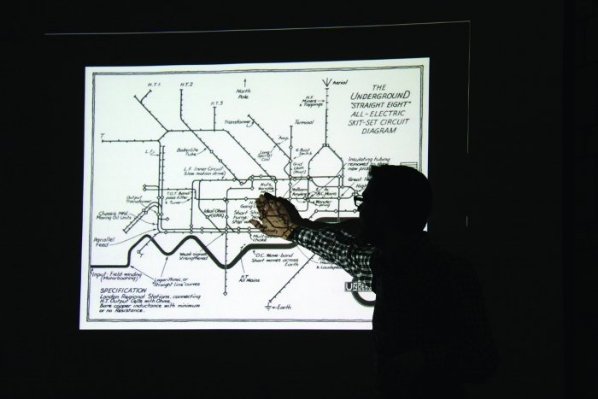
Signal : Noise, in part, played out like a small conference, mainly set in The Showroom Gallery space with one wall covered with a network diagram drawing by Stephen Willats, and fly posted theoretical systems diagrams from his recently re-published 1973 book, or maybe manual, ‘The Artist as Instigator of Changes in Social Cognition and Behaviour’.
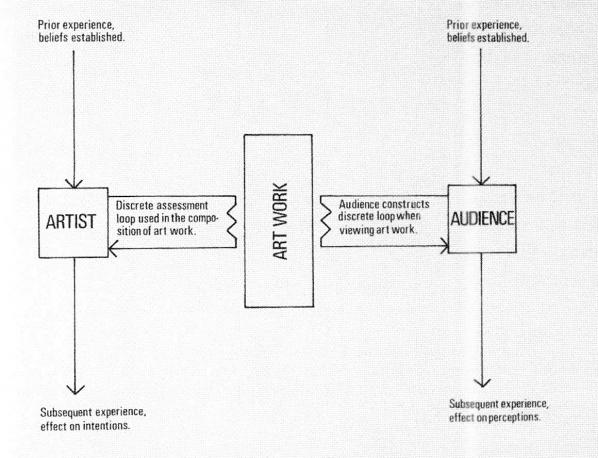
This visual reference served as a backdrop to the proceedings and served as an on going reminder that despite the deep theoretical and historical base being presented and discussed in its many forms, Signal : Noise was ultimately attempting to re ignite debates, and help reset the ideas of cybernetics and systems into a contemporary context of practical application. Willats’ book describes his process as an ‘investigation by the artist into the processes, procedures and models’ of the ‘Art Environment’ using ‘cybernetics as a research tool’.
The first night introductory presentations by Charlie Gere and Steve Rushton provided an overview of many ideas explored throughout the weekend. Artist and writer Steve Rushton on ‘How Media Masters Reality’ used an array of examples, from conceptual and media architecture group Ant Farm using pioneering ideas of investigating media feedback, through to the 500 millions votes (!) on US TV programme American Idol; the latter an example of how contemporary applications of media feedback loops are now often conceptually embedded into the core of television productions, and in turn, are now part of the audiences expectations and involvement.
Ant Farm’s 1975 work ‘The Eternal Frame’, screened later during the weekend, along with Gary Hill’s Why Do Things Always Get in a Muddle (Come on Petunia), based on Gregory Bateson’s Metalogues.
Ant Farm’s 1975 work ‘The Eternal Frame’, screened later during the weekend, was their carefully staged, somewhat trashy live ‘re enactment’ of the 8mm film footage of the Kennedy assassination, complete with a drag version of Jackie Kennedy and sunglass wearing suited security. This film sequence is familiar today, but in 1975 it had yet to reach the public domain. Working to a tightly choreographed moment derived from a bootleg of the 29 seconds of 8mm film, Ant Farm’s grotesque mimicry of the assassination was performed as an ongoing loop, complete with car driving around the block (interestingly, the random people watching in the street in 1975 took photographs like they were at a theme park).
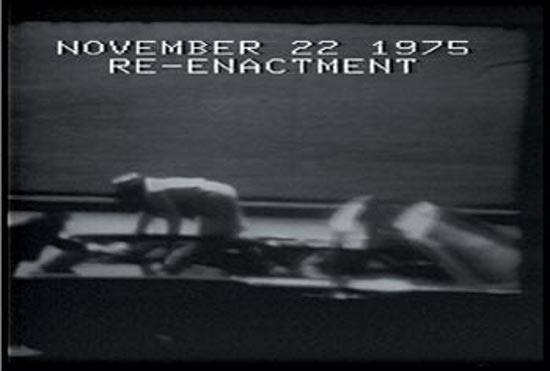

Despite being conceived in the mid ‘70s media environment of portable video and cassettes, the documentation of Ant Farm’s performance resonated with something surprisingly familiar and contemporary in our era of the internet, social media and rolling 24 hour news, and what Rushton termed our “society of self performance”.
Rushton’s historical threads from the origins of Cybernetics and to the Whole Earth Catalogue and the WELL served as a excellent base for the oncoming proceedings of the weekend, and showed that the arrival of the contemporary mass information network in the form of the internet, has habituated it’s millions of users into a kind of cybernetic practice based on input, observation, control, intervention, response, feedback, and adaptation but without necessarily using or being aware of its lexicon.
Nearby, in the Cockpit Theatre, was ‘Closed Circuit’ a performative work by Rod Dickinson (along with Rushton), which consisted of two actors staged and dressed, in a precise duplication of a set for political announcements; wooden lecterns, curtained background, complete with an array of flags – but all carefully neutralized by the removal of logos and national flags identities into plain white.
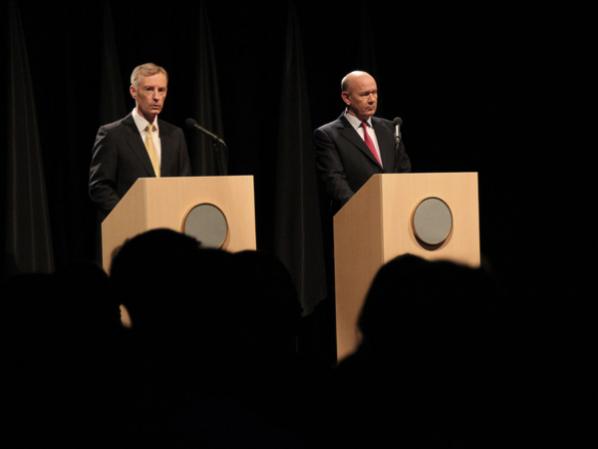
What followed was a series of political speeches utilizing the familiar language and tone of grandeur and crisis, delivered by the actors in the style of a world leader address. What they delivered, was a carefully sequenced remixed script derived from political speeches over the past 50 years; Margaret Thatcher; Richard Nixon; Ronald Reagan; Tony Blair; Yasser Arafat and others. All the details from each specific event they were referring to had been carefully edited out. The only way to differentiate one world leader, country or event from another, were the large projected auto cues for the actors, situated behind the audience at the rear of the theatre. Each one gave the full scrolling speech text and also the year and original context for each leaders’ delivery. Looking towards the stage, it sounded like a single coherent speech, but eluding any specific meaning, isolating the language of threat and authoritarian political control, leaving us just the husk of political presentation and the transparency of the format itself.
Ideas explored in Stephen Willats’ network drawing were expanded further during his talk in the final morning session of Signal : Noise, where he gave a refreshing clarion call to abandon ‘last century thinking’ during his prescient and timely discussion. His seminal works have persistently and methodically challenged the process, structure and meaning of art making and display. Willats made his earliest system diagrams in the late 1950’s, and was the first artist to make the artwork itself a map of communication. But maybe it is this century, rather than our last, that will connect with his provocations to the hierarchical, highly codified, object obsessed ‘Art Environment’, as he terms it, to see that ‘object based thinking is still a hangover from last century attitudes’.
Willats was an early reference for emerging net art and media art in the mid 90’s, with artists then clutching for any art historical roots that gave the field of networked and computer based practice some practical grounding.
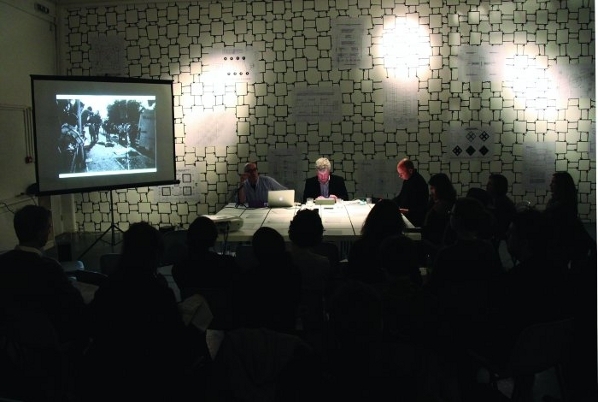
This in-conversation with Emily Pethick surveyed his own personal development and immersion in Cybernetics in its differing stages, a short history lesson, moving from Norbert Weiner to Gregory Bateson and Gordon Pask, but always resolutely en route to the practical issues in the present and what Willats defines as the artist as an ‘instigator of transformation’.
In parallel to Willats, was a presentation and discussion hosted by Emma Smith and Sophie Hope which began to interrogate the legacy of a the New Labour arts commissioning process. It discussed how the criteria for successful funding was intrinsically linked to a social agenda, audience and location set by government policy. Discussions followed about how the arts commissioning process may turn out to have skewed a generation of artists practice, as they slowly lost control of their own output, became tagged with being an ‘artist facilitator’, and began conceiving works to fit in with the criteria of funding bodies, with each funder slowly extending their own prospective reaches. All this supported by an immense drive to build ‘Cultural Industries’ into mechanisms for regeneration.
Seeing this placed against Willats, whose ongoing practice could initially seem in tune with the past decades cultural policies and its overtly prescribed socially engaged agenda, in fact served to show how contrasting, distinct and rich his rigourous thoughtful approach is by comparison.
All this made for a timely discussion. With the approaching withdrawal and decimation of arts funding in the UK, Signal : Noise could prove to be a prescient event. With presentations, workshops and panels by Stuart Bailey and David Reinfurt of Dexter Sinister, Charlie Gere, Matthew Fuller, Marina Vishmidt and others, the interdisciplinary approach of Signal : Noise worked well despite its fairly dense timetable.
Using the gallery as a discursive space, with theorists and writers set within context of practice, is a good base for the next event in this on going series. What it maybe didn’t allow for, which is easily rectified, is a more unpredictable agenda, and more intervention by the ‘audience’. The whole event could function more as a real feedback working system, an adaptable structure that potentially allows for input from its participants (both presenters and audience) letting things move in unexpected directions both on line and offline, leaving a physicalised network as a residue after the event. With the decision to include food and beer in the ticket price (great dumplings, fresh vegetables and miso soup), there is potential here to expand this type of event even further.
With the on coming cultural landscape in the UK moving into un-chartered territory, it is potentially events like Signal : Noise which might begin to unearth and test new ideas and ignite debate within a less rigid format than a ‘curated’ show. In the future this type of event may even re-claim the word ‘radicalise’ from its current narrow, negative media usage, and re-purpose it for artists who decide to reject art market values, in favour of a exploring new ways of working within the emerging (and significantly less funded) ‘Art Environment’.
Signal : Noise. The project was led by Steve Rushton, Dexter Sinister (David Reinfurt and Stuart Bailey), Marina Vishmidt, Rod Dickinson and Emily Pethick. http://www.theshowroom.org/research.html?id=161&mi=254
The Artist as an Instigator of Changes in Social Cognition and Behaviour. 1973. Stephen Willats. http://www.occasionalpapers.org/?page_id=825
Closed Circuit, Rod Dickinson in collaboration with Steve Rushton.
http://www.roddickinson.net/pages/closedcircuit/project-synopsis.php
Dr Charlie Gere. Reader in New Media Research. Department: Lancaster Institute for the Contemporary Arts. http://www.lancs.ac.uk/fass/faculty/profiles/charlie-gere
ANT FARM. ART/ARCHTECTURE/MEDIA [1968-1978]. http://artsites.ucsc.edu/faculty/lord/AntFarm.html
The Eternal Frame by T.R. Uthco and Ant Farm: Doug Hall, Chip Lord, Doug Michels, Jody Procter. 1975, 23:50 min, b&w and color, sound. http://arttorrents.blogspot.com/2008/02/ant-farm-eternal-frame-1976.html
Emma Smith. Social practice that is both research and production based and responds to site-specific issues. http://www.emma-smith.com/www.emma-smith.com/Homeindex.ext.html
Sophie Hope’s work inspects the uncertain relationships between art and society. http://www.welcomebb.org.uk/aboutSophie.html
20 Digital Years Plus
Station Rose
Nurnberg 2010
ISBN 9783869841113
“Twenty Digital Years Plus” is a softback book that presents and contextualises the art of Station Rose (Elisa Rose and Gary Danner) from 1988 to the present. Its gatefold cover conceals both a CD and a DVD which provide audio and video to complement the static images and texts, and carries an endorsement from Bruce Sterling on the back cover.
The book starts with a series of essays before presenting an illustrated history of Station Rose. Those essays approach Station Rose from some refreshing and unexpected angles to make a convincing claim for their art historical interest.
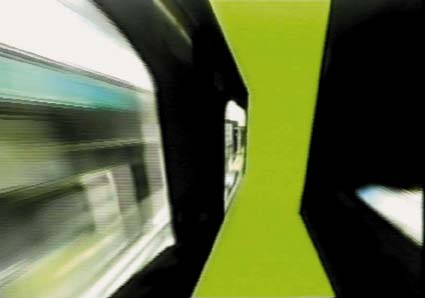
Peter Noever writes in the book’s preface that “Media art is both an art form and a way of life for Station Rose”, a claim that the evidence of the book more than supports and that I think is key to why Station Rose’s art is so interesting. The book functions as a mid-career retrospective, and Noever suitably sets the themes of achievement and continuity.
Vitus H. Weh’s essay explains how Station Rose got their name and puts their LoginCabin project into the context of German post-cold-war architecture and the sociology of the Wild West. We are a long way from the early 90s view of the Internet as a new frontier, but despite its critics that view was not uniquely tied to American society and provided a liberating impetus to individuals who didn’t always subscribe to the Californian Ideology.
Hans Diebner’s critique of net art and activism brings a thought-provoking scientific, techno-art historical and philosophical critical literacy to bear on Station Rose and the artists and activists that he contrasts them with. Diebner weaves together diverse conceptual strands into a coherent critical case without any resort to jargon, and it’s worth thinking through how his case affects our view of net art in general as well as Station Rose’s position within its history.
Didi Neidhart’s interview with Rose and Danner provides context for and insights into how the pair create and conceptualise their work, and how their art and music relate. Station Rose emerge as the product of cultural engagement and lived history rather than academic fashion.
Gabriel Horn writes from a curator’s point of view about the future shock of working with Station Rose in 1991, in contrast to working with them in 1999 when they are part of an intermedia exhibition.
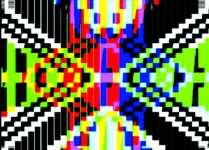
The bulk of the book is an illustrated history of Station Rose. They started out in 1988 as a multimedia lab in Vienna complete with 16-bit Amiga computer. In November 1988 they went online for the first time at the Sampling conference they held in Vienna, having already adopted the technology and concepts of sampling into their art and performance. Since then their work has taken the form of CD-ROMs, live streaming media, live multimedia performance, Internet homepages, CDs and vinyl with Sony records, books, TV shows, multimedia installation, webcasting, lecturing, teaching, and a shed.
Station Rose also create memes, or language, such as the statement quoted by Bruce Sterling on the back cover that “Cyberspace is Our Land”, the much needed identification of the “Digital Bohemian Lifestyle” and the increasingly paradigmatic condition of being “private://public”. Even in an age when the concept of multimedia has largely been absorbed by the Internet their work crosses and assembles different media.
Much of Station Rose’s digital art has the not quite glitch aesthetic of overlayed pixellated form in shallow depth that any serious history of digital art needs to account for. But the cubicles, huts, pillows and panels of their installation work have the same aesthetic. Station Rose’s work is in itself a history of digital art over the last two decades. And this digital art is always in dialogue with physical performance and physical structures, the virtual in dialog with the real to illuminate each other.
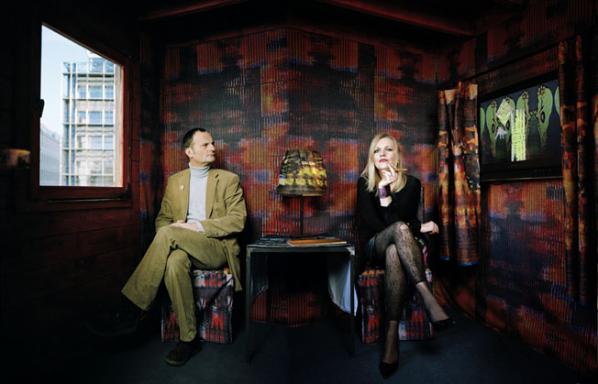
In Neidhardt’s interview, Danner says of Station Rose that “We are quickly bored with things as soon as they become mainstream.” Boredom with the content and products of digital media is the friend of the scheduled obsolescence and cultural amnesia of market mass media. But boredom with the form of and the means of creating digital media can also serve to motivate the creation of successive alternatives to it.
Over the last 20 years the Internet and digital media have gone from being a novelty to being socially and economically pervasive. This rate of change, and the constant promotion of different visions of what the Internet is for by different institutions, mean that our relationship with the Internet has come to be in plain sight. Artists can usefully depict and help us conceptualise that relationship, particularly those artists who can use the digital media that has been drawn into the Internet and become no small part of its operation.
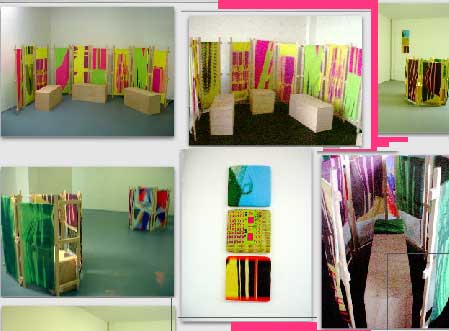
Station Rose are such artists. Their art has the quality of being both the product and producer of lived experience in the age of digital media. It refracts the logistics and glitches of the Internet through the prism of contemporary art’s deceptively low-fi rummage sale aesthetics to present them as objects of contemplation. When digital media was new this served to make them accessible to an unfamiliar public. Now that digital media are pervasive to the point of invisibility, this serves to make them visible again as objects of contemplation and to afford the viewer a critical distance from them.
20 Digital Years Plus is an engrossing, thought-provoking presentation of the ongoing development of Station Rose that makes clear the value of their constantly enquiring relationship to ever changing technology.
(With thanks to @MarkRHancock)
The text of this review is licenced under the Creative Commons BY-SA 3.0 Licence.
Featured image: Games/03 Paul Sermon, Peace Games, © der Künstler 2008.
Das Spiel und Seine Grenzen: Passagen des Spiels II ed. Mathias Fuchs and Ernst Strouhal, (Springer Verlag, 2010), German language only.
Fuchs, Mathias; Strouhal, Ernst (Hrsg.)
1st Edition., 2010, 272 S. 16 Abb., Softcover
ISBN: 978-3-7091-0084-4
Versandfertig innerhalb von 3 Tagen
Mathias Fuchs is considered to be one of the first artists to explore the combination of videogames and art. Today he is a senior lecture at Salford University in England and a leading researcher on Game Art and ludic interfaces. Social and political context in videogames and how they affect our society has been a major topic in Fuch’s research. Last year he published, together with Ernst Strouhal, an anthology of videogames and its borders and how this genre is changing and influencing society. The background to the anthology was an exhibition held at Kunsthalle Wien in 2008 about art and politics in videogames.
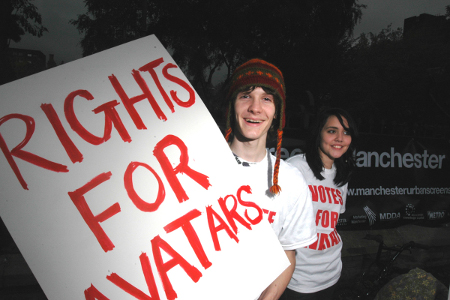
It has been 60 years since Johan Huizinga’s now classic book Homo Ludens, the playing human, was published. Games are no longer just entertainment; it’s a major industry that is affecting our society in every aspect. In the foreword Fuchs states that the main issue for the 15 essays in the anthology is how games have changed and affected our society both politically and socially since they crossed over from the realms of entertainment into everyday experience.
Today we can find many different genres in videogames, such as serious games and persuasive games, that discuss current issues, news and social problems, artistic games which address existential and aesthetic aspects, and so on. The gaming community has grown enormously and created on-line worlds with strong virtual economics, attached real world economics. In her essay Daphne Dragona says “The virtual environments of our times therefore can be seen as social institutions with social, political and economic values resembling those of real life.”
In a similar way Tapio Mäkelä’s essay about locative games describes how the gamescene has entered the real world in the form of cos-players and social gameplays where videogames as Pacman are performed in the city streets or games as “/Noderunner/, where participants run to find open WiFi Networks, take a photo of themselves at the location and send the info via e-mail to the project’s website.” This begins to close the gap between networks and everyday experience through the practice of social gaming. The game as object is less of an obvious conclusion now that technology enables us to explore ourselves within networked, gaming contexts and mobile technologies.
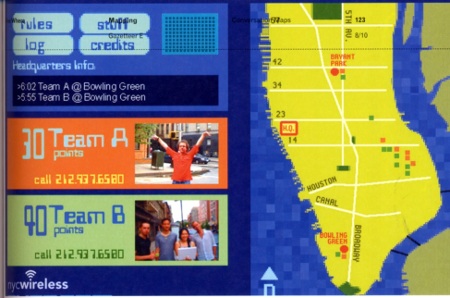
The borders between game and reality have now become even more blurred and integrated, especially if we consider how technology itself also crosses over into administrational activites which have already been traditional elements of controlling, processing parts of our lives. One example is how authorities around the world are supervising these new socio-economics, such as collecting taxes from virtual incomes by using similar tools and networks. There are many questions about how games will continue to affect and change our society in the future and the anthology takes an interesting and comprehensive look into what games have to offer and what could be potential threats to our future societies.
Today games are serious business. It is not impossible that in the future a bankruptcy of an on-line gameworld could shake the real world and create an economic depression. On the other hand, could on-line game economies bring prosperity and create new jobs, an economic boom in ways we have not witnessed before? If games move into a new period of changing social experience in even more connected ways than before, then we need to understand what the consequences of these are and how to navigate through this shifting terrain. One thing is for sure, it was a long time ago that games were just entertainment.
http://www.springer.com/new+%26+forthcoming+titles+%28default%29/book/978-3-7091-0084-4
Brian Eno hovered over me in a darkened room as I squatted writing notes about his 77 Million Paintings on a crumpled up piece of paper. Though I knew he couldn’t see what I was scribbling, its not often one gets the chance to come face-to-face, or rather back-to-face in situ with the flesh and blood incarnation of one’s investigations. He had slipped into the viewing room at the Glenbow Museum unobtrusively because he likes to watch – the audience as well as his “paintings,” and therein lays his strategy and appeal. In a lecture he gave that night at the Museum auditorium he described, in magnificent pantomime, the reactions one has when entering the viewing space of his exhibit:
looking around, furtively glancing at the work
walking further into the space, looking around, glancing at the work
leaning against the wall, glancing at the work
squatting, glancing at the work
sitting down, glancing at the work
focusing on the work, lying down on the floor mesmerized by the work
unable to tear oneself away from the work
77 Million Paintings contains 550 paintings Eno created over a span of 22 years. Since 2006 the exhibit has toured all over the world including Tokyo, Sydney and St. Petersburg before landing in Calgary. The digital projection is a “generative” work in that the ambient music for which Eno is better known, and the combination of images are generated and combined in an endless mandala-like array by a computer. Nine screens project a diamond shape with eight inserted “paintings” and one solid colored square on the lower right hand side serves as a control for the other eight. There are four black leather couches for people to zone out on while enveloped by his signature ambient sounds – and they are packed to capacity as the audience warms and hunkers down to the slow experience.
Originally conceived for in-home viewing, the show seems to change your brain waves from Alpha to Beta to Theta and the experience is pure occipital enjoyment. The cross-fades in the banks of images creep up as the landscape subtly changes as blue morphs into green, and triangles expand into circles As Eno says, “We’re not seeing a film. There’s no beginning, there’s no progression, there’s no end, there’s no narrative, there’s no drama. In fact everything is missing that would normally be called art or entertainment.”
Eno’s lecture at the Glenbow Auditorium could have continued all night but for the protestations of those with day jobs. He began explaining the radical impact Copernicus had in 1543 when he revealed man was no longer the center of the universe, as earth orbited around a system with some 400 million stars. Darwin came along in 1859, and pointed to the phylogenic tree stating there were 20 billion species besides humans. “ We are amazingly minute in this picture,” Eno mused. After Darwin it was Cybernetics, which introduced the notion of feedback as a way to think about complex systems. We cannot control these systems, only set them up to control themselves, and that notion became part of his vocabulary of how things organize themselves.
Starting with royal Kings and the Church, man organized himself in hierarchies from the top down that includes the structure of the 18th Century orchestra, still extant today. Sixty or seventy years ago this would show up in the shape of a top-down pyramid, but the world now functions more as a feedback loop, not a hierarchy. Eno explained when he was growing up his uncle slipped him a book on the artist Mondrian. He found the pictures magical, economical, and transparent. They contained “no subterfuge of technique.” Attending art school at Winchester School of Art, part of a music school in England, his forward thinking art professors invited the composers John Cage, Christian Wolf and Morton Feldman to lecture. Not one musician or music student on campus came to hear them.
He described listening to Terry Riley’s minimalist music composition In C,as “life changing.” That piece contains 53 short, numbered musical phrases lasting from half a beat to 32 beats repeated an arbitrary number of times. He also mentioned Steve Reich’s It’s Gonna Rain, where Reich recorded Brother William, a Pentecostal preacher and “sought to maintain the fascination of the speech content while intensifying its meaning and melody through rhythm.” This piece Eno admitted, “is the basis of most of my career.” He said one’s ears function differently than one’s eyes. Eyes scan all the time. If they don’t scan, they habituate and don’t see any thing. If you have a repetitive event the eyes cease to see, and what he focuses on is the uncommon information, “the out of phase collision of the loops.” This approach makes your brain do the composing. As this he says, has led him to his work ethos, “doing as much as I can with as little as possible.”
—-
Brian Eno’s exhibition 77 Million Paintings takes place in the Glenbow Museum from January 6 to March 20 2011. http://www.glenbow.org/exhibitions/
Furtherfield is pleased to present the UK Book launch of STATION ROSE: 20 Digital Years Plus, published by Verlag für Moderne Kunst Nürnberg.
DR. Richard Barbrook will give a short introduction to the evening.
The Digital Art of Station Rose started in Vienna in 1988, at a time when the Web still was far beyond mainstream, when Mondo 2000 never had heard about the music genre “Techno”, when future net-art-critics still mostly were university students, and when the Iron Curtain was surrounding Austria´s east, south east and north border.
“Station Rose had every right to claim ‘cyberspace is our land.’ They were there very early, they raised their antennas and put down deep roots, and they never left.” – Bruce Sterling, 2010
Station Rose, pioneers of digital culture, have produced an artist’s book which delivers a current description of the situation of media art from 1988, when the studio was founded, until 2010. Station Rose (Elisa Rose and Gary Danner) are considered to be innovators and visionaries in the field of audiovisual art, electronic music, net art and audiovisual live performance. The book features audio-visual works, performances, installations and Web 2.0 activities and linkings. Part of the book is dedicated to the media sculpture LoginCabin exhibited for three months in 2009 in the MAK in Vienna.
The latest art of Station Rose refracts the logistics and glitches of the Internet through the deceptively low-fi aesthetic of contemporary art’s installations and performances. “Twenty Digital Years Plus” shows how this fits into their history of using the viruses of visual, verbal and computer language to find insightful ways of conceptualising digital culture.
RSVP – Please contact Ale Scapin
http://www.stationrose.com/STR-Books/20DYplus-book.html
http://www.furtherfield.org/contact
Station Rose 20 Digital Years plus. 1988–2010 –>
paperbook with flaps 16,5 x 22 cm
192 pages., german/engl.
Euro 40,00/sFr 64,00
ISBN 978-3-86984-111-3
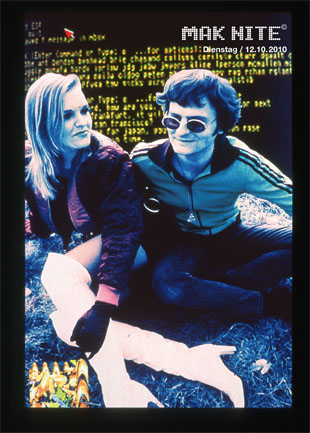
Peter Noever (preface), Howard Rheingold, Bruce Sterling, Gabriele Horn, Vitus H.Weh, Didi Neidhart, Peter Weibel, Dr.Hans Diebner, Christoph Tannert, David Hudson, Terence McKenna, Elisabeth Zimmermann, Doug Millison, Dr.Timothy Leary, Elisa Rose, STR, u. a.
Österreichisches Kulturforum Berlin, Stadt Frankfurt am Main – Dezernat für Kultur und Wissenschaft, BMUKK Wien, Hessisches Ministerium für Wissenschaft und Kunst, Kultur Land Oberösterreich.
Distributed in the United Kingdom
Cornerhouse Publications
70 Oxford Street, Manchester M1 5 NH, UK
phone +44-161-200 15 04, fax +44-161-200 15 04
Distributed outside Europe
D.A.P. Distributed Art Publishers, Inc.
155 Sixth Avenue, 2nd Floor, New York, NY 10013, USA
phone +1-212-627 19 99, fax +1-212-627 94 84
Private View: Friday 25 February, 6.30-9 pm with Live Performance by Garrett Lynch
Special guests on the night: Dr Richard Barbrook, Andy Cameron, Garrett Lynch, Quayola, and Eleonora Oreggia, aka XNAME.
REFF- Remix the World, Reinvent Reality! from Furtherfield on Vimeo.
Directly from Italy, Art is Open Source, and FakePress presents REFF a Fake Cultural Institution to launch, promote and distribute its Augmented Reality (AR) Drug to reinvent reality. Visit the exhibition to discover the effects of three innovative molecules created by the REFF chemical lab: REMIXine, REINVENTum, and REALITene.
REMIXINE
The REMIXine compound is an innovative molecule that forms a fundamental ingredient in all our drugs. The molecule powerfully reacts with others, disconnecting their predetermined bonds and allowing the core elements of other compounds to reassemble, forming entirely new ones in complete freedom. REMIXine augments the total entropy of systems, and it is a known stimulator of creative processes acting for the systematic creation of insights into the world.
REINVENTUM
REINVENTum compounds collaborate with the other molecules found in our drugs to reassemble components into new forms once their bonds have been disassembled. REINVENTum affects the equilibrium of neural ecosystems, as it can effectively activate the neurotransmitters which control human forms of expression: this action has profound impacts on the areas of the brain that engage language and memory, allowing the rapid formation of entire networks of new symbols.
REALITene
REALITene is an unstable compound. Its complex molecule self-arranges into virtually infinite configurations. Furthermore, different patients have been known to react to different molecule configurations at different times in their clinical life.
Also, explore MACME, the new open publishing tool at the exhibition, encounter the artworks and performances, and enjoy the freedom of access and expression. In other words…take the REFF AR Drug.
This exhibition showcases a live glitch performance, an urban intervention and a virtual entity by artists featured in the new REFF book: Garrett Lynch (Ir), Rebar Group (US) and xname (It) alongside a real-time interactive map that describes the life of REFF all over the world: 60 authors, artists, designers, architects, hackers, journalists, activists; dozens of actions; a live and real-time stream of information collectively produced by a worldwide community of re-inventors.
The REFF map on the exhibition is available online from the opening date: http://reff.romaeuropa.org. The mapping process is open: please contact us if you feel that your actions are reinventing reality and, thus, should be added to the visualization.
For more about Art is Open Source and Fake Press
www.romaeuropa.org
www.fakepress.it
www.artisopensource.net
Trav–erse – Live performance by Garrett Lynch
Exploring radio waves on a world band analogue radio, the performance should be perceived as both a linear and non-linear journey progressively moving through the sonic space of broadcast wireless networks and the physical geographies and cultural spaces they both represent and permeate.
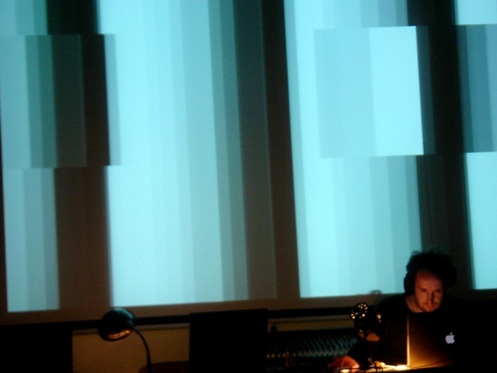
The performance traverses and returns across a radio band, a technological interface, along linear trajectories. Sounds with no correlation between their representation on this band and their ‘actual’ location will be captured, layered, reworked, and transformed within new media to create a cultural and social sonic dérive where all spaces exist simultaneously.
Garrett Lynch (IRL) is an artist, lecturer, curator and theorist. His work deals with networks (in their most open sense) within an artistic context; the spaces between the artist, artworks and audience as a means, site and context for artistic initiation, creation and discourse. Recently most active in live performance, Garrett’s practice covers net.art, installation, performance and writing.
PARKcycle by Rebar Group
The PARKcycle is a human-powered open space distribution system designed for agile movement within the existing auto-centric urban infrastructure.
While its physical dimensions synchronize with the automotive “softscape” of lane stripes and metered stalls, the PARKcycle effectively re-programs the urban hardscape by delivering massive quantities of green open space—up to 4,320 square foot minutes of park per stop—thus temporarily reframing the right-of-way as green space, not just a car space.
Using a plug-and-play approach, the PARKcycle provides open space benefits to neighbourhoods that need it, when they need it, as soon as it is parked.
Built-in collaboration with the kinetic sculptor Ruben Margolin at his studio in Emeryville, California, the PARKcycle made its debut on PARK(ing) Day 2007 in San Francisco.
PARKcycle was made possible by a grant from the Black Rock Arts Foundation.

REBAR is an interdisciplinary art and design studio based in San Francisco. Rebar has created public art interventions and design projects around the globe. Rebar remixes the ordinary repurposes the ubiquitous, and restructures the fabric of the urban environment by exposing hidden assumptions and shared meanings embedded in the everyday experience of the built world.
Virtual Entity by XNAME
Virtual Entity is a research project and net-art work trying to redefine the concepts of authenticity, ownership, uniqueness and seriality within the digital domain. The practical aspect of this speculation is a simple application developed to create (and edit) the soul of a file. This is a metaphor: the soul, a text-based soul, is the place where it is written who or what a certain entity is; it is a mark for preserving identity.
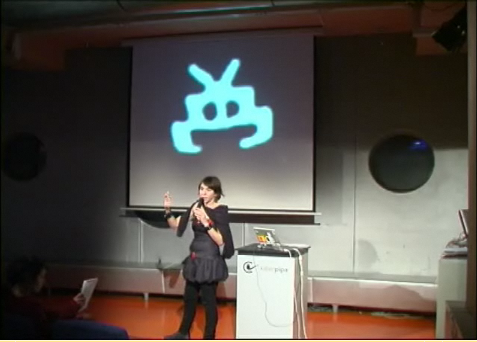
This software, proposing a single answer to the questions raised by the practices of licensing and cataloguing digital files, is transforming the traditional approach towards metadata and digital property. The main idea is that any file is an independent creation living its own life and experiencing various levels of transformation and progressive generation (of meaning, shape, and entities) in the course of its virtual existence. The main focus points are the relations (semantic or genetic) among files and the processes of fragmentation, multiplication and transmutation of the cultural units composing them.
Virtual Entity constructs in parallel a theoretical mythical world and its functional technical counterpart; its ultimate shape (and visualization) is that of a monster, a bodyless entity composed of souls and formed by the structure of their relations – and the history of digital data starts drawing itself.
Virtual Entity is displayed for the first time as an installation at Furtherfield Gallery in London. The work takes the form of a tryptic. The central projection shows the command line application soul, the left monitor displays the web application souls, while the right monitor displays the virtual entity monster, a real-time representation of the database performed by live coding software Fluxus.
Virtual Entity Alpha is prototype software. Its main new features are URL support, macosx install, web application, Fluxus visualisation. This software was designed by xname and coded by xname, megabug, Antonios Galanopoulos and Gabor Papp.
Events at Furtherfield Gallery
Opening event: 25 February 2011, 6.30-9pm
Live Performance by Garrett Lynch at 7.30pm
Special programme by REFF the Fake Institution
Open call to Remix the World! Reinvent Reality
The REFF map on the exhibition is available online from the opening date: http://reff.romaeuropa.org. The mapping process is open: please contact us if you feel that your actions are reinventing reality and, thus, should be added to the visualization. http://www.furtherfield.org/contact
REFF Youth Programme
A special task force was required to ensure the immediate diffusion of the REFF AR Drug to the younger generations. Perhaps surprisingly, the Fake Institution agenda has inspired approval and enthusiasm in the academic world. In the two weeks before the exhibition FakePress, together with Art is Open Source, is running a series of workshops and presentations across universities and to groups of students in and around London to remix the world: Southbank University, Goldsmiths, Writtle College, University of Westminster, Queen Mary University.
Please contact us if you’d like to participate or organise further workshops/presentations http://www.furtherfield.org/contact
More information about student workshops.
Please visit AOS website to learn more about what happened during the REFF workshops
MACME, an open source tool for cross-medial publishing
Created by FakePress, MACME is new a cross-media, multi-author content management system, that enables the creation of multi-device and paper publications, featuring location- based technologies, QR-codes, and augmented reality .
The platform will be released for the first time during the days of the exhibition, under a GPL3 Licence, as a real policy for access promoted by the REFF.
Student movements in Italy/UK
”The use of communication technologies and invasive practices for reinvention reality is crucial for student movements in this difficult moment. We would like to get the students involved in the REFF experiments by providing access to those technologies that can work as effective forms of critical and alternative communication. Students in the UK and in Italy will have access to all the cross-medial CMS used to build the REFF book, which will enable them to create their own QRCodes and Fiducial markers that they can then stick around the city to disseminate information integrated within their communication across the web and the city.” – Art is Open Source.
During the exhibition run, students will also be invited to curate their own event in which they can present their take on the idea of “reinvention of reality”, and connect with the students’ movements in other countries (using Skype at Furtherfield, at the ESC in Rome and at the Cantiere in Milan) presenting themselves to each other. The event will terminate with an urban performance in which each party exchanges and prints QRCodes stickers that are then disseminated across the city.
More about Art is Open Source
AOS operates interdisciplinarily across universities and research institutes, businesses and associations, critical collectives and extreme practitioners in arts and design, promoting innovative approaches to the environment, to (multi)cultural interaction, and to the creation of real, sustainable and socially responsible opportunities.
More about REFF
REFF started by investigating themes around intellectual property and cultural policies and then expanded to the domains of freedom of expression and the idea that the tactical use of technologies and network-oriented practices can enable people to change the rules of the game and reinvent our reality. Taking inspiration from street arts, raves, skateboarding, and technologies allow us to re-code and write onto the world, creating layers of additional reality that express our own interpretation of the cities we live in, of the things we buy and use every day.
One project outcome is a book published in 2010, which will soon be available in English. The book is a cross-medial publication enacting the theories investigated by FakePress (a next-step publishing house created by AOS in 2009 researching the REFF themes through the idea of reinventing publishing itself): it is simultaneously a book; a location-based, augmented reality application; a living digital ecosystem; and a wide tagging mechanism using QRCodes and Fiducial Markers to disseminate content and interactions on objects, architectures and spaces.
The book was created using a series of technological tools to maximise accessibility to these critical tactical technologies. The tools have been arranged into a platform called MACME (Multi Author Cross Medial Ecosystem) that has just been released under a GPL3 licensing scheme. The release of these and further technologies is an integral part of the work of net.art, which informs the REFF project.
For more information:
http://www.artisopensource.net
http://www.romaeuropa.org/
http://www.fakepress.it/
Editors Ruth Catlow, Marc Garrett, Corrado Morgana.
Digital games are important not only because of their cultural ubiquity or their sales figures but for what they can offer as a space for creative practice. Games are significant for what they embody; human computer interface, notions of agency, sociality, visualisation, cybernetics, representation, embodiment, activism, narrative and play. These and a whole host of other issues are significant not only to the game designer but also present in the work of the artist that thinks and rethinks games. Re-appropriated for activism, activation, commentary and critique within games and culture, artists have responded vigorously.
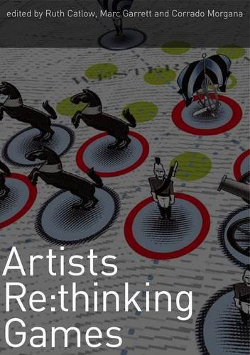
Over the last decade artists have taken the engines and culture of digital games as their tools and materials. In doing so their work has connected with hacker mentalities and a culture of critical mash-up, recalling Situationist practices of the 1950s and 60s and challenging and overturning expected practice.
This publication looks at how a selection of leading artists, designers and commentators have challenged the norms and expectations of both game and art worlds with both criticality and popular appeal. It explores themes adopted by the artist that thinks and rethinks games and includes essays, interviews and artists’ projects from Jeremy Bailey, Ruth Catlow, Heather Corcoran, Daphne Dragona, Mary Flanagan, Mathias Fuchs, Alex Galloway, Marc Garrett, Corrado Morgana, Anne-Marie Schleiner, David Surman, Tale of Tales, Bill Viola, and Emma Westecott.
In collaboration with FACT – http://www.fact.co.uk
http://www.furtherfield.org
http://www.http.uk.net/
Publisher: Liverpool University Press (31 Mar 2010)
Language English
ISBN-10: 1846312477
ISBN-13: 978-1846312472
http://www.amazon.co.uk/gp/offer-listing/1846312477
A performance by Alexandre Burton and Julien Roy
Alberta College of Art and Design (ACAD), Calgary, Canada, November 11, 2010
“We are absorbed by the beauty of electronics absorbing into the air,” is how Burton and Roy described their literally electrifying, and often frightening forty-five minute audiovisual performance of high-voltage electromagnetic disturbances. The event necessitated everyone present turning off their cell phones, i-whatever’s, and cameras to avoid provoking 800,000 volts of raw Frankenstein-like crackling electricity from throwing out a surprise lightening bolt and zapping an unsuspecting audience member.
POWEr’s instrument is an audio-modulated Tesla Coil with its own “boutique” ground that resembles a stripped down tuba with lots of copper colored coils. A bent over piece of metal culls the tail end of the generated electricity so it can be captured by a high-speed camera, and processed and re-purposed. Both Burton and Roy, who trained in contemporary classical music training in composition and electro-acoustics at the University of Montreal added, “We like noise so we try not to do melody, except at the end.”
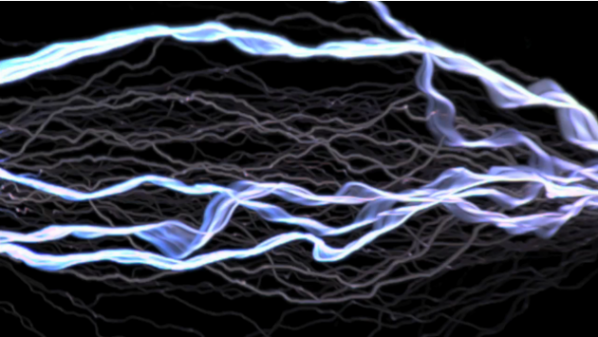
The piece is raw and alive, and no photograph or video can substitute for sitting in the line of fire of a sparking raw electrical feed. It smells tangy and metallic; a by-product of its ozone inducing properties and you can practically taste the microscopic particulate matter its hybrid frisson generates on your tongue. The sheer shock of its taser-like impact up close and personal is mesmerizing and anesthetizing but its actual menace doesn’t lie in its extreme voltage, but in its electrical amps, which is the charge that actually goes through you. “If the amp is low it just goes onto your skin, but if the amp is high you can die,” the artists sanguinely informed the audience in a Q & A after the performance. They also explained it took six months to come up with the idea, and another six months to make he piece not explode.
The creator’s studio site Artificiel.org says they are interested in “the desubjectification of sound and image materials, R&D creativity as the consequence of artistic research and the building of a genuine digital performance practice.” This idea is coupled with an astute technical know-how. To capture such an electrifying event the camera runs in a special “forever mode” that can be wiped clean at their discretion. The electromagnetic arc produced by the Tesla coils lasts for just a few very bright nanoseconds, so using a mechanical shutter is impractical. The ISO, dampened down to 50, allows a baseline sensitivity to actually capture the image.

Once captured, the images are transferred to the computer via a high-speed uncompressed connection, where recording, filtering and geometric adjustments are made. The visual data is handled as sound, allowing quick and precise images to be processed on the fly. “It is also a very intuitive approach to “synesthesia,” Burton said as the software abstracts both sound and visuals in the same way. Logic Pro and MAX/MSP/Jitter manipulate duration, signal, timbre, and resonance live time as technology and geekiness combine with a dash of old style showbiz razzle dazzle to produce a truly hair raising show.
(Images above are excerpts from a performance in Québec city 2010)
View video of Alexandre Burton’s and Julien Roy’s live performance here http://vimeo.com/9816953
A Computer in the Art Room: The Origins of British Computer Arts 1950-1980
Catherine Mason
ISBN: 1899163891
JJG Publishing 2008
Computing anywhere else but its history often seems like a carefully guarded secret. This has been alleviated by activity around the resurrected Computer Arts Society in the 2000s, notably the acquisition of CAS’s archives by the V&A and the CaCHE project at Birbeck College which ran from 2002-2005. CaCHE, run by Paul Brown, Charlie Gere, Nick Lambert and Catherine Mason, produced conferences, exhibitions, and publications including the book “A Computer In the Art Room”, by Mason.
The art room of the title is the art department of British educational institutions prior to art becoming a degree-level subject. From the 1950s to the 1970s, when the cost of computing machinery dropped from the level where only major government and corporate organizations could afford them to the level where you only needed a second mortgage to afford one, the best way for artists to get access to the enabling technology of computing machinery was usually in an educational institution.
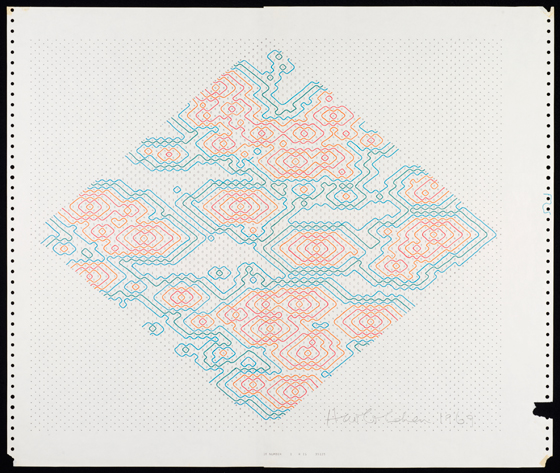
Mason starts out by describing the artistic and art educational situation in the UK at the time of the Festival Of Britain and the foundation of the ICA in London in the early 1950s. She then explains the structure and significance of the emergence of Basic Design teaching, the impact of the Coldstream report on art education, and the rise of the polytechnic colleges over the next thirty years. This provides vital context for the emergence of art computing teaching in the UK. It is also of more general interest for British art history. Conceptualism, performance, Land Art, the Hornsey Art School occupation, and the educational and media graphics that are currently being used as the basis of “hauntological” art all share this background and can better be understood and critiqued with better knowledge of it.
Basic Design courses started in London but didn’t remain there for long. They spread and matured throughout the UK, becoming entangled with the earliest teaching of art computing in provincial technical colleges. Mason traces the family trees of art computing teaching over time through these institutions and back to London-based institutions. Some of the names are familiar from art history (Richard Hamilton, Stephen Willats), some from art computing history (Harold Cohen, John Latham). Where the people involved cross over with cybernetic art, Conceptualism or other artistic currents Mason shows how their ideas fed into and from their art computing work.
The conceptual content of art computing followed the Bauhaus, cybernetics, systems, sociological and environmental influences on art from the 1950s to the 1970s. Its technological forms likewise followed those of mainstream computing. In the 1960s time was leased on mainframes or computers were built by hand. In the 1970s, minicomputers became available and art domain-specific software frameworks or programming languages were written by their users. In the 1980s, workstations with touch tablets, framebuffers, and increasingly proprietary software brought previously unprecedented power and ease of use at the cost of more fixed forms.
The history that I had to piece together as a student from hearsay and from hints in old publications, of the PICASO graphics language at Middlesex University that I found a print-out of the manual for when I was there in the 1990s, of Art & Language’s use of mainframe computers, of early cross-overs between art computing and dance, of cybernetic systems and games that attracted mass audiences before disappearing, is detailed, illustrated and contextualized in page after page of descriptions of hardware, software, institutions, courses and projects. The detail would be overwhelming where it not for Mason’s ability to bring the human and broader cultural aspect of it all to life.
There’s Jasia Reichardt’s Cybernetic Serendipity show at the ICA, Andy Inakhowitz’s Senster robot, John Latham’s dance notation experiments, The Environment Game, and computer graphics drawn with the languages and environments developed in UK art institutions. There’s pictures of the computer systems at the Slade, the RCA, Wimbledon and other art schools that serve as insights into the artists’ studios. There’s the Computer Arts Society, IRAT, APG. And, crucially, there’s the links between them told in a narrative that is coherent while still presenting the breaks and false starts in the story.
The history of “A Computer In The Art Room” reads all too often as brief moments of individuals triumphing against the odds to produce key works of art computing then fading into obscurity, academia or commerce. But any art history that considers a specific context at such a level of detail will look like this. Mason describes works, institutions and artists that deserve broader recognition, although she is under no illusion about how far the road to that recognition may be, citing the example of how long it has taken for photography to be recognized as art in the culturally conservative UK.
The social and pedagogical changes of the period covered by “A Computer In The Art Room” reflect a time of hope and ambition for education in society that made the academy less remote. Mason provides the social, technological and educational context needed to appreciate the very real achievements of art computing that she describes against this backdrop. As a slice of art history this is richly detailed. It touches on subjects far beyond art computing that will help any art student of history better understand the period covered. And it is both a relief and an inspiration to finally have a public record of this important aspect of the history of art computing in the UK.
The text of this review is licenced under the Creative Commons BY-SA 3.0 Licence.
Michel Bauwens is one of the foremost thinkers on the peer-to-peer phenomenon. Belgian-born and currently resident in Chiang-Mai, Thailand, he is founder of the Foundation for P2P Alternatives.
It’s a commonplace now that the peer-to-peer movement opens up new ways of creating relating to others. But you’ve explored the implications of P2P in depth, in particular its social and political dimensions. If I understand right, for you the phenomenon represents a new condition of capitalism, and I’m interested in how that new condition impacts on the development of culture – in art and also architecture and urban form.
As a bit of a background, I’d like to look at what you’ve identified as the simultaneous “immanence” and “transcendence” of P2P: it’s interdependent with capital, but also opposed to it through the basic notion of the Commons. Could you elaborate on this?
With immanence, I mean that peer production is currently co-existing within capitalism and is used and beneficial to capital. Contemporary capitalism could not exist without the input of free social cooperation, and creates a surplus of value that capital can monetize and use in its accumulation processes. This is very similar to coloni, early serfdom, being used by the slave-based Roman Empire and elite, and capitalism used by feudal forces to strengthen their own system.
BUT, equally important is that peer production also has within itself elements that are anti-, non- and post-capitalist. Peer production is based on the abundance logic of digital reproduction, and what is abundant lies outside the market mechanism. It is based on free contributions that lie outside of the labour-capital relationship. It creates a commons that is outside commodification and is based on sharing practices that contradict the neoliberal and neoclassical view of human anthropology. Peer production creates use value directly, which can only be partially monetized in its periphery, contradicting the basic mechanism of capitalism, which is production for exchange value.
So, just as serfdom and capitalism before it, it is a new hyperproductive modality of value creation that has the potential of breaking through the limits of capitalism, and can be the seed form of a new civilisational order.
In fact, it is my thesis that it is precisely because it is necessary for the survival of capitalism, that this new modality will be strengthened, giving it the opportunity to move from emergence to parity level, and eventually lead to a phase transition. So, the Commons can be part of a capitalist world order, but it can also be the core of a new political economy, to which market processes are subsumed.
And how do you see this condition – the relationship to capital – coming to a head?
I have a certain idea about the timing of the potential transition. Today, we are clearly at the point of emergence, but also coinciding with a systemic crisis of capitalism and the end of a Kondratieff wave.
There are two possible scenarios in my mind. The first is that capital successfully integrates the main innovations of peer production on its own terms, and makes it the basis of a new wave of growth, say of a green capitalist wave. This would require a successful transition away from neoliberalism, the existence of a strong social movement which can push a new social contract, and an enlightened leadership which can reconfigure capitalism on this new basis. This is what I call the high road. However, given the serious ecological and resource crises, this can at the most last 2-3 decades. At this stage, we will have both a new crisis of capitalism, but also a much stronger social structure oriented around peer production, which will have reached what I call parity level, and can hence be the basis of a potential phase transition.
The other scenario is that the systemic crisis points such as peak oil, resource depletion and climate change are simply too overwhelming, and we get stagnation and regression of the global system. In this scenario, peer-to-peer becomes the method of choice of sustainable local communities and regions, and we have a very long period of transition, akin to the transition at the end of the Roman Empire until the consolidation of feudalism during the first European revolution of 975. This is what I call the low road to peer to peer, because it is much more painful and combines both progress towards p2p modalities but also an accelerating collapse of existing social logics.
That’s a less optimistic scenario… what form of conflict would this involve?
The leading conflict is no longer just between capital and labour over the social surplus, but also between the relatively autonomous peer producing communities and the capital-driven entrepreneurial coalitions that monetize the commons. This has a micro-dimension, but also a macro-dimension in the political struggles between the state, the private sector and civil society.
I see different steps of political maturation of this new sphere of peer power. First, attempts to create networks of sympathetic politicians and policy-makers; then, new types of social and political movements that take up the Commons as their central political issue, and aim for reforms that favour the autonomy of civil society; finally, a transformation of the state towards what I call a Partner State which coincides with a fundamental re-orientation of the political economy and civilization. You will notice that this pretty much coincides with the presumed phases of emergence, parity and phase transition.
Most likely, acute conflict may arise around resource depletion and the protection of these resources through commons-related mechanisms. Survival issues will dictate the fight for the protection of existing commons and the creation of new ones.
You often cite Marx, who of course also wrote at a time of conflict and social change provoked by technological and economic development. Does this tension you’re describing fit in his notion of contradictory forces conflicting – thesis, antithesis, synthesis – in other words, is this a historical materialist process?
I don’t quite use the same language, because I use Marx along with many other sources. I never use Marx exclusively or ideologically, but as part of a panoply of thinkers that can enlighten our understanding. My method is not dialectical but integrative, i.e. I strive to integrate both individual-collective aspects and objective-subjective aspects, and to avoid any reductionist and deterministic interpretations. Though I grant much importance to technological affordances, I do not adhere to technological determinism, and I don’t find that I pay much attention to historical materialism, since I see a feedback loop between culture, human intentionality, and the material basis. Technology has to be imagined before it can be invented.
My optimism is grounded in the hyperproductivity of the new modes of value creation, and on the hope that social movements will emerge to defend and expand them. If that fails to happen, then the current unsustainable infinite growth system will wreak great havoc on the biosphere and humanity.
As you say classical or Marxist economics don’t really suffice to describe the current situation. Is one aspect of this problem that the classical distinction between use and exchange doesn’t fit with a situation in which many of the “uses” are ludic, and have an exchange system built into them? I’m thinking of on-line gaming specifically. But it has always been difficult to place art in this simple use/exchange polarity. Do you see any revisions to that polarity today?
I’m not sure the ludic aspect is crucial, as use value is agnostic to the specific kind of use, just as peer production is agnostic as to the motivation of the contributors. However, our exponential ability to create use value without intervention of the commodity form, with only a linear expansion of the monetization of peer platforms, does create a double crisis of value. On the one hand, capital is valuing the surplus of social value through financial mechanisms, and is not restituting that value to labour, just as proprietary platforms do not pay their value producers; on the other hand, peer producers are producing more and more that can’t be monetized. So we have financial crisis on the one hand, a crisis of accumulation and a crisis of precarity on the other side. This means that the current form of financial capitalism, because of the broken feedback loop between value creation and realization, is no longer an appropriate format.
Regarding your ‘integrative method’, this is a much more sophisticated take on economics that places it in relationship to other, cultural, dimensions of human life. And the imagination is central to it. Given that, do you see any special role for art in this transition?
Art is a precursor of the new form of capitalism, which you could say is based on the generalization of the ‘art form of production’. Artists have always been precarious, and have largely fallen outside of commodification, relying on other forms of funding, but peer production is a very similar form of creation that is now escaping art and becoming the general modality of value creation.
My take is that commodified art has become too narcissistic and self-referential and divorced from social life. I see a new form of participatory art emerging, in which artists engage with communities and their concerns, and explore issues with their added aesthetic concerns. Artists are ideal trans-disciplinary practitioners, who are, just as peer producers, largely concerned with their ‘object’, rather than predisposed to disciplinary limits. As more and more of us have to become ‘generally creative’, artists also have a crucial role as possible mentors in this process. I was recently invited to attend the Article Biennale in Stavanger, Norway, as well as the artist-led herbologies-foraging network in Finland and the Baltics, and this participatory emergence was very much in evidence, it was heartening to see.
We might see as opposed to that sort of grassroots participatory engagement, the entities you refer to as the “netarchies.” Their power lies in the ownership of the platform they exploit for harvesting user-originating information and activities. How hegemonic is this ownership? At what point does it become impossible to create a “counter-Google”?
The hegemony is relative, and is stronger in the sharing economy, where individuals do not connect through collectives and have weak links to each other. The hegemony is much weaker in the true commons-oriented modalities of production, where communities have access to their own collaborative platforms and for-benefit associations maintaining them.
The key terrain of conflict is around the relative autonomy of the community and commons vis a vis for-profit companies. I am in favour of a preferential choice towards entrepreneurial formats which integrate the value system of the commons, rather than profit-maximisation. I’m very inspired by what David de Ugarte calls phyles, i.e. the creation of businesses by the community, in order to make the commons and their attachment to it viable and sustainable over the long run. So, I hope to see a move from the current flock of community-oriented businesses, towards business-enhanced communities. We need corporate entities that are sustainable from the inside out, not just by external regulation from the state, but from their own internal statutes and linkages to commons-oriented value systems.
Counter-googles are always possible, as platforms are always co-dependent on the user communities. If they violate the social contract in a too extreme way, users can either choose different platforms, or find a commons-oriented group that develops an independent alternative, which in turn maintains the pressure on the corporate platforms. I expect Google to be smart enough to avoid this scenario though.
As you’ve said elsewhere, many of these issues are about a new form of governance. Do you see any of this as particularly urban in character — I mean, about organization at the smaller scale, regionally focused, as opposed to at the level of the nation state. Does propinquity matter at all to this — the importance of living together? This seems to relate to a — not a contradiction or tension exactly, but a complication of the P2P notion — that relationships are dispersed, yet a number of the parallels you draw with historical models (for example the Commons) connect with social situations in which people lived very close together. A fairly strong notion in urbanistic thinking is that propinquity is a good thing. In the past that was part of many artistic relationships also: cities as milieux of artistic production/creativity, artists’ colonies; working cheek by jowl with other creative people and breathing the same air. Is this notion in any sense undermined by dispersed networks?
I think we are seeing the endgame of neoliberal material globalization based on cheap energy, and hence a necessary relocalization of production, but at the same time, we have new possibilities for online affinity-based socialization which is coupled with resulting physical interactions and community building. We have a number of trends which weaken the older forms of socialization. The imagined community of the nation-state is weakening both because of the globalized market; the new possibilities for relocalization that the internet offers, which includes a new lease of life to mostly reactionary and more primary ethnic, regional and religious identities; but also because of this important third factor, i.e. socialization through transnational affinity based networks.
What I see are more local value-creation communities, but who are globally linked. And out of that, may come new forms of business organization, which are substantially more community-oriented. I see no contradiction between global open design collaboration, and local production, both will occur simultaneously, so the relocalized reterritorialisation will be accompanied by global tribes organized in ‘phyles.’ I think the various commons based on shared knowledge, code and design, will be part of these new global knowledge networks, but closely linked to relocalized implementations.
One interesting question is what forms of urbanism come out of p2p thinking. The movement is in the process of thinking this through, in fact a definition of p2p urbanism was just published by the “Peer-to-peer Urbanism Task Force” (http://p2pfoundation.net/Peer-to-Peer_Urbanism).
This promotes, in general terms, bottom-up rather than centrally planned cities; small-scale development that involves local inhabitants and crafts; and a merging of technology with practical experience. All resonant in various ways with p2p approaches. But this statement also provokes a few questions: It calls for an urbanism based on science and function; in fact it explicitly promotes a biological paradigm for design. At the risk of over-categorizing, isn’t this a modernist understanding of design — or if not, how is it different? This document also refers to specific schools of urban design: Christopher Alexander, and also New Urbanism. On the side of socio-economics though, New Urbanism has been criticized (for example in David Harvey’s Spaces of Hope); some see it as nostalgic and in the end directed at a narrow segment of the population. Christopher Alexander’s work on urban form has also been criticized as, being based on consensus, restrictive in its own ways. In fact, might not p2p principals call for creation of spaces that allow dissent and even shearing-off from the mainstream? Might there be a contradiction built into trying to accommodate the desires for consensus and for freedom? Contradiction can be a source of vitality, certainly in art; but it can raise some tensions when you get to built form and a shared public realm.
I cannot speak for the bio- or p2p urbanism movement, which is itself a pluralistic movement, but here’s what I know about this ‘friendly’ movement. I would call p2p urbanism not a modernist but a transmodernist movement. It is a critique of both modernist and postmodern approaches in architecture and urbanism; takes critical stock of the relative successes and failings of the New Urbanist school; and then takes a trans-historical approach, i.e. it critically re-integrates the premodern, which it no longer blankly rejects as modernists would do. I don’t think that makes it a nostalgic movement, but rather it simply recognizes that thousands of years of human culture do have something to teach us, and that even as we ‘progressed’, we also lost valuable knowledge. Finally, I think there is a natural affinity between the prematerial and post-material forms of civilization. The accusation of elitism is I think also unwarranted, given what I know of the work of bio-urbanists amongst slumdwelling communities. However, I take your critique of consensus very seriously, without knowing how they answer that. You are right, that is a big danger to guard for, and one needs to strive for a correct balance between agreed-upon frameworks, that are community and consensus-driven, and the need for individual creativity and dissent. Nevertheless, compared to the modernist prescriptions of functional urbanism, I don’t think that danger should be exaggerated.
Following on this track, I’d like to pose another question that relates to living together. The P2P concept depends on the difficulty of controlling the activity of peers on a network: i.e. it’s impossible to lock down the internet. Doesn’t this degree of freedom also eliminate those social controls that might be considered “healthy” – for example, controls over criminal activity. David Harvey (to bring him in again), in his paper “Social Justice, Postmodernism and the City”, lists social controls among several elements of postmodern social justice. When the grand narratives have been replaced by small narratives, there remains a need to limit some freedoms. How does p2p thinking deal with this?
I think we can summarize the evolution of social control in three great historical movements. In premodern times, people lived mostly in holistic local communities, where everyone could see one another, and social control was very strong. At the same time, vis a vis more far-away institutions, such as for example the monarchy, or the feudal lord, or say in more impersonal communities such as large cities, compliance was often a function of fear of punishment. With modernity, we have a loss of the social control through the local community, but a heightened sense of self through guilt, combined with the fine-grained social control obtained through mass institutions, described for example by Michel Foucault. The civility obtained through the socialization of the imagined community that was the nation state, and the educational and media at its disposal, also contributed to social control and training for civil behaviour.
My feeling about peer-to-peer networks is that they bring a new form of very real socialization through value affinity, and hence, a new form of denser social control in those specific online communities which also usually have face-to-face socialities associated with them. But this depends on whether the community has a real value affinity and a common project, in which case I think social control is ‘high’, because of the contributory meritocracy that determines social standing. On the contrary, in the looser form of sharing communities, say YouTube comments for example, we get the type of social behaviour that comes from anonymity and not really being seen.
So the key challenge is to create real communities and real socialization. Peer to peer infrastructures are often holoptical, i.e. there is a rather complete record of behaviour and contributions over time, and hence, a record of one’s personality and behaviour. This gives a bonus to ‘good ethical behaviour’ and attaches a higher price to ‘evil’. On the other hand, in the looser communities, subject to more indiscriminate swarming dynamics, negative social behaviour is more likely to occur.
A key difference between contemporary commons and those of the past is that the new ones are immaterial and global. The model for P2P exchange seems to be of autonomous agents relating and forming new communities not based on membership in an originary cultural group. Given a global distribution, how do local, cultural factors play into the model of globalized distributed networks? How does P2P accommodate cultural specificity, especially specificity with deep historical roots; and how does that accommodate the development of new culture, art?
In my view, the digital commons reconfigure both the local and the global. I think we can see at least three levels, i.e. a local level, where local commons are created to sustain local communities, see for example the flowering of neighbourhood sharing systems; then there are global discourse communities, but they are constrained by language; so rather than national divisions, which still exist but erode somewhat as a limitation for discourse exchange, there is a new para-global level around shared language. At each level though, cultural difference has to be negotiated and taking into account. If there is no specific effort at diversity and inclusion, then affinity-based communities reproduce existing hierarchies. For example, the free software world is still dominated by white males. Without specific efforts to make a dominant culture, which has exclusionary effects, adaptive to inclusion, deeper participation is effectively discouraged. Of course, as the dominant culture may not be sufficiently sensitive, it is still incumbent on minoritarian cultures to make their voice and annoyances heard. Obviously, each culture will have to go through an effort to make their culture ‘available’ through the networks, but I think the specific role of artists, now operating more collectively and collaboratively than before, is to experiment with new aesthetic languages, so that non-conceptual truths can be communicated.
The innovation I see as most important though is in terms of the globa-local, i.e. a relocalization of production, but within the context of global open design and knowledge communities, probably based on language. I also see a distinct possibility for a new form of global organization, i.e. the phyle I mentioned earlier, as fictionalized in Neal Stephenson’s The Diamond Age and operationalized by lasindias.net. These are transnational value communities that created enterprises to sustain their livelihoods.
I see the key challenge, not just to develop ‘relationality’ between individuals, as social networks are doing very well, but to develop new types of community, such as the phyle, which are not just loose networks, but answer the key question of sustainability and solidarity.
In terms of culture, what I see developing is a new transnational culture, based on value and discourse communities, based on language, that are neither local, nor national, nor fully cosmopolitan, but ‘trans-national’.
And the creative relationships between artists can in some sense be a model for this?
Artists have been precarious in almost all periods of history, and their social condition reflects what is now very common for ‘free culture’ producers today, so studying sustainability and livelihood practices of artist communities seems to me to be a very interesting lead in terms of linking with previous historical experience. I understand that artists now have increasingly collaborative practices and forms of awareness. Unfortunately, my own knowledge of this is quite limited so this is really also an open appeal for qualified researchers to link art historical forms of livelihood, with current peer production. In some ways, we are all now becoming precarious artists under neoliberal cognitive capitalism!
Videogame appropriation in contemporary art: Space Invaders
Tomohiro Nishikado’s classic videogame Space Invaders from 1978 can be seen as a metaphor for the Cold War and the fears for an approaching nuclear war. An extraterrestrial army are marching rhythmic and increasingly closer to Earth. Only a lone cannon stands between the intergalactic monsters and the total annihilation of mankind. The lonely hero struggling against evil is a theme that we recognise from myths, films and books. Space Invaders with its clear and pedagogical symbolic language has inspired several contemporary artists to describe the eternal struggle between good and evil in our time.
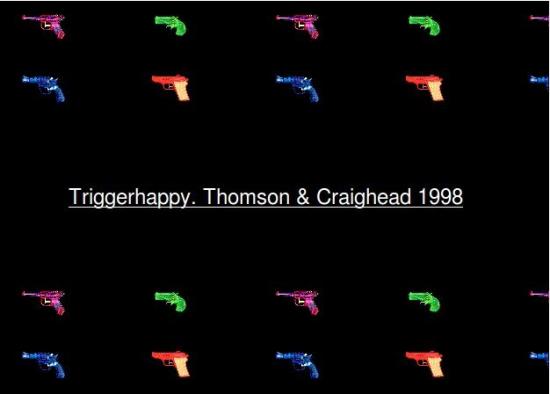
In the British artists Thomson & Craighead version Triggerhapppy the enemy aliens are replaced with quotes taken from the French philosopher Michael Foucault’s essay “What is an author?” “Triggerhappy” is a work that explores the relationship between hyper-text, author and reader. What is a writer, or rather, who is the artist when we are dealing with interactive art in the form of a videogame? Is it Tomohiro Nishikado who created the original game or is it Thomson & Craighead that have modified the game or the player that are playing the game or maybe the computer that creates and interprets the text (the code) that make the game appear on the screen?

After the 11th of September the world suddenly saw a new major enemy, international terrorism. In a modernized version of “Space Invaders”, the artist Douglas Edric Stanely located the scenario in the game to the Twin Towers in New York, which was destroyed during the terrorist attack on 11th September 2001. In Stanley’s version titled the invaders, you have to fight against the hostile aliens before they completely destroy the two towers. The classic struggle between good and evil continues, the game concept is the same as in the original but the scenario and the metaphoric meaning of the aliens has changed.
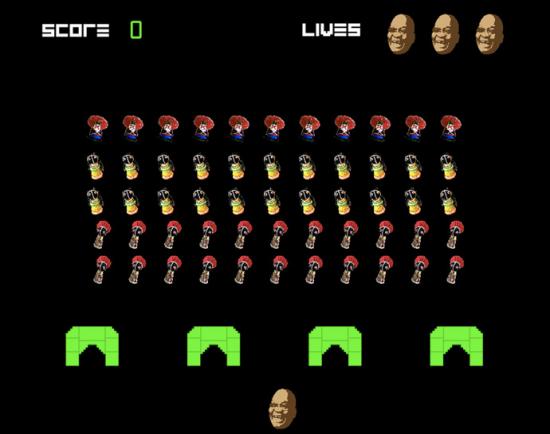
The struggle between good and evil can also be found in other areas of our society, for example in class and gender struggle. In the South African photojournalist Nadine Hutton’s version Skirt-Invaders the main character in the game is Jacob Zuma, South African president since 2009. Zuma has been quite controversial because he is a polygamist and has expressed his doubt about the dangers of AIDS. In the game Zuma you have to shoot down a never-ending stream of virgins from the Zulu tribe. Will the president succeed to shoot down any threatening scandals before they land on the ground? Hutton’s work is an example how a well-known videogame can be used for political purposes and be both entertaining and still very critically at the same time.
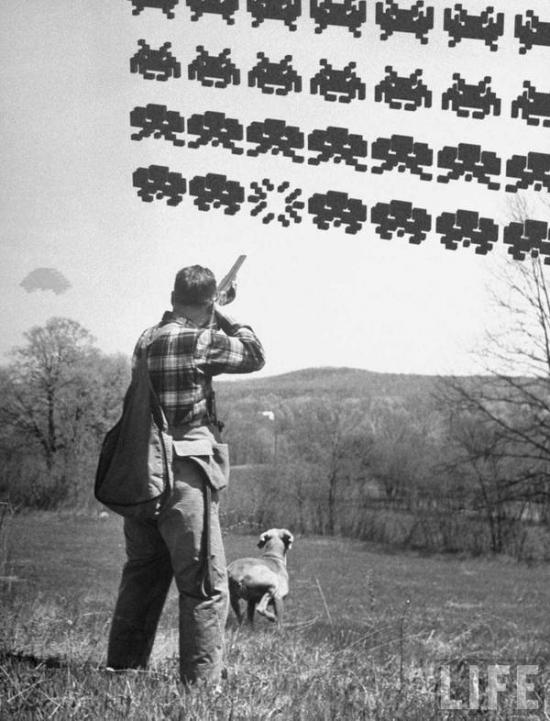
The term mash-up, which is frequently used today, could be described as a form of digital collage. Ryan Sneider has created mash-ups by combining images from various sources, in this case photographs from Life magazine’s archives and videogames. The photomontage Duck Hunt / Space Invader shows a bird hunter with a dog, but it is not birds the hunter aims for, instead it is the famous monsters from the “Space Invaders”. Those who played videogames in the 70 – and 80’s will probably remember the game “Duck Hunt”, where you could shoot ducks that flew up out of the reeds and your faithful dog then ran to fetch them. Sneider has combined the two game ideas, one composed of a photo of a true hunter with a dog and the second of digital graphics from the videogame “Space Invaders”. The work discusses the boundaries between the real and digital world. What will happen when these two worlds become more integrated and the borders are increasingly blurred?
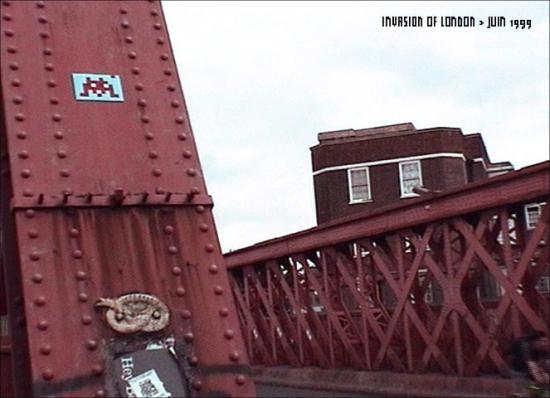

Finally we have to mention the artist, who personifies the game, the French street artist who hides behind the pseudonym Space Invader. His main art project consists of invading various cities around the world and putting up small mosaics of characters from videogames as “Space Invader”. For each successful invasion, he collects points, and the whole art project is described on his website as a reality game. Like other forms of street art “Space Invader” is an ongoing battle about the public space. With help of popular culture Space Invader tries to infiltrate the commercial forces that almost have total monopoly on the imagery that appears in our public spaces. The aliens, in form of small mosaics, become a force that can not be defeated when they are spreading all over the world. A important part of the game “Space Invaders” is that you cannot win, you can certainly come to the high score list, but you can never defeat the aliens, they are instead coming in faster and faster each time they are shot down. It’s obviously a dystopian world view we meet in the videogame, but if we look at it from the artist Space Invaders point of view, it’s rather something positive. The art is a force that will not be stopped. The invasion has just begun and the struggle between good and evil continues…
Videogame appropriation in contemporary art: Pong. Part 1 by Mathias Jansson.
Videogame appropriation in contemporary art: Tetris. Part 2 by Mathias Jansson.
The legend says it was when the Japanese game developer Toru Iwatani took a slice of his pizza that the yellow game character Pac-Man appeared before him. In Pac-Man, we find a restless character hunting around in life’s mazes constantly seeking for pills to satisfy his insatiable desire. Meanwhile the ghosts of anxiety are tracking him down. What many players don’t realize are that the game also contains an unanswered philosophical-existential question. Where is actually Pac-Man for the short period of time when he escapes into the left or right end of the maze and after a short time pop up on the other side of the maze?
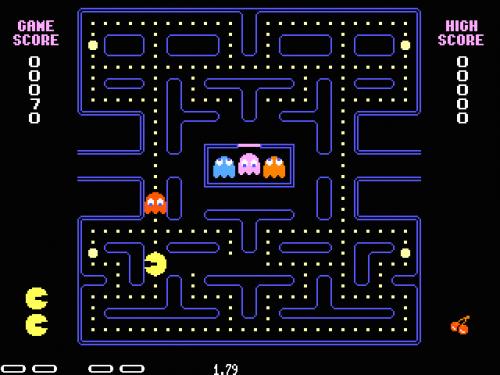
In Martina Kellner’s work “Pac-Man Time Out”, which was showed at the exhibition A MAZE in Berlin 2009, Kellner had created short video clips that investigated what Pac-Man actually did in the short time he was away from the monitor. In one clip, we find him at the airport queue with Ms. Pac-Man ready to board. Perhaps they are planning to take a holiday away from the busy videogame environment? One thing is for sure, Pac-Man does no appear in contemporary art as much as his colleagues from other classic games as Space Invader, Pong and Super Mario.
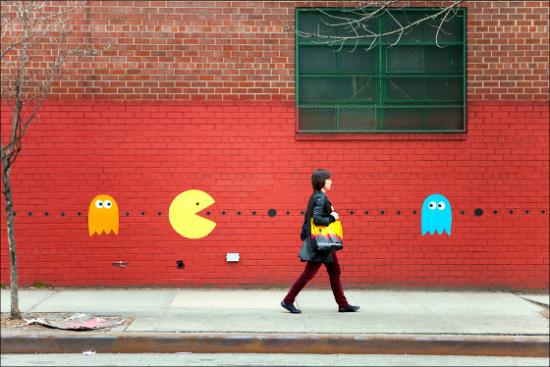
Like many 8-bit characters Pac-Man is well represented in street art and design. For example the American street artist Katie Sokoler staged a real Pac-Man game in her quarters. But it is quite unusual with installations, machinima or Art Games in which Pac-Man has the lead role. This is a bit odd considering how famous Pac-Man is among the general public. The French artist François Escuillie has even created a paleontological reconstruction of Pac-Man’s skull and the Swedish artist Johan Lofgren has in his new colour series “Confessions of a Color-Eater” taken with the colour “Ms. Pac -Man-yellow “, but despite this there are few interactive artworks based on Pac-Man.
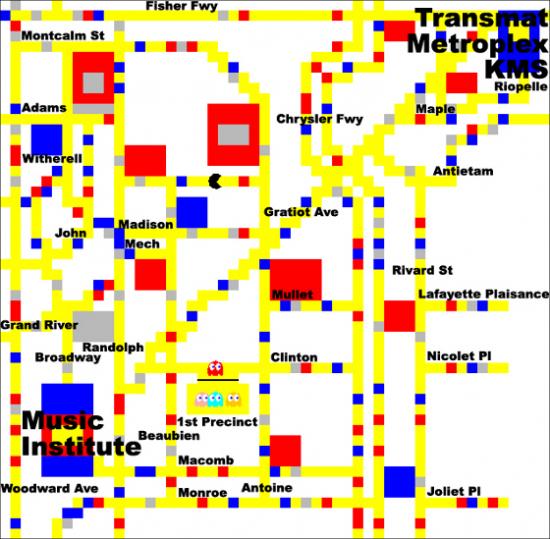
Two exceptions are in any case worth highlighting: the “Pac-Mondrian” and “Eggregore”. “Pac-Mondrian” was created in its first version in 2002 by the Canadian artist group, Price Budgets Boys and is described as a mix of Piet Mondrian, Pac-Man and Boggie Woggie music. The board consists of Piet Mondrian’s painting “Broadway Boogie Woogie” (1942-43), which in its turn is inspired by Manhattan’s street grid and boogie woogie music. The videogame works with the same principle as a normal Pac-Man game except that the maze is a painting by Piet Mondrian. Price Budget Boys have also created three sequels: “Detroit Techno” (2005), “Tokyo Techno” (2006) and “Toronto Techno” (2006). The labyrinths in the new versions are created by stylized street grid from each city, executed in the style of Piet Mondrian. And in the name of equality, you play as Ms.Pac-Man in these versions. For those who have followed previous articles in this series, will recognize that there is a similarity between “Pac-Mondrian” and the Danish artist Andre Vistis works “PONGdrian v1.0”, in which Vistis combined the videogame PONG with Mondrian’s paintings.
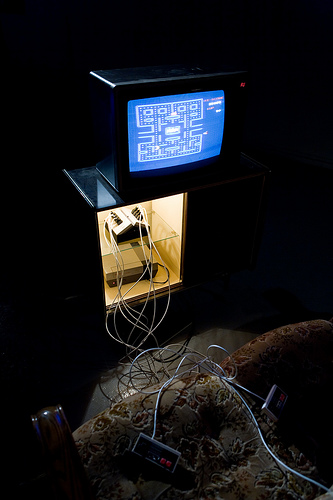
Antonin Fourneau & Manuel Braun’s work “Eggregore” is a social video game in which eight players, each with its own control will try to collaborate and steer Pac-Man through the maze. It may sound like an old teamwork workshop with a twist. Eight wills and strategies must collaborate to succeed with the mission. “Eggregore” is a Greek word which is associated with occultism and means a collective mind. The question that Fourneau and Braun is asking is: Can multiple individual game strategies together create a stronger and better collective player or will it just be chaos when the different games strategies are pulling in different directions? In the video game world, there are many examples of online worlds like World of Warcraft, where player successfully work together in clans or guilds in order to achieve higher goals in the game. It has even become an asset in your CV to show that you have played World of Warcraft and that you can lead and work together with other players to achieve different goals. Pac-Man, however, seems to be a rather greedy individualist who only thinks of himself in the video game world. And perhaps it is this self-absorption with himself taht prevents the game from breaking through as a major theme in contemporary Game Art?
Pac-Mondrian:
http://www.pbfb.ca/pac-mondrian/
Eggregore:
http://liftconference.com/eggregor8
Videogame appropriation in contemporary art: Pong. Part 1 by Mathias Jansson.
Videogame appropriation in contemporary art: Tetris. Part 2 by Mathias Jansson.
Videogame appropriation in contemporary art: Space Invaders. Part 3 by Mathias Jansson
Form+Code In Design, Art and Architecture
Casey Reas, Chandler McWilliams, LUST
2010, Princeton Architectural Press
ISBN 9781568989372
Form+Code is an art computing programming primer. Rather than teaching any particular programming language it explains the technical and conceptual history of programming and its use in art. Starting with an introduction to the basic concepts of coding, instructions, form, and different ways of representing them (in sections titled “What Is Code?” and “Form And Computers”), it moves on to chapters covering “Repeat”, “Transform”, “Paramaterize”, “Visualize” and “Simulate”.
The basic concepts of programming are explained clearly with plenty of examples of code, hardware, and output. They are also related to broader art history, with examples drawn from conceptual artists such as Yoko Ono and Sol leWitt. And it’s good to see Jasia Reichardt’s pioneering work in bringing art and code together is recognised not just in the form of the Cybernetic Serendipity show at the ICA in London but her books and articles on art computing as well.
There is a little code, enough to give a flavour of what it looks like but not enough to intimidate. Listings in or examples of output from BASIC, LOGO, BEFLIX, Hypertalk and other important historical programming languages are presented. PostScript is given its due, with listings, examples of output and a discussion of its incredible impact on the graphic design industry.
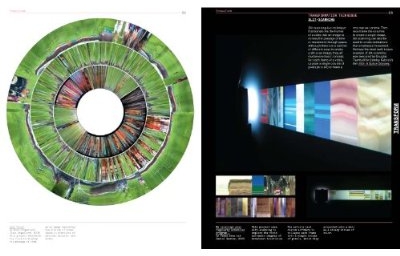
Form+Code is about hardware as well as software. The Difference Engine, ENIAC, oscillioscpes, the PDP-1, arcade games machines that used vector graphics, and the Atari 2600 are all included in a historical narrative of computing and art. The book also describes and shows examples of output from printing hardware from pen plotters through laser printers to CNC and stereo lithography machines, providing a historical and conceptual grounding for thinking about the most advanced output devices currently available.
“Repeat” is explained starting with the Jacquard Loom, and the art of Bridget Riley and Andy Warhol before moving on to variations on a simple BASIC program with illustrations of its output. Packing this amount of historical, computer science and artistic information into each chapter would be overwhelming were it not for the book’s clear writing, structure and design.
“Transform” touches on Holbein’s “Ambassadors” and Victor Vasarely’s Op Art as well as the basic mathematics of folding a piece of paper. “Parameterize” has Dada, Duchamp, the Beats and Calder’s mobiles. It mentions grids without mentioning Rosalind Krauss (the book as a whole is pretty much Theory free), and explains how you use variables to produce variants on the same form.
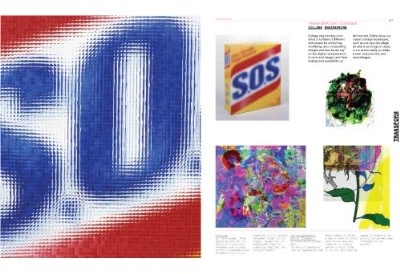
“Visualise” and “Simulate” are almost devoid of (non-computer) art historical examples and cultural context. Harold Cohen’s AARON is illustrated, and Douglas Hofstadter, Richard Dawkins and Stephen Wolfram’s ideas are mentioned. More people should know about the wokr of Hofstadter’s FARG, and the concepts, work and writing presented are still a treasure trove of information and inspiration. But these chapters lack the art historical context of their predecessors.
The contemporary visual art computing presented is mostly in the generative art / data visualisation mold. It’s highly structured, would mostly be impossible to produce without computers, and is haunted by the possibility of being merely decorative. The only academically recognisable critical art included is one of JODI’s less threatening browser pieces. But the example of worldmapper.org in the chapter on visualisation shows how the aesthetic tools of data visualisation can be used politically. And the formal structures and creative strageties of much of the art has a quality of realism in the age of networks that is a challenge to Theory rather than a falure to illustrate it.
The success of books intended to provide a comprehensive foundation in an area of the study of art, such as “Art In Theory” or “Basic Design”, have both helped to enrich the study of art and had the unintended consequence of closing off other possible narratives. Form+Code stands to be as successful in its own area as those books were in theirs, with the same benefits and dangers. Form+Code’s ommission of virtual reality, livecoding, and other movements within art computing are understandable given its focus, but hopefully won’t lead to their neglect by students.
Could you code up any of the software art that you see in the book after reading it? No. The only code listings are historical fragments. But after reading the book you will undestand the concepts that you need both to figure out what more you need to learn in order to program such art and to understand why doing so is aesthetically and art historically worthwhile. And some source code from the book, in various programming languages, is available online.
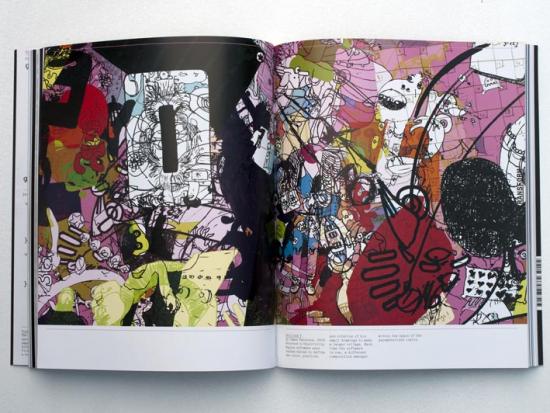
Form+Code’s major achievement is that it presents technical, art historical and technical historical information in such a way that it complements each other and builds a bigger picture that demonstrates the wider relevance and further potential of art computing programming. Having read it, you’ll know more and you’ll both want to and be able to learn how to do more. It’s clearly laid out, packed full of illustrations, occasional code fragments, plenty of references to sources for further investigation, and even has a good index. It really is a foundation course in a book, providing a sound basis for further learning or research.
If you teach art computing, and if you are teaching art, graphic design, textiles, fashion or architecture then you are teaching art computing to a greater or lesser degree, then Form+Code is a perfect primer for the conceptual, historical, and cultural side of computing and art computing. Outside of education, if you are involved in art, computing, or are a non-programmer computer-using artist Form+Code provides a good grounding in the concepts used in programming for art computing.
Form+Code serves as a complete introduction to the conventional history, concepts and practice of visual art computing. It presents that information in the context of the broader history of art and design. And it provides enou
In the second part of classic videogames that have inspired contemporary artists, we take a closer look at a game that the Cubists probably would have worshiped. Tetris was created in 1984 and then released officially in 1985 by the Russian programmer Alexey Pajitnov. In Tetris you have to move and rotate seven different combinations of blocks as they fall into a well. The blocks are called tetrominos and are made of four squares. The goal is to fit the different geometric shapes so that as little empty space as possible remains in the bottom of the well. Tetris is a puzzle game for people who like compact living, and who see it as a sport to pack economically to the holiday.
In contemporary art you can find three main approaches how artists have used Tetris. The Swedish artist Michael Johansson is a good example of the first approach. He has used the basic idea of Tetris to stack objects with different colors and shape. Johansson works with site-specific installations, in which he collects and stacks objects from the near surroundings in perfect symmetry with no spaces. The installations are called Tetris, which is fitting since they are strongly reminiscent of the game.

“For me creating works by stacking and organizing ordinary objects is very much about putting things we all recognize from a certain situation into a new context, and by this altering their meaning. And I think for me the most fascinating thing with the Tetris-effect is the fusion of two different worlds, that something you recognize from the world of the videogame merges into the real life as well, and makes you step out from your daily routine and look at things in a different way.” says Johansson in an interview at Gamescenes.org
Like many other classical videogames, Tetris has been used a lot in public spaces as in graffiti, mosaics and posters on facades and in subways etc. In Sydney, Australia, artists Ella Barclay, Adrianne Tasker, Ben Backhouse and Kelly Robson in 2008 at an exhibition at Gaffa Gallery created an installation where they placed giant illuminated Tetris Blocks in a narrow alley. It looked exactly as if the blocks had fallen from the sky, but the alley had been too narrow so the blocks were stuck halfway down.

The second approach is to move Tetris out from the exhibition room into public spaces and sometimes also create interactive and social art. The artist group Blinkenlights, who are known for transforming large skyscrapers into interactive screens, on various occasions making it possible for the passing public by to play Pong or Tetris on a skyscraper using a mobile phone. In 2002 they made the installation Arcade, which turned one of the skyscrapers in the Bibliotheque Nationale de France in Paris to a giant screen showing various animations, where a passersby could also play arcade games like Tetris.
The artist group Lummo (Carles Gutierrez, Javier Lloret, Mar Canet & JordiPuig) created in Madrid in early 2010, a Tetris game in which four people have to cooperate to play it. The first step for the participations was to create the Tetris blocks and after that they had to work together to place on right position in the well which was projected on a wall. In Both cases, Blinkenlights and Lummo are creating public meeting places with social interaction where the videogame is used as an interface.
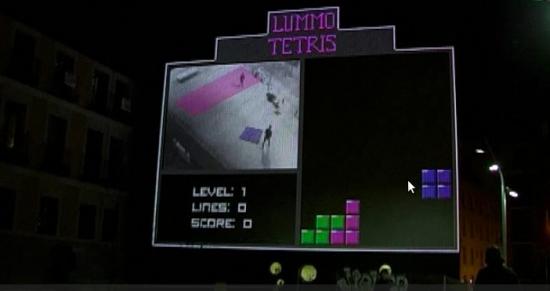
The third approach is changing the game itself and creates new versions of the game which discuss the game idea. The artist group version [url=http://www.tetris1d.org/]1d Tetris[/url], is a one-dimensional Tetris where the blocks consist of four vertical squares falling into a well that is just one block wide. Since the blocks always fill the well the players do not have to do anything to score points. The basic idea of the falling blocks still remains in the game, but in a one-dimensional world there is no longer any difficulty, the game is reduced to a very monotonous and predictable puzzle game.
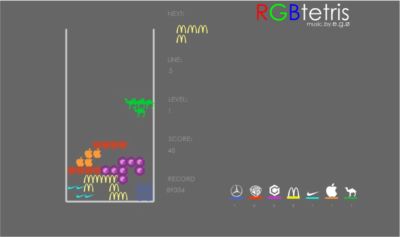
In First Person Tetris the artist David Kraftsow combines the perspective from the popular first person shooter genre (used in war and action games) with the ordinary puzzle game. In Kraftsows variant you see the game from a first person perspective so when you spin the blocks, it is not the individual blocks that are spinning around but instead the whole screen. Just by using a new perspective in the game has Kraftsow created a whole new experience of Tetris. Mauro Ceolin, who has spent many years focusing on the modern emblems on the Internet. In works such as RGBTetris and RGBInvaders he replaces the game’s graphics with contemporary icons and logos. In RGBTetris the blocks that fall down the well are exchanged with logos from Camel, McDonalds, Nike and Mercedes.
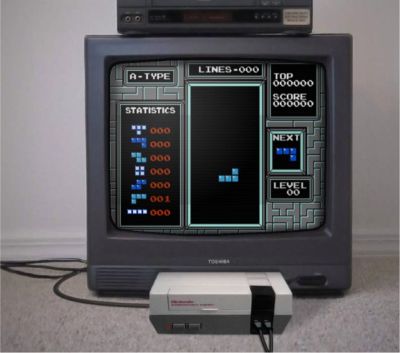
The most interesting and most independent among the playable Tetris versions that I have found are made by the Swedish artist Ida Roden. In Composition Grid she has combined her interest in drawing with Tetris. The player can play a game and in the same time create a unique drawing by rotating and changing one of the 216 different creatures that Roden has created, with the Tetris blocks as model. The player can then choose to print out their own game plan with the artist’s signature, and in that way have a unique work of art in there possession.
Tetris, this two-dimensional version of Rubik’s Cube, seems to create a lot of room for artistic experimentation. It just needs some simple changes, or new perspectives, to create a new and interesting interpretations of the game.
Videogame appropriation in contemporary art: Pong. Part 1 by Mathias Jansson.
Some of these new Tetris games can be found at these addresses:
www.rgbproject.com/RGBtetris/RGBtetris.swf
www.tetris1d.org
www.firstpersontetris.com
www.idaroden.com/composition.html
Classic video games such as Pong, Tetris, Space Invaders, Pac Man and Super Mario have in the past decade inspired many artists in their work. The common link between all of these games is that they are very easy to learn and play. There is no need for manuals, just a few simple instructions on the screen. The graphics are simple, the colours few, the characters and style are pixelated. These games have influenced a whole generation and have over time become a part of our cultural heritage. Even today, these games still amuse and fascinate players and have also inspired various artists to use them in their art. In a series of articles, we will look at some classic games and give examples of how they have been used in art and what impact they have made on the art scene. First out is PONG.
It was the American physicist William Higinbotham who in 1958 created what many consider to be the first computer game. The game was called “Tennis for Two” and was played on an oscilloscope with help of a simple analogue control.

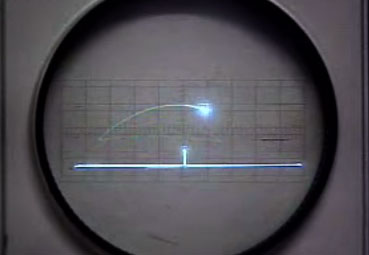
Click here to view video on Youtube…
It took, however, until 1972, when the Atari Company, founded by Allan Alcorn and Nolan Bushnell, picked up the idea and created a commercial version and called it PONG, before the game became one of the first real big sellers for the computer games industry. PONG is a simple, minimalistic game that consists of two rectangles and a square, which symbolize two tennis racquets and a ball. You can either play against another opponent or against the computer. In this simplified version of tennis, the goal is to hit the ball so the opponent misses it.
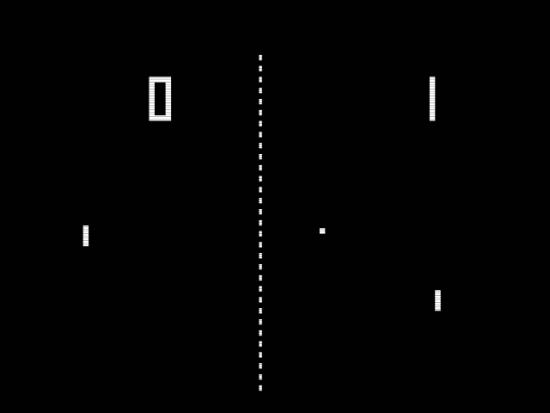
PONG is probably the videogame that has inspired most artists over the past decade. When the Computer Games Museum in Berlin in 2007 organized a major exhibition entitled “pong.mythos” over 30 artists attended with works of art inspired by PONG. The catalogue explains why PONG fascinated so many artists: “No other video game has been the origin of artistic production quite as often as the simple black-and-white tennis game. In addition to its popularity, it seems to be this minimalism that especially appeals to artists, since the playing pattern is a virtual prototype of the essence of each and every communication situation: the ball as the smallest possible unit of information, oscillating between sender and receiver” (from the catalogue “pong.mythos” 2006).
The artist group /////////fur//// showed their “Pain Station” (2001) in which the player who missed the ball were punished with physical pain, a blow on the hand, heat or an electric shock. “Pain Station” connects the physical world with the virtual and the virtual player’s mistakes turn actual real pain.
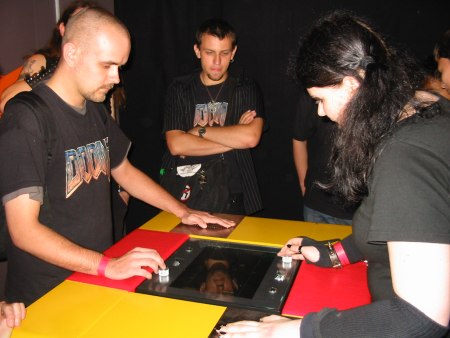
The artist group Blinkenlights working in the urban environment was represented with a project that transformed a large office building at Berlin Alexanderplatz to a digital screen where passersby could play PONG on the facade with the help of their mobile phones. In the artists S. Hanig and G. Savicic’s work “BioPong” (2005) the ball was replaced with a living cockroach where the players would try to push the insect over to the other side. And in the group Time’s Up version “Sonic Body Pong” (2006) the ball in the game was only a sound which the players could hear in their headphones and with help of large green rectangles on their heads they would try to hit the sound from the ball.
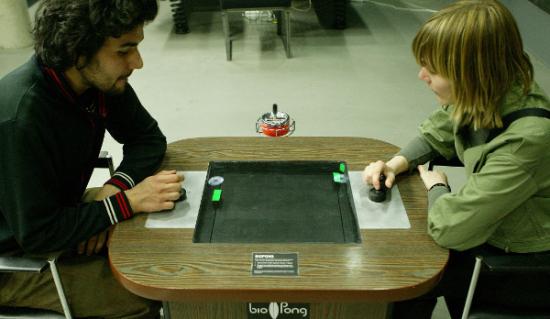
There are also many other examples that were not included in the exhibition “pong.mythos”. As early as 1999, the artist Natalie Bookchin made “The Intruder”, a work where PONG was one of 10 different videogames that she used to create an interactive artwork by Jorge Louis Borges short story “The Intruder”. The Danish artist Anders Visti mixed the game PONG with the art of Piet Mondrian in “PONGdrian v1.0” from 2007. The playing field in Vistis artwork reminiscent a painting by Mondrian but when the ball hits the fields it disturbs the lines and colour fields, and creating new opportunities and challenges for the player. Finally, I can mention the Swiss artist Guillaume Reymond, who has made a series of performances called “Game Over”. In a theatre auditorium, he creates animated sequences by using real people in colourful T-shirts, where each individual represents a square on a screen. By moving the people in the auditorium, he can create short video sequences, for example of PONG playing in the lounge.
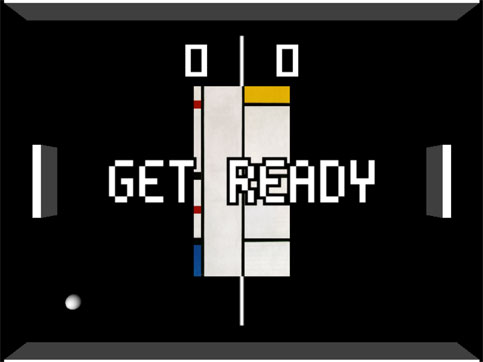
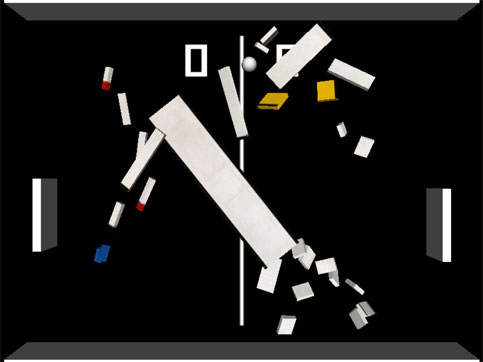
The reason that PONG is so popular among artists is that it is one of the very first video games, and therefore there is a large identification factor and a strong relationships between the game, the player and the artwork. PONG is also one of the easiest games in terms of both appearance and to learn to play, which paradoxically makes it so easy to transform and use in different contexts. The phrase “less is more” seems in this case a good explanation why PONG has inspired so many artists in recent years.
Pong Mythos – http://pong-mythos.net/index.php?lg=en
Natahalie Bookchin – The Intruder http://bookchin.net/intruder/
Guillaume Reymond – Game Over http://www.notsonoisy.com/gameover/
Anders Visti – PONGdrian v1.0 http://www.andersvisti.com/arkiv_grafik/pongdrian.html
We explore collaborative working to establish new sustainable ways of sharing knowledge, ideas and resources, and increase participation in the arts.
Furtherfield and Drake Music have come together to create ‘We Share’, a new initiative, building on and developing the combined creative assets, specialisms and strengths of these two organisations and collaborating closely with other groups in the field. In the first phase of this initiative our organisations are testing and piloting new ways of working, with a view to other partners joining us during the second phase.
To explore the possible benefits of organisational collaboration in:
The first of these projects has been to develop shared web infrastructure and organisational websites for participatory arts organisations using Free and Open Source Software and processes. The next stage of this project is to develop a business plan and seek investment to broaden the reach of our offer.
HTTP Gallery is pleased to host the UK premiere of In the Long Run (2010), the new work by art collective IOCOSE, produced by Aksioma – Institute for Contemporary Art (Ljubljana) as part of the platform RE:akt!.
View short Trailer of video on Youtube
In the Long Run (2010) is a reconstruction of a possible future high profile media event. The death of pop star Madonna is described in a BBC News special edition, with a journalist and studio guest who go over the details of the fatal car accident, the statements of the VIPs and the reactions of fans around the world.
It is not a true story, but neither is it improbable. All TV networks prepare obituaries about famous people to put on air in the event of an unexpected death. The death of an international figure is not just predictable, it is actually predicted in the video files kept up to date in their archives.
The new video will be accompanied by two previous works, Doughboys (2009), a ‘real time mockumentary’, following a trio of real-life super heroes who defended illegal issues in the police patrolled streets of Rome, and FloppyTrip (2009), an installation consisting in a kit, to prepare your own hallucinogenic drink by recycling redundant floppy disks and provided with a video explaining how to use it.
IOCOSE has been working in Italy and Europe since 2006. It organises actions in order to subvert ideologies, practices and processes of identification and production of meanings. It uses pranks and hoaxes as tactical means, as joyful and sound tools. IOCOSE thinks about the streets, Internet and word of mouth as a battlefield. Tactics such as mimesis and trickery are used to lead and delude the audience into a semantic pitfall.
IOCOSE will be interviewed live on Furtherfield on Resonance FM on Wednesday 03 November at 7pm. Available to download from www.furtherfield.org/resonancefm.php
To accompany In the Long Run, we are pleased to present a new essay by critic, writer and curator Domenico Quaranta about IOCOSE’s new work. (download PDF)
Production: Aksioma – Institute for Contemporary Art, Ljubljana, 2010 www.Aksioma.org Project produced as part of the platform RE:akt!
Also screening at:
RE:akt! – Reconstruction, Re-enactment, Re-reporting
Rotovz Exhibition Salon, Maribor, Slovenia
21 October – 19 November 2010
More Information:
IOCOSE: www.iocose.org
RE:akt!: www.reakt.org
On October 10th, 2010, the Upstage Festival of Performance Art (101010) curated by Helen Varley Jamieson, Vicki Smith, and Dan Untitled ran for approximately twenty hours, the fourth such iteration of themed dates (last year ran on 090909.) 101010 showcased thirteen new cyber performances from Canada, USA, UK, France, Germany, Italy, Sweden, Austria, Serbia, Australia, and New Zealand, most lasting for twenty minutes. UpStage was host to ten real world viewing nodes in Calgary, New York, Nantes, Eindhoven, Oslo, Ljubljana, Pancevo, Vietnam, Auckland, and Wellington. Individuals could also tune in from the comforts of their own homes.
UpStage’s audience derives from anywhere one is capable of accessing a web page, and participation does not require the installation of any new software except the ubiquitous Flash Player plug-in. The application sits on a central server, is free and open source, and programmers can add new code and share improvements and new features. Written in Python, UpStage works with third-party applications. It provides a set of tools for logged in players to work with a variety of media in real time; graphics (still images and animations), video (live web cam feeds or prerecorded video), audio (text2speech synthesized speech or prerecorded audio), text and illustrations that are collaboratively manipulated to create an improvised or rehearsed event.

Performers, euphemistically referred to as “players”, show up in the “stage” or screen area as avatars with access to a variety of pre-created backgrounds and props. When the avatars speak their words appear on-screen as a cartoon-like bubble, and their speech is simultaneously rendered in the odd robotic text2speech function. The thirteen performances were grouped into four themed categories. Temporal explored sound and movement across time and networks. Trajectory examined the path of a moving object through space, and the arc where that object intersected with the story. Tendrils wove subtle thoughts and concepts, and Transgress went beyond limits to question, challenge, and provoke.
MIT Professor Sherry Turkel in her 1995 groundbreaking book Life On The Screen first codified the anonymous audience interaction. UpStage’s appeal is its live-time interactivity that emulates the anonymity of sites like Second Life, but also employs scripted dramas that let the audience (either all of the time, or at selected moments) jump into the story. It raises the question of the difference between “stage” acting in a traditional theater, and acting in front of a virtual audience, an issue bridged by maintaining traditional chat function.
Before a scheduled performance begins, one can congregate in a virtual foyer and facilitators use a megaphone to speak in synthesized robotic text2speech voices. A second screen tab hosts the site of the virtual performance area. Depending on whom Upstage is trying to connect with, the dialogue and effects can flow swiftly, or be disrupted.

I was able to view four performances over the span of two hours. “Plaice or Sole” by Francesco Buonaiuto, Mario Ferrigno, and Simona Cipollaro (Naples) contained graphic sexual content that was presented in a purposely immature style. At first it was annoying and boring, but afterwards I was informed that was the point – to emulate and call attention to the inane comments and dialog that occur in many on-line cybersex chat rooms. A crash during the site’s interaction was a deliberate simulation of a technical failure. As one person put it, “it forced you to become engaged in the text shift.”

Active Layers, is a virtual collective includes Cherry Truluck (UK), Liz Bryce (NZ), James Cunningham and Suzon Fuks (Australia). They combine theatre, dance, video and visual arts both digitally and conceptually to redefine the meaning of location and site. Their animation piece “Aquifer Fountain” focused on drought, water, flooding, and devastation, with mothers dreaming of lost babies. During the performance the actors participated from London, Kawerau and Milwaukee.
“Make Shift” is a work in progress by Paula Crutchlow (UK) and Helen Varley Jamieson (NZ/Germany). They used the Upstage audio-visual conferencing tools in two deliberate domestic spaces to link their cyberformances, thus creating a third discursive space. The discussions focused on the political aspects of domesticity such as “nesting, feeding and mobility,” and how this relates to the experience of globalization.
“MASS-MESS ” by Katarina DJ. Urosevic & Jelena Lalic (Serbia) ran both virtually and at the physical node at Galerija Elektrika in Pancevo. It was a study of structures, mass media and independence in the context of a hierarchy of information without a center playing out like a post-Soviet Politburo manifesto. “MASS-MESS” made it onto Serbian TV, as evinced by a subsequent newscast posted onto YouTube.
What is an experiment? I get the sense that many of monochrom’s projects seek to interface with the world (ahh, but what world might that be?) In a sense, I am curious about how you imagine the field, what objects you see upon it, what things call themselves objects but are perhaps only specters? How can non-existent artists save non-existent countries?
Yes, we love experiments. And we approach them like committing a crime: very, very carefully. Still, we know that there’s no perfect crime and we are going to make some mistakes. The main problem with our artistic and activist work is, and that might sound strange: subversion.
Only thirty years ago Western societies were still governed along the principles of the “disciplinary society”. The institutions of a disciplinary society are founded mainly on two devices that keep its subordinates where they are: control and punishment. Both are certainly effective, yet they produce at least an inner resistance, as well as the possibility to avoid either. It’s hard to monitor in absolute terms, and there are always ways of avoiding, if not “hacking” and ridiculing these mechanisms of control. Loop-holes will be identified and used.
The disciplinary society was one that created refractoriness; it revealed hierarchies and blatantly opposing classes of rulers and the ruled. These small acts of individual resistance also instigate models of theoretic and actual resistance on a grander scale.

The society of control has however shifted this device and transplanted it into the subjects themselves. As soon as control is collectively internalized, when control is part of the psychological apparatus and of thought, then we can speak of control in absolute terms. Not much can be done anymore, as no one is independent from, or outside of, control any longer.
We have to be aware of this change and have to analyze and adjust our attacking strategies. Companies like Nike already use Graffiti as a standard variety in their marketing campaigns and the first people who read Naomi Klein’s No Logo were marketing gurus who wanted to know what they shouldn’t do. We certainly can change the political economics of a society. And you can quote me on that. But we have to be precise about it. Just playing around might only make our actions end up as a funny 15-seconds-clip on CNN, and that would be useless. We have to understand cognitive capitalism or we will just be going round and round in the same old circles, as the history of guerrilla communication clearly shows.
How can we subvert a system that actually wants you to subvert it? You can only experiment. And fail.
Well, since beginnings are first (except of course when they aren’t) it would be interesting to hear a bit about the inception of monochrom back in 1993.
I was always interested in obscure crap, even as a kid. I loved science fact (Carl Sagan is still my only media idol) and science fiction, especially John Brunner and William Gibson. And I was always interested in the political dimension of near-future sci-fi. It’s hard to imagine, but I became a punk and antifascist because I devoured cyberpunk novels and watched stuff like Max Headroom. It was great dreaming of a jack in the back of your head, but the corpocratic, doomed world was nothing that I wanted to really happen. I joined the FidoNet data network when I was thirteen or fourteen, around 1988 or 1989. It was a wonderful way to get in contact with weirdos from all over the planet, collecting info and interesting mailing list threads, and slowly but surely my wish to start a publication grew. So monochrom started in the early 1990s as a print fanzine about cyber-topics, politics, bizarre art and covert culture.
What were the circumstances or impetus for Monochrom’s formation? How do you find the world around monochrom has changed since you began?
There was some stuff in the US of A, like Mondo2000… but it was all too hippie-ish, too liberal, indulging in what Richard Barbrook and Andy Cameron later called the “Californian Ideology”. I wanted to share and propagate a leftist European perspective. As a member of several bulletin board systems I sent out mails to a couple of message boards, looking for collaborators, and Franky Ablinger replied in only two hours. And so the monochrom group, or better, “the monochrom culture,” was born. We published a couple of issues, low circulation, and – as the name suggests – we were barely able to finance the black and white xeroxes. But we kept working, creating our first internet site in early 1994.
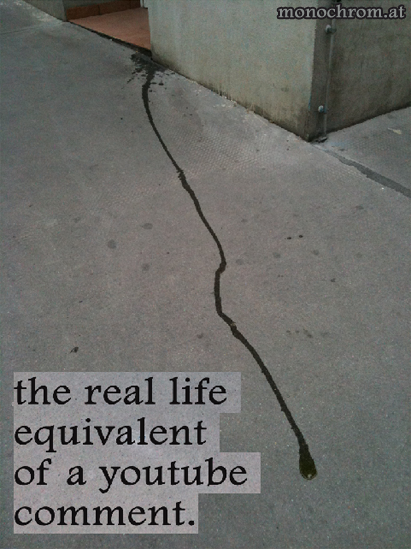
In 1995 we decided that we didn’t want to constrain ourselves to just one media format (the “fanzine”). We knew that we wanted to create statements, create viral information. So a quest for the best “Weapon of Mass Distribution” started, a search for the best transportation mode for a certain politics of philosophical ideas. This was the Cambrian Explosion of monochrom. We wanted to experiment, try stuff, find new forms of telling our stories. But, to be clear, it was (and still is) not about keeping the pace, of staying up-to-date, or (even worse) staying “fresh”. The emergence of new media (and therefore artistic) formats is certainly interesting. But etching information into copper plates is just as exciting. We think that the perpetual return of ‘the new’, to cite Walter Benjamin, is nothing to write home about – except perhaps for the slave-drivers in the fashion industry. We’ve never been interested in the new just in itself, but in the accidental occurrence. In the moment where things don’t tally, where productive confusion arises. That’s why in the final analysis, although we’ve laughed a lot with Stewart Home, we even reject the meta-criticism of innovation-fixation articulated in ‘neoism’. The new sorts itself out when it lands in the museum. Finito.
Some guy once called us ‘context hackers’ because we carefully choose the environment we want to work in and then try to short-circuit it. Some projects definitely work better as a short film or installation or puppet theatre or robot or performance, some should simply be presented as ASCII files … and some are the right stuff for a musical. It just depends.
What happened to the fanzine?
Well, it’s unbelievable, but we still publish it, but not on a regular basis. We decided to switch to a “phatzine format” or call it a “magazine object”. It’s huge. The last one was released in March 2010… it’s #26-34, an accumulation of 500 pages and 2 kilograms. It can break your toe if you drop it! It’s still a good mix of science, DIY, theory, cultural studies and the archeology of pop culture in everyday life. With a great deal of forced discontinuity, a cohesive potpourri of digital and analog covert culture is pressed between the covers. We try to offer an un-nostalgic amalgam of 125 years of Western counterculture – locked, aimed and ready to fire at the present. Like a Sears catalog of subjective and objective irreconcilability – the Godzilla version of the conventional coffee table book.

What are your thoughts on contemporary zoology?
I always loved the grand dichotomies of life. Dogs and cats. Cats and mice. Like Tom and Jerry. But as someone who grew up in Central Europe I never understood how a mouse can live inside a wall. Walls are made of bricks! They are not hollow. Way later I came to understand when I learned that US-American houses are just made of wood, and their walls are really hollow.
Have you ever been walking down the street, mobile phone in hand, and thought of throwing it on the cement, giving it a few good dancing stomps and darting off?
Yes. Even better. We did a workshop called “Experience the Experience of Catapulting Wireless Devices”. The catapult is one of the oldest machines in the history of technology. It is no coincidence that we instigated a creative return. The knife edge of technology hype is sharp, most of all on the West Coast of the United States. Thus we initiated a competition. We invited interested persons to design and build a catapult capable of hurling a cell phone or a PDA unit the greatest possible distance. In order to ensure that no participant had any unfair advantage, we provided a specifications list regarding materials (e.g. metal) that were not to be used and other limitations (e.g. size and weight). And we only tolerated WIRED Magazines as counterweights. That was fitting.
Were you in Berlin when the wall was taken down?
I was asleep, at home. But I always wonder what the official web site of the GDR would look like if they were still around in 2010. Would they use Flash? Or HTML5?
Fanta or Coke?
Fanta originated when a trading ban was placed on Nazi Germany by the Allies during World War II. Coca-Cola GmbH, therefore was not able to import the syrup needed to produce Coca-Cola in Germany. As a result the company decided to create a new product for the Nazi market, using only ingredients available in Germany at the time, including whey and (yummy) pomace. They called it Fanta. So I guess, what’s the difference?
Read part 1 of this interview:
http://www.furtherfield.org/interviews/interview-johannes-grenzfurthner-monochrom-part-1
Read part 2 of this interview:
http://www.furtherfield.org/features/interviews/interview-johannes-grenzfurthner-monochrom-part-2
The Zero Dollar Laptop Workshop programme has been developed and delivered through partnership between Furtherfield and Access Space and aims to change attitudes to technology. It does this by recycling hardware, deploying Free and Open Source Software (FOSS), sharing skills and working together to create rich media content.
This project has provided a useful basis for thinking about how art might be able to create change through learning and education that relates to technology.
This question becomes especially relevant in the context of current, global economic and ecological collapse.

So first let’s start by thinking about what art and technology and social change have got to do with each other?
It does depend on how you view art. At Furtherfield we don’t accept the mainstream view of art as a marginal interest. The expanded, connected and networked art forms that we choose to work with cannot be separated from life so easily.
They engage the people who encounter them with different kinds of aesthetic, ethical and philosophical experiences – often in places not easily recognisable as art-spaces, often in technologically enabled spaces because this is where life takes place for so many people.
For all kinds of reasons (to do with our education and class structures), in the UK the dominant view is that ‘great’ art is separate and distant from the rest of life and therefore of marginal relevance to society and most people, or to quote Heath Bunting ‘Most art means nothing to most people’.
It is regarded as: elite/intellectual, historical/heritage, commodity, the work of charlatans etc.
Sometimes art is regarded perhaps more positively, as a diversion or a hobby; more positive from our point of view because people make art their own, share it and incorporate it into their own lives on their own terms.

Don’t just Do It Yourself, Do It With Others (DIWO!)
Furtherfield got started in the context of the discourse-smothering London Brit Art gallery scene in the mid-90s, when access to established galleries was carefully guarded. Meanwhile the Internet, an open public space of unlimited dimensions, was relatively sparsely populated at two extremes by corporate marketing departments and pet owners. The Internet also offered a free playground for early net artists.
Since then Furtherfield has co-constructed platforms and processes (online and in physical spaces) with a network of other artists, hackers, gamers, programmers, thinkers and curators to support collaboration and engagement between artists, participants and audiences worldwide.

Informed by ‘open and free’ philosophies and practices of peer-to-peer cultural development and moving on from the DIY (Do It Yourself) approach of the 1990s artist-hackers that fed on the Modernist understanding of the individual artistic genius, we have moved towards more collaborative processes that we call DIWO (Do It With Others) and that explore different ways of creating shared visions.
For us taking a grassroots approach in art means that we pay attention to the everyday lives of the people we work with, to create and shape the platforms that we need. This is not a hippy dream. Rather, it provides a way to develop robust and healthy ways for diverse people and interests to interact and co-exist for mutual benefit.

Since 2008 Furtherfield and Access Space have worked in partnership on the Zero Dollar Laptop project, to support cooperation in creativity, technical learning and environmental awareness. One side-effect of techno-consumerism is that we dump tonnes of UK electronic waste in the developing world each year.[2]
This project, inspired by James Wallbank’s Zero Dollar Laptop Manifesto, aims to change the way we think about technology by a shift of emphasis: from high-status consumer technologies to customised tools-for-the-job and smart, connected users.
Our organisations have worked together with participants to develop resources and pilot workshops that aim to eventually bring back into use (or save from toxic waste dumps) millions of redundant laptops currently gathering dust on shelves in homes and offices across Britain; putting them in the hands of the people who are best placed to make use of them, to benefit from a collaborative approach to learning and to connect with new knowledge networks in the process.
This project has its basis in grassroots, critical practice at the intersection of art, technology and social change.

The first pilot of Zero Dollar Laptop workshops kicked off at the Bridge Resource Centre in West London in January 2010 with clients of St Mungo’s Charity for Homeless People. [3]
In our experience, a much more diverse group of people are able to enjoy and benefit from technical projects when the projects acknowledge and incorporate ethical, philosophical and aesthetic questions as part of the mix.
People who might not initially identify themselves as ‘techy’ stay engaged with complex technical learning processes by focusing on the learning that is meaningful for them and sharing it with others.
In the case of Zero Dollar Laptop workshops this can range from creating a profile image for Facebook to writing a blog post to lobby against government cuts in public services, or creating a desktop background or a new startup-sound to customise their own laptop.
The meaning and function of work is often conveyed by the construction of a context (a place, a set of tools, an aesthetic, a set of relationships) or a hack or remix of an existing context.
With participatory or collaborative artworks the context in which people engage with the work is a part of the work.
So the role of the artist today has to be to push back at existing infrastructures, claim agency and share the tools with others to reclaim, shape and hack these contexts in which culture is created.
We believe that through creative and critical engagement with practices in art and technology people become active co-creators of their cultures and societies.
And as James Wallbank notes, ‘the best artworks are those that create artists’.
Originally commissioned by Axisweb.
All Raise This Barn – a group-assembled public building and/or sculpture.
“Artists MTAA are conducting an old-fashioned barn-raising using high-tech techniques. The general public group-decides design, architectural, structural and aesthetic choices using a commercially-available barn-making kit as the starting point.” -MTAA
Eric Dymond: Could you give me a brief history of MTAA?
T.Whid: Mike Sarff (M.River of MTAA) and I met in college at the Columbus College of Art & Design in Columbus, OH. We both separately moved to NYC in 1992 and started collaborating as MTAA in 1996 first on paintings and then moving on to public happenings and web/net art. We’ve been collaborating since, showing our work via our websites at mteww.com and mtaa.net. We’ve earned grants and commissions from Creative Capital, Rhizome.org and SFMOMA and shown at the New Museum, 01SJ Biennial, the Whitney Museum and Postmasters Gallery.
ED: The All Raise This Barn project uses one community to design and another to construct. Barn raising is itself a communal activity, drawing out the best in people and providing a place of sustenance for the Barn owner. How did you come to use a Barn Raising as the central performance subject?
M.River: From the start, Tim and I have been interested in how groups and individuals communicate. How do we speak to each other? What rules do we use? How does communication fail or how can it be disrupted? What is the desire that engines (TW: controls?) all of this – and so on. This interest in exchange is what attracted us to the Internet as a site for art in the beginning.
Along with communication as text, speech or image, we like to use group-building as a method for working with non-verbal communication. We’ve built robot costumes, car models, aliens and snowmen with large and small groups. It’s a type of building that is intuitive and open to creative improvisation. This kind of intuitive building is heightened by placing a time constraint on the performance. In the end it’s not about the end object, which we always seem to like, but more about the group activity.
So, at some point we began to think how large can we do this? A barn-raising seemed like the next level. It’s bigger than human scale and contains a history of group-building. Barns also have a history of being social spaces. Your home is your world but the barn is your dance hall.
ED: Did you envision it as a community event from the beginning?
MR: Yes. An online community, a physical community and a community that overlaps the two.
ED: It’s a hybrid work that draws upon some important conceptual precedents. The instructional aspect takes Lewitt and turns the strict instructions he uses upside down by allowing online decisions to drive the design. Did you find the responses to the online polling surprising?
MR: Yes and no. Like the other vote works we have produced, Tim and I set up how the polls are worded and run. So, even though we try to keep the process as open as possible, the nature of how people interact is somewhat fenced in. Even with a fence, people will find a way to move in strange directions or break the fence. It’s not that we think of the surprising answers as the goal of the work, but it is an important part of the process.
ED: There is also the performance aspect which I find exciting. The performance from both events are well documented. Were there any concerns regarding the transfer of the polls instructions to physical space?
MR: We had the good fortune of doing the work in two sections. When Steve Dietz commissioned ARTBarn (West) for the 01SJ Out of the Garage exhibition, we spoke about the sculpture as a working prototype for how a large pile of lumber could be group-assembled in a day with direction from Internet polling. From this prototype we then had a model for how to go about ARTBarn (East) for EMPAC.
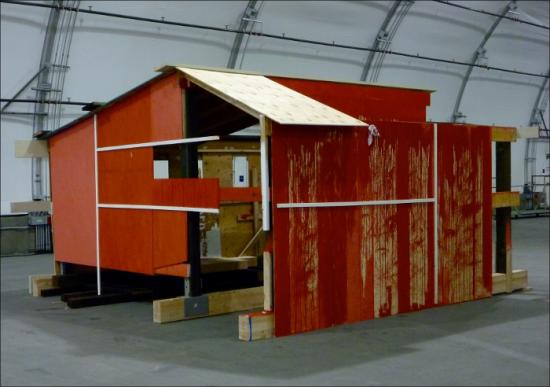
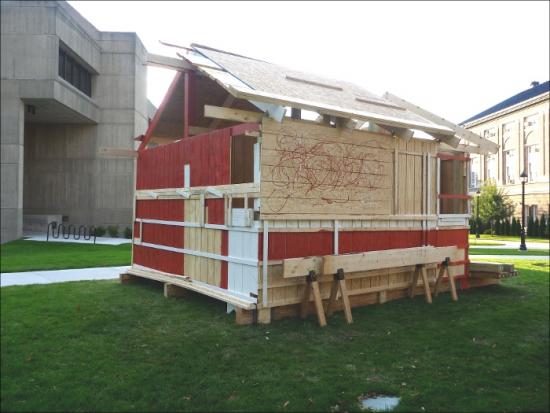
Tim and I had a few loose ground rules on how to approach the translation. One was that we would leave some things open to the interpretation of the crew. Another was that both Tim and I had our favorite poll questions that we tended to focus on. It was impossible to do everything as some polls conflicted with other but some details liked ghosts, dripped paint and open walls seemed to call out to us.
Kathleen Forde, who commissioned ARTBarn (East) for EMPAC, spoke about these details as where the work became more than the sculpture. The small details held the whole process – material, design polls, and performance together.
ED: I think this comment on the details is right. On first glance there is a fun, open appeal to the work. But when you look at the overall project and how the different phases are tied together it becomes really complicated in the mind of the spectator. There are also different definitions of spectator in this work. The spectator who answers the poll, the spectator on the net who is grazing through the documentation, the ones who engage in the physical construction and those who witness the completed barn. It’s not a simple piece when we perform a detailed overview. Did you think about the various types of spectator that would spin off the project? Were the possible roles for the spectator considered after the fact or were they part of the planned concept?
MR: The “ideal spectator” thought first came up for us in a project called Endnode (aka Printer Tree) in 2002. For this work, we built a large plywood Franken-tree with a set of printers in the branches and a computer in the trunk. We then built a list-serve for the tree as well as subscribed it to a few list-serves. When people communicated with the tree, the text was printed out in the exhibition space. At first we talked about the ideal viewer as one who communicated with it online and then saw that communication in the physical space or vice versa.

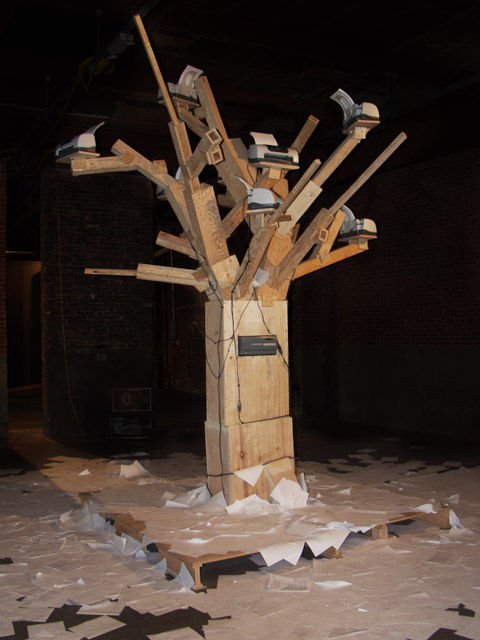
Now I feel that the ideal spectator hierarchy is not as important and possibly limiting. Each experience should be whole as well as point to the larger aspects of the work. People can come in and out of the work on different levels. You voted. You followed the performance documentation. Are you missing an experience if you did not build with us or see the results? Yes, an activity is missed. Can you experience that activity thorough documentation. Somewhat. Are you going to have a better understanding of the work. Probably not. Even for me, some aspect of the work will not be experienced. In Troy, they are programing it as a meeting place now that is it is built.. When they are done with it, they will dismantle it and rebuild it elsewhere as a work space.
I say all this even though it is interesting to me that a work can move in and out of levels of viewer experience. I’m not sure as to the draw of it yet but I do not feel it is about an cumulative effect.
TW: Since Endnode I’ve always liked the idea of an art work that exists in multiple (but overlapping) spaces with multiple (but overlapping) audiences. With our pieces Endnode, ARTBarn and Automatic For The People: () there are 3 distinct (but overlapping) audiences: the online audience, the audience in the physical space and the (select few member) audience that experiences the entire thing.
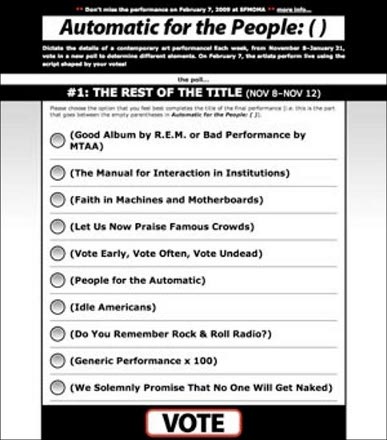
ED: It’s that opening of possibilities that makes this ultimately a networked piece on many different levels. I find the idea of two barns, a few thousand miles apart yet linked by common purpose really intriguing. I’m talking about the whole set of experiences, not just the physical space of the barn. There’s a collapse of Geographic distance for the community and a richer experience because of that. Was the project conceived as two distinct locations or was that a fortunate turn of events?
MR: Fortune. Kathleen Forde, commissioned ARTBarn (East) for EMPAC then Steve Dietz commissioned the beta version for the 01SJ “Out of the Garage ” exhibition. Everyone liked the idea of the work arching across time and location. We all also liked the idea that the materials would be reclaimed after it stopped being a sculpture. For me, the reclaimation of the materials to use for a functional structure is the final step of the work.
ED: As the final step, the reclamation removes the common space where the community currently shares the sculpture. Does this mean you are going to use the online documentation as the artifact, coming full circle to where the piece began? Is it important to you that the communal memory will share this role?
TW: Yes, the documentation is the artifact. The barn structure or sculpture itself had been conceived as being physically temporary from the beginning.
ED: Thanks to both of you for your time and for this work.
In 2002, when Monochrom was invited to act as the representative of Austria at the Sao Paulo Biennial, instead of going as yourselves, you sent Georg Paul Thomann, one of the country’s most prominent avant guard artists, and also a complete fabrication.
Yes, we were asked to represent the Republic of Austria at the Sao Paulo Art Biennial, Sao Paulo (Brazil) in 2002. However, the political climate in Austria (at that time, the center-right People’s Party had recently formed a coalition with Jorg Haider’s radical-right Austrian Freedom Party) gave us concerns about acting as wholehearted representatives of our bloody nation. We dealt with the conundrum by creating the persona of Georg P. Thomann, an irascible, controversial (and completely fictitious) artist of longstanding fame and renown. Through the implementation of this ironic mechanism – even the catalogue included the biography of the non-existent artist – we tried to solve with pure fiction the philosophical and bureaucratic dilemma attached to the system of representation.
It gave me something of a hearty guffaw to hear about how you and your fellows, manning the Austria country booth as the artist’s technical support staff – the lowliest of low in the art world hierarchy – went about revealing the fictitious nature of the artist.
Yes, we turned the tables. When members of the administration, journalists, or curators asked about the whereabouts of Thomann, our irritated answer was that he hadn’t cared to show up so far, and that he hadn’t helped with anything, because he was supposedly watching porn in his hotel room all day, while we – the members of his technical crew – didn’t care about that bullshit at all. But we informed other technical support teams about the basic idea of the project. They were also given detailed information about Thomann’s non-existence but we did not give them any hierarchic directives about what to do with their knowledge but left it up to them if they wanted to reveal the fake or keep spinning the story. Most people enjoyed doing the latter and they also kept telling different versions of the heard information until finally a bubbling geyser kept erupting in various ways and constantly led to new outbreaks of tittle-tattle.
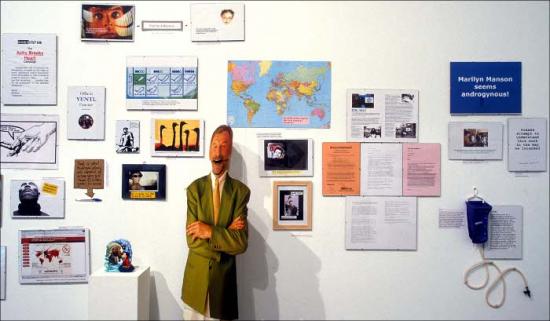
What happened next, as I heard you describe it, was that “bubbles and bubbles of rumors” began to form around the expansive floor of the biennial. I found this moment in the arc of the project to be particularly interesting and was hoping you could perhaps share some of your thoughts and recollections.
Let’s give you a brief summary of the background. The basic principles of an art-super-structure like a Biennial is simple: lots of little white boxes in which art was set up – and little artists, spreading business cards like prayers. There is a nice German term: “die Warenformigkeit des Kunstlers” (“the commodity value of the artist”). We hardly had any contact with other artists… and that was bad. They came from more than 80 different countries, but they were hiding in their white boxes. Everyone was busy building his or her own little world. Then, during the final setup phase we found out about an incident, which took place in our neighborhood through a copied note.
One year before the Biennial, Chien-Chi Chang had been invited to be the official representative of Taiwan at the Biennial. But then, three days before the opening, his caption – adhesive letters – had been removed from his cube virtually over night. ‘Taiwan’ was replaced with ‘Museum of Fine Arts Taipeh.’ But to Chien-Chi Chang the status as an official representative of Taiwan was very important, because his photography artwork dealt directly with the inhumane psychiatric system in Taiwan.

Chien-Chi was trying to get in contact with the Biennial administration and the chief curator (the German Alfons Hug), but didn’t succeed. Communication was refused. After that he decided to write an open letter, but the creative inhabitants of all the little white art-combs didn’t seem too interested in the artist’s chagrin, who by now wanted to leave the Biennial out of protest.
We were interested in the situation and did some research. We found out that the Chinese delegation had threatened to withdraw their contribution and to cause massive diplomatic problems. To them, Taiwan was clearly not an independent country (c/f ‘One China Policy’) and they put pressure on the Biennial management to get that message out. The management did not make this international scandal public and it was quite obvious why.
monochrom decided to show solidarity with Chien-Chi. We wanted to set an example and show that artists do not necessarily have to internalize the fragmentation and isolation that is being imposed upon them by the structure of the art market, the exhibition business, as well as the economy containing them. For us, though, this is not about taking a stand for either the westernized-economical imperialism represented by Taiwan or for China’s old-school Stalinist imperialism. This is about integrity and solidarity, values that we chose to express through a collaborative act. Together with other artists from various countries we launched a solidarity campaign: we took off some adhesive letters of each collaborating country’s signature and donated them to Chien-Chi Chang. monochrom sponsored the ‘t’ of Austria, while the Canadians donated one of their three as. The other participating artists were from Croatia, Singapore, Puerto Rico and Panama. A lot of artists and curators from other countries refused to support the campaign for fear of – as they would call it – “negative consequences.” WTF? But at least some of the artists were pulled out of their self-referential and insular national representation cubes which, in themselves, so rigorously symbolized the artists’ work and his or her persona as commodities.

After some time we managed to attach a trashy, yet legible ‘Taiwan’ to the outside wall of Chien-Chi Chan’s cube. Numerous journalists took notice of the campaign and Chien-Chi opened his exhibition in front of a cheering audience. Some days later, we found out that Chinese and Taiwanese newspapers massively covered the campaign. One Taiwanese paper used the headline “Austrian artist Georg Paul Thomann saves ‘Taiwan’.” In other words, a non-existing artist saved a country pressed into non-visibility. Who said that postmodernism can’t be radical?
What was it like – even from a kind of phenomenological sense – to be in the midst of this bubbling, to experience the formation of a scandal from its very embryonic moments? Is there something in the interiority of situations like this that you see as essential to the creation of new kinds of solidarity?
First we would have to define what “new kinds of solidarity” mean. What would be the ‘new’ part of it? Does it go beyond old and traditional forms of solidarity? And why should it? I think that classic forms of solidarity were carried out by political groups or other collective entities. They tried to express their (let’s label it as) “old-school solidarity” by pointing their collective fingers at someone who they thought were mistreated: “Look, look this human being is being oppressed!” And they always did it “in the name of something”. Old-school solidarity was one more frickin’ medium that people used to get a message across. Thus it was always part of the realm of representation. Your act of solidarity represents the one you show solidarity with, but your act is also advertisement for yourself, your cause and the (political) identity you wish to construct. Politics is always drama. Best example for this would be the “supporters of Palestine”. There are tons of ethnic groups on this rusty little planet who have to suffer under worse conditions. But nobody seems to be interested in showing solidarity with them. Where are Henning Mankell and Noam Chomsky when you really need them? Involved in some stupid fast-food anti-imperialism. We have to understand that the “object of solidarity” is something you pick for a reason… and most of the time it’s to feel good as a group and to impress your peers. But that has nothing to do with factual, non-reductionist political analysis. Collective entities define themselves through acts of representation and this representation is comparable to the construction of national pride or patriarchal family structures and values. Solidarity can be read as an act of defining identities. And that can be very dangerous, because old school solidarity always wants to be “right”. You are always “the good one” supporting the poor bastards. Smash dichotomies!
What we experienced at the Biennial of Sao Paulo back in the spring of 2002 was a very non-collective act. We were no real group, no leaflets, we had no common agenda, we were a psycho-geographic swarm. There was no basis for acting or speaking as a collective and there was no need to bundle our powers or form an identity. Yes, we tried to recruit other artists to join in our little act of solidarity. But it was no protest, we didn’t protest a certain political agenda because we didn’t want to end up in the old black and white world that, for example, all the apeshit Pro-Tibet supporters live in. Bah! Their ugly flags! Their patriarchal projections! Richard Gere! Yuck! So it was a kind of “free flowing solidarity”, not to be abused to form a political movement or statement. The only form of identity that was formed was the simple idea that even bourgeois artists can decide whether they want to be part of the Biennial and its stupid rules or whether they want to be part of action and fun.
To make it short: we are interested in micro-political solidarity, temporary solidarity that can’t fossilize. Solidarity is important if it can evolve and vanish within a short span of time and all that’s left is rumors and vague commemorations. Let’s call it a process of counteracting – that might be well-known in the field of the urban guerrilla but that so rarely pops up at art shows.
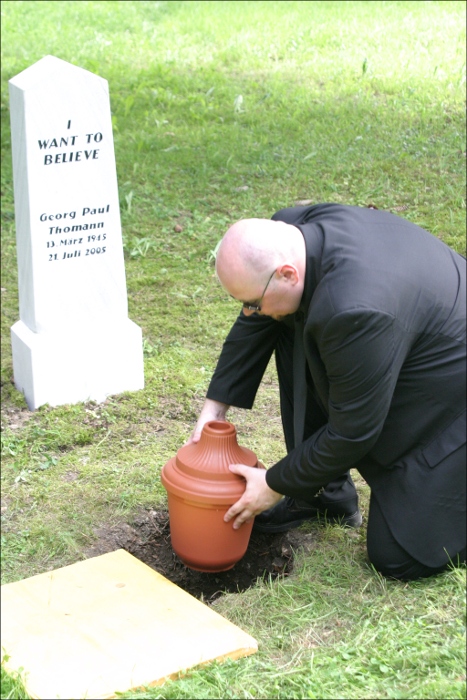
Read Part 1 of the Interview
http://www.furtherfield.org/interviews/interview-johannes-grenzfurthner-monochrom-part-1
Read Part 3 of the Interview
http://www.furtherfield.org/features/interviews/interview-johannes-grenzfurthner-monochrom-part-3
Between July 27th and August 29th, 2010, the eleventh edition of the FILE festival is taking place in Sao Paulo (Brazil), at several locations along the popular Paulista Avenue. After a decade of existence, this veteran festival, which spreads over several cities in Brazil (including Rio de Janeiro and Porto Alegre) as well as other international locations, has introduced for the first time its own award: the FILE PRIX LUX. With a total amount of approximately 120,000 euros, distributed in three categories, the prize is unprecedented in the continent and has received, on this first edition, 1,235 registrations from 44 countries.
Yet this award is not the only remarkable aspect of this year’s festival, which stands out for being particularly accessible to the general public. On the one hand, the exhibitions, performances and workshops as well as the symposium have no entrance fees, and therefore there have been many visitors, most of all young people who line up every day to experience the interactive installations at the FIESP-Ruth Cardoso Cultural Centre. On the other hand, the festival organizers, Ricardo Barreto and Paula Perissinotto, have developed this year a project that takes digital art to the Paulista Avenue by placing several interactive artworks at different locations in the public space. Finally, even the FILE PRIX LUX has been open to the interaction with the public by introducing a popular vote category and an online voting system which was accessible between May and June. This openness sets a good example of how media art festivals can engage the general public to approach this somewhat ignored form of art.
In general terms, the award categories at media art festivals have been subject to change as the creative uses of technology evolved during the last decades. The FILE PRIX LUX has the advantage of being created at a time in which it can be relatively safe to set up a few broad categories that cover most of the forms of combining art and technology. Only three categories have been established: Interactive Art (which usually refers to objects and installations that respond to inputs from the viewer/s), Digital Language (related to the festival’s title and which embraces any artwork that deals with language, narrative, code or text in a generative or interactive manner) and Electronic Sonority (the category assigned to any artwork in which the production or manipulation of sound is a key element). These three categories prove to be comprehensive, as shown by the diversity of the projects distinguished with a prize or an honorary mention: immersive interactive installations, musical performances, urban interventions, bioart pieces, a collectively created machinima movie and even an iPhone app are among this year’s FILE PRIX LUX awardees.
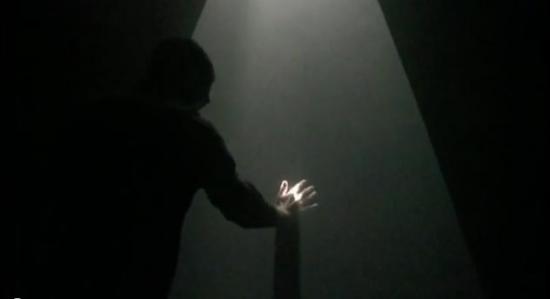
In the Interactive Art category, the winners are Ernesto Klar for Relational Lights (1st prize) and Kurt Henschläger for Zee (2nd prize). Both present immersive environments in which light and space are key elements, although the interaction is totally different. Klar’s work invites the viewer to interact with two projected geometric drawings inspired by the work of Lygia Clark. In a hazy dark room, the viewer sees two T-shaped projections of white light on the ground, which form a three-dimensional space which reacts to the visitor’s presence. The interaction is playful and really beautiful in its simplicity, whilst also limited in time: after a few minutes, the projections suddenly stop reacting to the user’s movements and reconfigure themselves in a new shape. This abrupt interruption is consciously introduced by the artist in order to remind the viewer that the artwork has a life of its own. In contrast, Henschläger’s Zee takes place mostly in the mind of an audience exposed to an overdose of audiovisual stimuli in a foggy room. Continuing the experience of his acclaimed performance FEED, this time the artist allows the viewer to walk around the space and have a more meditative sensory experience.
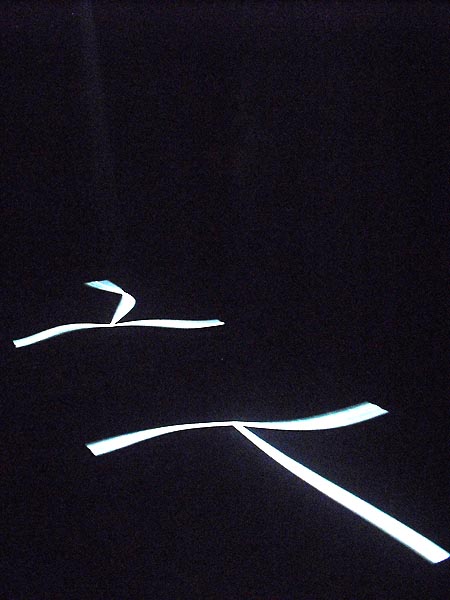
The Electronic Sonority category has brought together several outstanding works, among which Jaime E. Oliver’s Silent Percussion Project and TERMINALBEACH’s Heartchamber Orchestra have been distinguished with the 1st and 2nd prize, respectively. In both projects the human body is incorporated in a novel form in the creation of music, the sound being produced, moreover, not simply by direct inputs but by complex interactions in a constant flow of data. Oliver’s instruments convert the shapes created by the performer’s hands into streams of data that generate, in turn, different sounds. These sounds are not always the same, as could be the case in a traditional instrument, but are changed by the variables established in previous interactions. Thus, Oliver does not simply create a new form of interacting with an instrument but rather a new form of creating music. In a similar way, the [i]Heartchamber Orchestra[/i] project developed by TERMINALBEACH (Erich Berger and Peter Votava) explores a form of creating music based on a feedback loop in which the performers are writing and following the score at the same time. As the artists state, in their project “the music literally comes from the heart”: a network of 12 independent sensors record the heartbeats of the musicians in an orchestra and sends the data to a software that generates a musical score in real time. The musicians play the score as it is displayed on the laptops in front of them, while their heartbeats set the notes in a continuous cycle in which music and performer constantly influence each other.
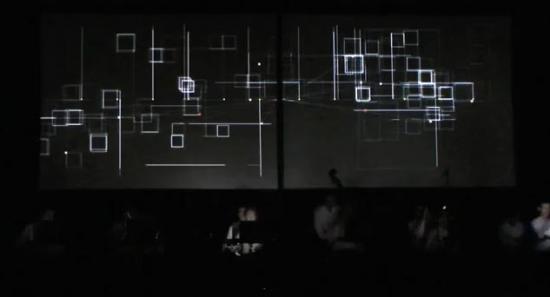
Digital Language is certainly the broadest category of this FILE PRIX LUX, its awardees being quite dissimilar in the formats they use and the objectives of their respective projects. The organizers define this category as including “all research and experiments in the ambit of the multiple disciplines that use digital media”, and the winners exemplify how diverse these disciplines can be. The 1st prize winner, Tardigotchi by the artists collective SWAMP (Douglas Easterly, Matt Kenyon and Tiago Rorke) is a bioart project that sets a critical comparison between artificial and real life. A nicely designed, steam punk-inspired device hosts, on the one hand, a tardigrade, a microorganism measuring half a millimeter in length, along with a robot arm that injects a substance that feeds the creature and a heating lamp that provides warmth. On the other hand, a digital display shows the virtual avatar of this tardigrade, with which the user can interact. Humorously referencing the popular Tamagotchi toy, the artists create a link between the avatar and the real creature: when the user presses the button to feed the avatar, the device inserts real food in the environment of the tardigrade; when an email is sent to the digital creature, a heating lamp gives warmth to the microorganism. Thus, interacting with the virtual pet has consequences in a real living being. This brings our attention into what we can consider alive and how we emotionally attach to artificial creatures while at the same time we undervalue the existence of other living beings. On a different approach, the 2nd prize winner, Hi! A Real Human Interface, by the collective Multitouch Barcelona (Dani Armengol, Roger Pujol, Xavier Vilar and Pol Pla), proposes a more human relationship with technology. A video presents the concept developed by this interaction design group of a different GUI in which a real person is displayed as impersonating the computer. Common interface elements are replaced by handmade physical objects which remind the aesthetics of a video by Michel Gondry. The result is a playful form of interaction in which simple operations such as checking email or upgrading the operating system are shown as actions carried on with real objects by a person inside a box. The proposal is engaging and certainly sets a departure from the old desktop concept, yet it remains unsure to what extend this type of interaction can be applied in a real operating system.
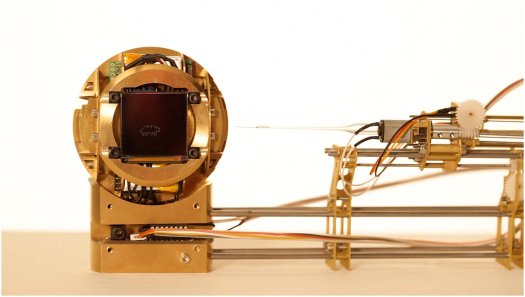
The works that obtained a Vesper statuette (symbol of the FILE PRIX LUX award) along with the also outstanding Honorary Mentions are exhibited at the FIESP-Ruth Cardoso Cultural Centre in a group show that also includes FILE Media Art, a selection of more than 70 works that can be accessed on several computers, as well as a selection of videogames and machinima films. The exhibition is thus richer in content than it would seem at first sight, as the space is divided in numerous sections that conceal several installations which demand (as usual) almost total obscurity. The artworks are well presented, although at times the sound from one installation invades the others, and there are no wall labels that inform the viewer about the concept of the piece or the way to interact with it. The latter, much-discussed issue is quite important, since the info-trainers cannot explain the artworks to every visitor, and quite often this entails that some people may not interact with the pieces or worse, start smashing buttons or interfering projections blindly in the hope of modifying them. Despite this fact, the exhibition has proven to be very successful during the first week of the festival, with a steady flow of visitors who showed a profound interest in the artworks.

A part of the exhibition is devoted to the FILE MACHINIMA section, curated by Fernanda Alburquerque, who selected over 40 works. Among these is the award winner in the Popular Vote category, War of Internet Addiction, by Corndog and the Oil Tiger Machinima Team from China, a 64-minute movie collectively created by players in the MMORPG War of Warcraft. More than mere entertainment, this film has been created as a form of protest against the Chinese authorities’ attempt to control the access and commercial benefits derived from the WoW game, which is extremely popular in the country. The film has had 10 million views since January 2010 and despite being available only in Chinese, it has been the favorite work of those who participated in the online voting system of the FILE PRIX LUX. Besides this feature film, other short films explore the possibilities of building narratives in virtual environments such as Second Life and videogames such as Half Life 2, Eve Online or Shadow of the Colossus.
In addition to the main exhibition, the FIESP Cultural Centre hosts a series of performances and screenings. Under the title Hypersonica, the festival presented a series of digital music performances, among which where the two winners of the FILE PRIX LUX in the Electronic Sonority category. FILE DOCUMENTA, curated by Eric Marke, offers in its 5th edition a selection of “rare and new” documentary films, among which Andreas Johnsen’s Good Copy Bad Copy, an interesting exploration of the conflicts between remix artists and copyright owners, or Robert Baca’s Welcome to Macintosh, which records the first years of the history of Apple Computers.
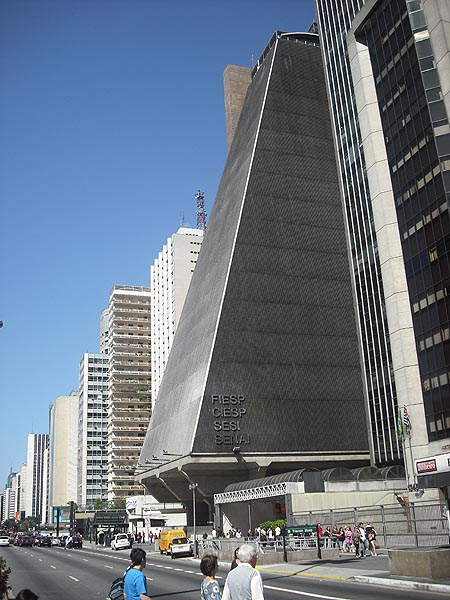
The symposium, hosted by the Instituto Cervantes in Sao Paulo, gathered several experts and artists who presented their explorations in the theory and practice of media art. Among the most interesting contributions were the presentation of Prof. Espen Aarseth on the aesthetics of ludo-narrative software, and the colloquy of South American digital art, in which Raquel Renno (Brazil), Jorge Hernandez, Ricardo Vega (Chile) and Vicky Messi (Argentina) discussed the current developments in the media art scene in the South Cone.
Alongside the FILE PRIX LUX, the most outstanding feature of the present edition of the festival is FILE PAI (Paulista Avenida Interactiva), which takes several interactive artworks to the public spaces in the Paulista Avenue. Interactive art offers the possibility of bringing art to the public space in a more efficient and dynamic form than what is usually known as “public art”. As Ricardo Barreto states: “the public environment is not something empty, aseptic and dead, as is the old white cube; on the contrary, it is an environment teeming with life, with multiple interests and multiple behaviors”. Interactive art integrates itself into this environment and is much more apt to relate to a public that is now willing to take an active role. The organizers of the FILE festival have distributed twelve interactive artworks along the Paulista Avenue, at subway stations, inside shopping malls, and even in a bus. The selected artworks include, among others, videogames such as Patrick Smith’s Windosill or the celebrated games of That Game Company, Flower and Flow; VR/Urban’s SMSlingshot, an urban intervention project that allows users to write a message in a custom-made slingshot that incorporates a screen and a keyboard and then send the message to a wall, where it is displayed as a virtual graffiti; Karolina Sobecka’s Sniff, an interactive projection in which a virtual dog reacts to the presence of passersby; the installations of Rejane Cantoni and Leonardo Crescenti Piso and Infinito ao Cubo, which attracted a large number of people, and the sound piece Omnibusonia Paulista by Vanderlei Lucentini, which is played in a bus as it moves along the avenue, interacting with several points in the itinerary and thus generating a new set of sounds in every trip. These works reveal the possibilities of integrating interactive art in the public space, to the point that, as Ricardo Barreto indicates, “the new paradigm of public art will be the interactive city”. The busy Paulista Avenue is certainly a good location for the creation of an emerging, interactive city.
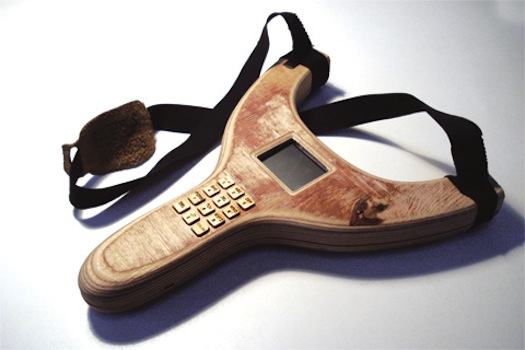
In this 11th edition, the FILE festival has achieved a state of maturity. The FILE PRIX LUX, FILE PAI and an estimated 25,000 visitors to date support its claim of being the largest festival of its kind in Latin America, and a steady event that places Brazil in the map of the international digital art scene. In a tightly interconnected world, each region is a node: there isn’t a center and a periphery anymore, there are no colonies. FILE exemplifies how a region can become a powerful node in this network by promoting the most recent developments in art and technology, avoiding obsolete distinctions between North and South and becoming a point of development for the future stages of our digital culture.
Co-published by Furtherfield and The Hyperliterature Exchange.
Last October I received an e-mail headed “Introducing Vook”:
The Vook Team is pleased to announce the launch of our first vooks, all published in partnership with Atria, an imprint of Simon & Schuster, Inc. These four titles… elegantly realize Vook’s mission: to blend a book with videos into one complete, instructive and entertaining story.
The e-mail also included a link to an article about Vooks in the New York Times:
Some publishers say this kind of multimedia hybrid is necessary to lure modern readers who crave something different. But reading experts question whether fiddling with the parameters of books ultimately degrades the act of reading…
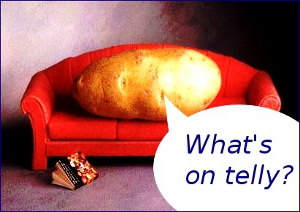
Note the rather loaded use of the words “lure”, “crave”, “fiddling” and “degrades”. The phraseology seems to suggest that modern readers are decadent and listless thrill-seekers who can scarcely summon the energy to glance at a line of text, let alone plough their way through an entire book. If an artistic medium doesn’t offer them some form of instant gratification – glamour, violence, excitement, pounding beats, lurid colours, instant melodrama – then it simply won’t get their attention. But publishers have a moral duty not to pander to their readers’ base appetites: the New York Times article ends by quoting a sceptical “traditional” author called Walter Mosley –
“Reading is one of the few experiences we have outside of relationships in which our cognitive abilities grow,” Mr. Mosley said. “And our cognitive abilities actually go backwards when we’re watching television or doing stuff on computers.”
In other words, reading from the printed page is better for your mental health than watching moving pictures on a screen: an argument which has been resurfacing in one form or another at least since television-watching started to dominate everyday life in the USA and Europe back in the 1950s. To some extent this is the self-defence of a book-loving and academically-inclined intelligensia against the indifference or hostility of popular culture – but in the context of a discussion of Vooks, it can also be interpreted as a cry of irritation from a publishing industry which is increasingly finding the ground being scooped from under its feet by younger, sexier, more attention-grabbing forms of entertainment.
The fact that the Vook publicity-email links to an article which is generally rather sniffy and unfavourable about the idea of combining video with print no doubt reflects a belief that all publicity is good publicity – but it is also indicative of the publishing industry’s mixed attitudes towards the digital revolution. On the whole, up until recently, they have tended to simply wish it would just go away; but they have also wished, sporadically, that they could grab themselves a piece of the action. But those publishers who have attempted to ride the digital surf rather than defy the tide have generally put their efforts and resources into re-packaging literature instead of re-thinking it: and the evidence of this is that the recent history of the publishing industry is littered with ebooks and e-readers, whereas attempts to exploit the digital environment by combining text with other media in new ways have generally been ignored by the publishing mainstream, and have therefore remained confined to the academic and experimental fringes.
The publishing industry’s determination to make the digital revolution go away by ignoring it has been even more evident in the UK than in the US. The 1997 edition of The Writers’ and Artists’ Yearbook, for example, contains no references to ebooks or digital publishing whatsoever, although it does contain items about word-processing and dot-matrix printers. On the other hand, Wired magazine was already publishing an in-depth article about ebooks in 1998 (“Ex Libris” by Steve Silberman, http://www.wired.com/wired/archive/6.07/es_ebooks.html) which describes the genesis of the SoftBook, the RocketBook and the EveryBook, as well as alluding to their predecessor, the Sony BookMan (launched in 1991). Even in the USA, however, enthusiasm for ebooks took a tremendous knock from the dot-com crash of 2000. Stephen Cole, writing about ebooks in the 2010 edition of The Writers’ and Artists’ Yearbook, summarises their history as follows:
Ebook devices first appeared as reading gadgets in science fiction novels and television series… But it was not until the late 1990s that dedicated ebook devices were marketed commercially in the USA… A stock market correction in 2000, combined with the generally poor adoption of downloadable books, sapped all available investment capital away from internet technology companies, leaving a wasteland of broken dreams in its wake. Over the next two years, over a billion dollars was written off the value of ebook companies, large and small.
After 2000, there was a widely-held view (which I shared) that the ebook experiment had been tried and failed: paper books were a superb piece of technology, and perhaps a digital replacement for them was simply never going to happen. There were numerous problems with ebooks: too many different and incompatible formats, too difficult to bookmark, screens hard to read in direct sunlight, couldn’t be taken into the bath, etc. But ebooks have always had a couple of big points in their favour – you can store hundreds on a computer, whereas the same books in paper form demand both physical space and shelving, you can find them quickly once you’ve got them, and they’re cheap to produce and deliver. Despite the dot-com crash and general indifference of the reading public, publishers continued to bring out electronic editions of books, and a small but growing number of people continued to download them.
Things really started to change with the launch of Amazon’s Kindle First Generation in 2007. It sold out in five and a half hours. With the Kindle, the e-reader went wireless. Instead of having to buy books on CDs or cartridges and slot them into hand-helds, or download them onto computers and then transfer them, readers using the Kindle could go right online using a dedicated network called the Whispernet, and get themselves content from the Kindle store.
Despite this big step forward, the Kindle was still an old-school e-reader in some respects: it had a black and white display, and very limited multimedia capabilities. The Apple iPad changed the rules again when it was launched in April 2010. The iPad isn’t just an e-reader – it’s “a tablet computer… particularly marketed for consumption of media such as books and periodicals, movies, music, and games, and for general web and e-mail access” (Wikipedia, http://en.wikipedia.org/wiki/I-pad). Its display screen is in colour, and it can play MP3s and videos or browse the Web as well as displaying text. For another thing, it goes a long way towards scrapping the rule that each e-reader can only display books in its own proprietary format. The iPad has its own bookstore – iBooks – but it also runs a Kindle app, meaning that iPad owners can buy and display Kindle content if they wish.
It seems we may finally be reaching the point where ebooks are going to pose a genuine challenge to print-and-paper. Amazon have just announced that Stieg Larsson’s The Girl with the Dragon Tattoo has become the first ebook to sell more than a million copies; and also that they are now selling more copies of ebooks than books in hardcover.
It is certainly also significant that the past couple of years have seen a sudden upsurge of interest in the question of who owns the rights over digitised book content, and whether ordinary copyright laws apply to online text – a debate which has been brought to the boil by a court case brought against Google in 2005 by the Authors Guild of America.

In 2002, under the title of “The Google Books Library Project”, Google began to digitise the collections of a number of university libraries in the USA (with the libraries’ agreement). Google describes this project as being “like a card catalogue” – in other words, primarily displaying bibliographic information about books rather than their actual contents. “The Library Project’s aim is simple”, says Google: “make it easier for people to find relevant books – specifically, books they wouldn’t find any other way such as those that are out of print – while carefully respecting authors’ and publishers’ copyrights.” They do concede, however, that the project includes more than bibliographic information in some instances: “If the book is out of copyright, you’ll be able to view and download the entire book.” (http://books.google.com/googlebooks/library.html)
In 2004 Google launched Book Search, which is described as “a book marketing program”, but structured in a very similar way to the Library Project: displaying “basic bibliographic information about the book plus a few snippets”; or a “limited preview” if the copyright holder has given permission, or full texts for books which are out of copyright – in all cases with links to places online where the books can be bought. Interestingly, my own book Outcasts from Eden is viewable online in its entirety, although it is neither out of copyright nor out of print, which casts a certain amount of doubt on Google’s claim to be “carefully respecting authors’ and publishers’ copyrights”.
In 2005 the Authors Guild of America, closely followed by the Association of American Publishers, took Google to court on the basis that books in copyright were being digitised – and short extracts shown – without the agreement of the rightsholders. Google suspended its digitisation programme but responded that displaying “snippets” of copyright text was “fair use” under American copyright law. In October 2008 Google agreed to pay $125 million to settle the lawsuit – $45.5 million in legal fees, $45 million to “rightsholders” whose rights had already been infringed, and “$34.5 million to create a Book Rights Registry, a form of copyright collective to collect revenues from Google and dispense them to the rightsholders. In exchange, the agreement released Google and its library partners from liability for its book digitization.” (http://en.wikipedia.org/wiki/Google_Book_Search_Settlement_Agreement). The settlement was queried by the Department of Justice, and a revised version was published in November 2009, which is still awaiting approval at the time of writing.
The settlement is a complex one, but its most important provision as regards the future of publishing seems to be that “Google is authorised to sell online access to books (but only to users in the USA). For example, it can sell subscriptions to its database of digitised books to institutions and can sell online access to individual books.” 63% of the revenue thus generated must be passed on to “rightsholders” via the new Registry. “The settlement does not allow Google or its licensees to print copies of books in copyright.” (“The Google Settlement” by Mark Le Fanu, The Writers’ and Artists’ Yearbook 2010, pp. 631-635).
Google, it will be noted, are now legally within their rights to continue their digitisation programme. This means they don’t have to ask anyone’s permission before they digitise work. If authors or publishers would prefer not to be listed by Google it is up to them to lodge an objection online. Google would argue that in launching their Library Project and Books Search they have merely been seeking to make their search facilities more complete, and thus to “make it easier for people to find relevant books” – but whether or not they have been deliberately plotting their course with wider strategic issues in mind, the end result has been to make them the biggest single player – almost the monopoly-holder – where digital book rights are concerned. As a reflection of this, an organisation called the Open Book Alliance has been set up to oppose the settlement, supported by the likes of Amazon and Yahoo: “In short,” their website claims, “Google’s book digitization strategy in the U.S. has focused on creating an impenetrable content monopoly that violates copyright laws and builds an unfair and legally insurmountable lead over competitors.” (http://www.openbookalliance.org/)
Whatever the pros and cons of the Google Settlement, it has undoubtedly helped to focus the minds of writers and publishers alike on the question of digital rights. Copyright laws and publishers’ contracts were designed to deal with print and paper, and until very recently there has been almost no reference at all to electronic publication. Writers who have agreed terms with a publisher for reproduction of their work in print have theoretically been at liberty to re-publish the same work on their own websites, or perhaps even to collect another fee for it from a digital publisher; and conversely, publishers who have signed a contract to bring out an author’s work in print have sometimes felt free to reproduce it electronically as well, without asking the writer’s permission or paying any extra money.
But things are beginning to change. A June 2010 article in The Bookseller notes that Andrew Wylie, one of the most prestigious of UK literary agents, “is threatening to bypass publishers and license his authors’ ebook rights directly to Google, Amazon or Apple because he is unhappy with publishers’ terms.” This is partly because he believes electronic rights are being sold too cheaply to the likes of Apple: “The music industry did itself in by taking its profitability and allocating it to device holders… Why should someone who makes a machine – the iPod, which is the contemporary equivalent of a jukebox – take all the profit?” Clearly, electronic rights are going to be taken much more seriously from now on.
Further indications that authors, publishers and agents are beginning to wake up and smell the digital coffee can be found in the latest editions of The Writers’ and Artists’ Yearbook and The Writers’ Handbook. For those who are unfamiliar with them, these annual publications are the UK’s two main guides to the writing industry. The 2010 edition of The Writer’s Handbook opens with a keynote article from the editor, Barry Turner, entitled “And Then There was Google”. As the title indicates, its main subject is the Google settlement and its implications – but its broader theme is that the book trade has been ignoring the digital revolution for too long, and can afford to do so no longer:
In the States… sales of e-books are increasing by 50 per cent per year while conventional book sales are static. An indication of what is in store was provided at last year’s Frankfurt Book Fair where a survey of book-buying professionals found that 40 per cent believe that digital sales, regardless of format, will surpass ink on paper within a decade.

The Writers’ and Artists’ Yearbook is more conservative in tone, but if anything its coverage is more in-depth. It has an entire section titled “Writers and Artists Online”, which leads with an article about the Google settlement. In addition there are articles on “Marketing Yourself Online”, “E-publishing” and “Ebooks”. Even in the more general sections of the Yearbook there is a widespread awareness of how digital developments are affecting the book trade. For example, there is a review (by Tom Tivnan) of the previous twelve months in the publishing industry, which acknowledges the importance not just of ebooks but print-on-demand:
Amazon’s increasing power underscores how crucial the digital arena is for publishing… Ebooks remain a miniscule part of the market,… yet publishers and booksellers say they are pleasantly surprised at the amount of sales… And it is not all ebooks. The rise of print-on-demand (POD) technology (basically keeping digital files of books to be printed only when a customer orders it) means that the so-called “long tail” has lengthened, with books rarely going out of print… POD may soon be coming to your local bookshop. In April 2009, academic chain Blackwell had the UK launch of the snazzy in-store Espresso POD machine, which can print a book in about four minutes…
There is also an article about “Books Published from Blogs” (by Scott Pack):
Agents are proving quite proactive when it comes to bloggers. Some of the more savvy ones are identifying blogs with a buzz behind them and approaching the authors with the lure of a possible book deal… Many bestsellers in the years to come will have started out online.
Most of the emphasis in these articles falls on the impact which digital developments are having on the marketing of books rather than the practice of writing itself. But now and again there are signs of a creeping awareness that digitisation may actually change the ways in which our literature is created and consumed. In The Writer’s Handbook, Barry Turner attempts to predict how the digital environment may affect the practice of writing in the coming years:
Those of us who make any sort of livng from writing will have to get used to a whole new way of reaching out to readers. Start with the novel. Most fiction comes in king-sized packages… Publishers demand a product that looks value for money… But all will be different when we get into e-books. There will be no obvious advantage in stretching out a novel because size will not be immediately apparent… Expect the short story to make a comeback… The two categories of books in the forefront of change are reference and travel. Their survival… is tied to a combination of online and print. Any reference or travel book without a website is in trouble, maybe not now, but soon.
Scott Pack’s article on “Books Published from Blogs” tends to focus on those aspects of a blog which may need remoulding to suit publication in book form; but an article by Isabella Pereira entitled “Writing a blog” is more enthusiastic about the blog as a form in its own right:
The glory of blogging lies not just in its immediacy but in its lack of rules… The best bloggers can open a window into private worlds and passions, or provide a blast of fresh air in an era when corporate giants control most of our media… Use lots of links – links uniquely enrich writing for the web and readers expect them… What about pictures? You can get away without them but it would be a shame not to use photos to make the most of the web’s all-singing, all-dancing capacities.
Even here, however, the advice stops short of videos, sound-effects or animations. Another article in The Writers’ and Artists’ Handbook (“Setting up a Website”, by Jane Dorner) specifically forbids the use of animations:
Bullet points or graphic elements help pick out key words but animations should be avoided. Studies show that the message is lost when television images fail to reinforce spoken words. The same is true of the web.
It’s a little difficult to fathom exactly what point Dorner is trying to make here, but it seems to be something along the lines that using more than one medium may have a distracting rather than enhancing effect. If the spoken words on your television are telling you one thing, but the pictures are telling you another, then “the message is lost”. Perhaps a more interesting point, however, is where Dorner draws her dividing-line between acceptable and unacceptable practice. “Bullet points or graphic elements” are all right, because they “help pick out key words”, but “animations should be avoided”. In other words visual aids are all very well as long as they remain to subservient to text. They minute they threaten to replace it as the focus of attention, they become undesireable.
Clearly this point of view continues to enjoy a lot of support, particularly from traditionalists in the writing and publishing industries. All the same, combinations of text with other media may be about to enjoy some kind of vogue; and the development of the Vook brand since its launch last October is an instructive case-history in this regard.
When Vooks were first launched it seems fair to say that they were broadly greeted with a mixture of indifference and scorn. Reviews which appeared in the first couple of months after the launch were usually either lukewarm of downright unfavourable. Here, for example, is one from Janet Cloninger, writing in The Gadgeteer, November 2009:
So how were the video clips? Have you ever seen any of those old 60s TV shows where they were trying to show a bad acid trip? You know the crazy camera work, the weird color changes, the really bad acting?… I don’t think they added anything to the story at all… I found they were very distracting while trying to read.
Here is another from the Institute for the Future of the Book:
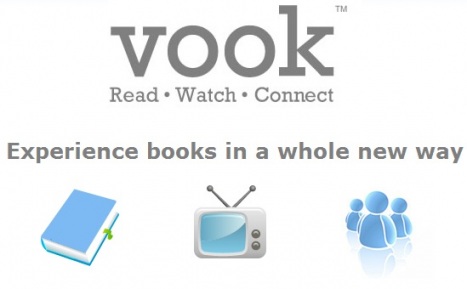
In terms of form the result is ho-hum in the extreme, particularly as there doesn’t seem to be much attempt to integrate the text and the banal video, which seems to exist simply to pretty-up the pages.
Following on from this generally unenthusiastic reception for the first Vooks, news about the brand over the next few months seemed to suggest that it was struggling to establish itself. In January 2010 Vook announced that they were publishing a range of “classic” titles, mostly for children – since “classic” normally means “out of copyright”, this seemed to imply that they were trying to boost their titles-list on the cheap. In February there was an announcement that Vook had raised an extra $2.5 million in “seed-financing” from a number of Silicon Valley and New York investors, suggesting that perhaps initial sales had been disappointing, Simon & Schuster had been reluctant to put up more money, and new sources of finance had therefore been sought.
With the launch of the iPad, however, it became obvious that Vook was making another throw of the dice. In April they launched 19 titles specially adapted for the iPad: In a statement, Bradley Inman, Vook CEO and founder said, “We will remember the iPad launch as the day that the publishing industry officially made the leap to mixed-media digital formats and never looked back…” The Vook blog makes this pinning-of-hopes on the iPad even more apparent:
The release of the iPad this Saturday was not just a red letter moment for Silicon Valley, it marked a turning point for the publishing and film industries, and a great opportunity for those invested in the future of media. The team at Vook has been working hard for months to prepare apps for submission to Apple… In many ways, it seems like the iPad was literally made for us…
And it seems their hopes may not have been misplaced. In May they launched a title about Guns’n’Roses (Reckless Road, documenting the creation of the Appetite for Destruction album), and lo and behold it was favourably greeted:
…unprecedented photos and memorabilia from the early years of one of the great rock bands from the 1980s and 1990s… If you are a true hard rock fan, and Guns ‘N’ Roses was one of your favorite bands, this app is worth the try. (PadGadget)
Now that I’ve had some time to read through Reckless Road and watch many of the videos included in it I can see the value of the Vook approach. It lends itself well to a product like this… This is an app any Guns N’ Roses fan would greatly appreciate. (Joe Wickert)
In June, the Vook version of Brad Meltzer’s bestseller Heroes for my Son was also favourably received:
It is easy to see the tremendous possibilities in the Vook format, especially when tied to a tablet device like the iPad. I very much enjoyed my first experience with a Vook mainly because I rapidly dropped my attempt to think of it as a Book with video plug ins. A Vook is really a multimedia platform that centers around text, rather than a traditional book. (MobilitySite)
Both these books are non-fiction – a genre in which the relationship between video footage and text seems far less problematic. It is interesting to note, however, that in both cases the non-linear structure of the Vook is singled out as a positive feature, compared to the sequential organisation of a traditional book:
It is charmingly non-linear and can be approached from many different angles. More a chocolate box than a book, especially if you are like me and enjoy really digging down into a subject while reading. (MobilitySite)
Remember that old VH1 series, Behind the Music? Canter’s Vook app feels like a modern version of that approach, with the added benefit that you can hop around the story to your heart’s content… (Joe Wickert)
There are hints here of a realisation that digital media can sometimes offer kinds of reading which are unavailable to, or hampered by, traditional print-and-paper.
Further recognition that ebooks with multimedia in them might actually have market appeal came at the end of June from none other than Amazon, who announced that they were adding audio and video to the Kindle iPhone/iPad app. The irony of this move is, of course, that Kindle ebooks are now multimedia-capable on the iPhone and iPad but not on the Kindle itself – an irony which can hardly be allowed to continue, and which therefore doubtless presages the launch of a multimedia Kindle some time in the near future.
Of course, the story of multimedia innovation in literature goes back much further than Vooks and the iPad. The British writer Andy Campbell, for example, has been publishing his own new media fiction online for years – most recently on the Dreaming Methods website. Most of his work has been designed in Flash, which the iPad unfortunately does not support. He therefore finds himself in the one-step-forward-and-two-steps-back position where new media literature is finally starting to make some headway in the marketplace, but thanks to a whim of the Apple corporation his own work in the field, developed over more than a decade, been landed with a big disadvantage. Understandably, his feelings are mixed:
It does indeed seem like there is a shift going on with digital fiction, although there are still a large number of stumbling blocks from a development point of view… Whilst the potential of the iPhone and iPad is undoubtedly exciting, a lot of authors – including myself – do not work with Macs or have the programming experience required to produce Apple-happy content…. However that’s from the point of view of Apple dominating the market and forcing everyone to use their SDK, whilst in actual fact Android holds considerable promise… I wouldn’t say digital fiction is breaking through into the mainstream – although perhaps it depends what you mean by digital fiction… Whether anything has been produced that really takes reading as an experience to a new level, I’m not sure.
Since Flash has hitherto been one of the main tools used by new media writers and artists, many of them will now find themselves in the same predicament as Campbell – and many of them will doubtless be hoping, like him, that alternative platforms such as Android are going to make some headway in the coming months. But leaving the question of platforms on one side, another difficulty for existing new media writers seems to be that although publishers are suddenly discovering a new enthusiasm for the form, they have very little knowledge or understanding of the work which has already been done, and very few links with those who have been doing it. Nor is this entirely the publishers’ fault, because there seems to be a genuine cultural divide between those who work in the publishing industry and those who take an interest in new media literature. Emily Williams of Digital Book World alludes to this divide in her article about this year’s London Book Fair (“Old London vs. New Media”, April 2010):
In most [publishing] houses, the digital innovators are still operating on a parallel plane, touching on but not fully integrated into the publishers’ core business centers. This segregation is so complete that much of the digital crowd is liable to skip the traditional fairs altogether, gravitating instead to their own tech confabs (which are in turn often boycotted by, or unknown to, the bookish folk).
Michael Bhaskar, a publisher and one of the judges of the Poole Literary Festival’s New Media Writing Prize, makes a similar point in his blog:
There has been no real conversation between the two [publishers and new media writers]. Why? It seems like we should have hit the meeting point where there could and should be a productive alliance, when in fact the gulf seems as wide as ever… Publishers have to sell books – or something – to keep going… [whereas] much new media writing is not designed to be commercial, being associated with a more recondite and experimental mindset.
In other words, publishers and new media writers have failed to come together, not simply because publishers have been hoping for the digital revolution to go away, nor because new media writers have been go-it-alone experimentalists, but because culturally they have belonged to different worlds, moved in different circles and spoken different languages.
Even assuming that these difficulties can be overcome, it is open to doubt whether new media writers will necessarily want to throw themselves headlong into the commercial mainstream. Many of them, like Andy Campbell, have been going it alone for so long that the habit of independence may be difficult to shake. Undoubtedly a bit of money would be very welcome, but advice from marketing men about how to make their work more commercial might be less well-received. On the publishing side of the equasion, however, there are definite signs that things are starting to change. Experimentation was the buzzword of the 2010 London Book Fair:
The publishing industry must move at speed to adopt new business models and new ways of working if it is to seize the opportunities of the digital revolution, delegates were told at London Book Fair… Industry figures focused on the need to experiment and to get a real understanding of what consumers want from the new technologies in a fast-changing environment. (The Bookseller)

There are also signs that the influence of digital technology on writing now extends beyond the software-savvy fringe, and is starting to affect the ways in which less specialised writers create their work. One of the surprize best-sellers of last year was a book called Important Artifacts and Personal Property from the Collection of Lenore Doolan and Harold Morris, Including Books, Street Fashion and Jewellery, by Leanne Shapton, which (as the title suggests) takes the form of an auction catalogue, selling off the belongings of a fictional couple. As befits an auction catalogue, the book consists of photographs of the articles for sale, accompanied by snippets of text –
Lot 1231: Two pairs of white shoes. Two pairs of white bucks. The label inside the men’s pair reads “Prada”, the women’s reads “Toast”. Sizes men’s 11, women’s 9. Well worn. $40-60.
The artefacts in the catalogue are arranged in chronological order, which makes it easier for them to tell the story of the couple’s love-affair; but despite this concession to linearity what is striking about the novel, to anyone who has had very much to do with new media literature, is how like a piece of new media literature it is. Experimental it may be as a novel in print, but as a piece of digital writing it would be fairly conventional, albeit unusually well-put-together. It was obviously composed as collection of objects and pictures as much as a a piece of written text; there is no conventional dialogue or storytelling; despite its chronological sequence there is a strong non-linear element to the book, a feeling that it is as much designed to be dipped and skimmed as to be read from one end to the other; it makes a knowing reference to Raymond Queneau, the Oulipo writer; and in many ways it would be more at home on the Web, where the pictures could be in full colour and zoomable at no extra expense.
Another example of the influence of digital technology on “ordinary” literature comes from the small-scale end of the publishing industry – Martha Deed’s poetry chapbook The Lost Shoe, which was published earlier this year by Dan Waber at Naissance Chapbooks (about whom, more in a moment). The first point to note about this collection is that in order to publicise it Martha made a video, also called “The Lost Shoe” (http://www.sporkworld.org/Deed/lostshoe.mov), which deserves to be thought of as a companion-piece rather than a “trailer”. The poems in the collection are based on Martha’s experiences as a psychologist specialising in family law – more specifically, they deal with cases in which family members have done violence to each other, and some of them are harrowingly raw:
Upstairs, he tried twice to change his clothes
his fingers slippery with your blood…
You were looking at him
the last person you saw before your death
It bothered him, that lifeless stare,
so he stepped over your mother
your dying baby sister
and tried to close your eyes…
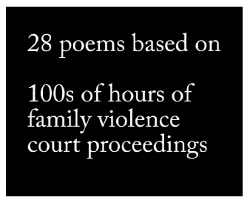
The video has the same combination of near-documentary authenticity and artistic control. It starts with a 911 telephone call from a man who has harmed his own children. There is a terrible moment when he is asked what has happened and he breaks into hysterical tears and says “They got stabbed”, as if somebody else might have done it. It ends with Martha reading aloud from one of her own poems, “Practice Tips”, which is based on the Center for Criminal Justice Advocacy‘s “Criminal Pre-Trial and Trial Practice”:
Play the tape 10 times at trial.
The jury will become accustomed to the carnage…
Obfuscate. Whine. Grandstand.
Fumble with your papers.
The fact that Martha feels equally at home working with both the written word and the camera, and therefore feels able to shoot her own video as a means of publicising her collection of poems, is an indication of the way in which digital technology is beginning to influence literary practice at grass-roots level. But the influence goes further. As well as conventional verse, her collection contains a number of visual poems – you could almost call them diagram poems – combining text with graphic design. “Jury Pool”, for example, shows a number of black stick-figures in and around the jury pool, labelled with reasons why they have been disqualified from the jury, or factors which will influence their outlook on the case: “Have to go back to school”, “Ate lunch with defendant’s mother”, “Crime victim”, “Don’t understand English”, and so forth. Including a diagram-poem such as this in a collection of poetry would not have been impossible before digital technology came along, but the fact that software packages such as Microsoft Word and Open Office Writer can handle images as easily as text, and make it simple to customise page-design without incurring any extra cost, means that poets now have an enormous range of experimental possibilities constantly at their fingertips.
Furthermore a lot of writers haven’t just moved beyond the pen or the portable typewriter to computers and word processing software; they have moved on to such things as blogs and web-pages, which have built-in multimedia capabilities. Sound-files and videos are rapidly becoming a normal part of the amateur writer’s working environment, and as a result the combination of text with other media is becoming a grassroots staple rather than a specialists-only field.
The Lost Shoeis published by Naissance Chapbooks, run by Dan Waber. A glance through Waber’s catalogue is enough to confirm the effect which digital technology is starting to have on poetic style. Amongst more formally conventional poetry he publishes, for example, Psychosis by Steve Giasson, which is based on comments collected by a YouTube posting of the shower scene from Psycho:
kthevsd Lame movies ? Kid I like all movies, old films, new films, etc. How is this classic lame ? Have you even ever watched it ? What would some 16 year old teenybopper know about cinema ? You probably have never even heard of Kurosawa and I bet you have never even seen a Daniel Day Lewis or Meryl Streep movie in your life. No wonder everyone laughs at your generations taste…
Or there is a collection by Jenny Hill called Regular Expressions: the Facebook status update poems –
Ron: I delivered a fucking BABY tonight! Yep, a fucking BABY!!!!!!!!! what did
u do today? Nursing school is AWESOME!!!!!!!
Someone asks if it was slimy, another wants
the placenta, most are stumped
at how to comment
on all your exclamation marks.
Then there is Watching the Windows Sleep by Tantra Bensko, which combines “fiction, poetry, and photographs”; or Open your I by endwar, which is “at times concrete, at times typoem, at times visual poem, at times conceptual poem, at times typewriter poem”. It is clear that the digital revolution has affected all of these collections in one way or another – either by making a wider range of experimental options available, or by providing them with their inspiration and subject-matter.
Of course, these are atypical exhibits, because Dan Waber, the publisher, is clearly interested in adventurous and experimental kinds of poetry. He also publishes a series called “This is Visual Poetry“, which now runs to about fifty full-colour booklets of visual poems, “answering the question [What is visual poetry?] one full-color chapbook at a time”, and answering it extremely variously. All the same, even allowing for Waber’s adventurous tastes, the fact that within a couple of years he has managed to put together fifty chapbooks of visual poetry, plus nineteen “conventional” poetry collections which often show clear signs of technological influence, is strongly suggestive of the directon in which things are moving.
Just as noteworthy is the business-model behind Waber’s publishing ventures. Basically, his operation relies on three key elements. The first is print-on-demand technology, which has almost completely done away with the printing expertise on which book production used to rely. These days, as long as writers can produce a competently-laid-out electronic original it can be turned into a book at the touch of a button. Colour reproduction is slightly more expensive than black-and-white, but not prohibitively so. Standards of reproduction are undoubtedly lower than they would be in the hands of a specialist printer, but most people never notice the difference. Self-publishing ventures such as Lulu (www.lulu.com) rely on this kind of print-on-demand process, and although Waber sends his electronic originals to the local print shop rather than using a completely automated online process, the technology is the same.
However, whereas the Lulu publishing process involves quite a bit of donkeywork (and usually a crash course in book-design and pagination) on the part of the author, the second key element of Waber’s publishing model is a drastically simplified and stringent set of layout criteria. Submissions to the visual poetry series must be “17 color images of visual poems of yours that are 600 pixels wide by 800 pixels tall”; and submissions to the Naissance chapbook series must be a maximum of 48 pages, in A4 portrait layout, with specified page-margins. Waber has designed a macro which takes Word files laid out according to these specifications and converts them instantaneously into print-ready book originals. This means that responsibility for the page layout is left squarely with the author – as Waber’s guidelines say, “all you need to do is make each page look how you want it to look… and we’ll convert it” – with the added effect that as long as authors stay within the guidelines, they are free to experiment as much as they like.
This combination of strict limitations and artistic freedom has undoubtedly helped to foster some of the adventurous design his chapbook series displays. At the same time, however, Waber has eliminated so much complexity from the publishing process that the third key element of the business model looks after itself: his costs (including time-costs) have come right down, to the point where he can show a modest profit on print-runs as low as ten units. All he has to do is decide whether he wants to publish something: if he does, he runs his macro, sends his print-ready file to the printer, and has ten copies of the chapbook in his hands within 24 hours. As he writes with understandable pride:
The beauty in all of this is no cash outlay. No huge print runs. No wondering if there’s grant money to support it, no worrying if it’ll actually sell enough to cover costs. It’s all profit after one copy sells… I am in a situation where because I make money off of every book I publish, all I need to do is find more books to publish. Because I de-complexified the process so completely.
Waber believes that his kind of venture represents the way forward for literary publishing in the era of digital technology, and he also believes that it is the kind of solution which can probably only come from outside the existing print industry, not from inside, because, as he puts it, “Big Publishing has a model that is blockbuster-based”. To explain this more fully, he cites an article by Clay Shirkey called “The Collapse of Complex Business Models“, which argues that big and complex businesses become unable to adapt to new circumstances, because their ideas about how they should operate become culturally embedded. If the new circumstances are sufficiently challenging then the only way forward will be for big organisations to collapse, and for new small ones, without the same culturally embedded assumptions, to take their place.
When ecosystems change and inflexible institutions collapse, their members disperse, abandoning old beliefs, trying new things, making their living in different ways than they used to… when the ecosystem stops rewarding complexity, it is the people who figure out how to work simply in the present, rather than the people who mastered the complexities of the past, who get to say what happens in the future.
This, argues Waber, is likely to be the ultimate effect of the digital revolution on the publishing industry; not simply dramatic changes in publishing formats and marketing methods, but a complete collapse of “Big Publishing”, and a multitude of small-scale, dynamic new ventures like his own, growing up out of the wreckage.
Clearly this is something that publishers themselves are worried about. As Michael Bhaskar writes in his blog for The Poole Literary Festival’s New Media Writing Prize,
On the writing side I often hear that people feel ignored by publishers.Essentially the world of commercial publishing is a closed shop unwilling to listen to the maverick, the outsider and the original, and will ultimately pay for this as audiences gravitate to newer and amorphous forms… This might be an argument for by-passing publishers or intermediaries altogether… [but] what I would like is mediation.
Clay Shirkey quotes the example of the “Charley bit my finger” video on YouTube to illustrate how production values have changed:
The most watched minute of video made in the last five years shows baby Charlie biting his brother’s finger… made by amateurs, in one take, with a lousy camera… Not one dime changed hands anywhere between creator, host, and viewers. A world where that is the kind of thing that just happens from time to time is a world where complexity is neither an absolute requirement nor an automatic advantage.

The “not one dime changed hands anywhere” line is perhaps a bit of an oversimplification. Wikipedia notes that “According to The Times, web experts believe the Davies-Carr family could earn £100,000 from ‘Charlie Bit My Finger’, mostly from advertisements shown during the video.” (http://en.wikipedia.org/wiki/Charlie_Bit_My_Finger) But the Davies-Carrs didn’t make or post the video with the intention of becoming celebrities or making money. They posted it so that it could be viewed by the boys’ godfather. The success of the video, in other words, owes nothing to its production values or to any marketing strategy, and everything to the environment created by YouTube and its viewers.
An alternative to the Big Publishing model is already with us, and despite odd viral phenomena like “Charlie Bit My Finger”, it consists in the main of very large numbers of small-scale products reaching small audiences, rather than small numbers of very high-profile products reaching huge audiences. This alternative model is enabled by digital technology, and it replaces high production values and market-minded editorial controls with the principle that people’s desire to publish themselves and to look at each other’s efforts is itself a profit motor. No single book published by Lulu, for example, has to sell a lot of copies for Lulu itself to make a profit – it’s the volume which counts. The same is true of YouTube, and it’s also true, on a much smaller scale, of Dan Waber’s enterprise.
YouTube is now crawling with people hoping to become the next viral phenomenon – and there are also a number of talented individuals who have built up sizeable audiences on YouTube and who are making decent amounts of money out of those audiences – but the really big money is being made not by the people who contribute material, but by YouTube itself. The same is true of print-and-paper publishing via Lulu. The removal of editorial constraint has greatly freed up and democratised the creative side of the publishing process, but on the other hand, a system where most writers made relatively small amounts of money compared to publishers and agents is being increasingly shoved aside by a new system where most creators make no money at all, while the publishers do very nicely.
Add to this the fact that YouTube is now in the hands of Google – the same Google which has been “creating an impenetrable content monopoly” over digitised books through the Google Books programme – and the future of publishing starts to look less like an open field for small enterprises, created by the collapse of big corporations, and more like a battleground where a few monster Web 2 corporations – Amazon/Kindle, YouTube/Google and Apple – are carving up the territory as fast as they can, much as the major European countries carved up Africa during the nineteenth century.
What the future really holds for the publishing industry is probably a mixture of these two scenarios. It’s unlikely that conventional publishing is going to disappear any time soon, but in a shrinking market publishers are going to be more and more reluctant to publish untried material, more and more inclined to go with material which seems to tap into an already-established audience. The celebrity biography or autobiography; the book of the comedy series; the first novel by a TV personality; these are already familiar. The book version of a popular blog and the “global distribution” edition of something which has already sold very well via the Web are going to become increasingly familiar in the near future. Add to this books with associated websites, increasing emphasis on ebooks, and a cautious trial of ebooks with interactive elements, and you have a pretty good picture of how the conventional publishing industry is shaping up to deal with the digital revolution.
In the meantime, entrepreneurs like Dan Waber are taking fuller advantage of the new possiblities offered by digital technology, and perhaps planting the seeds for a whole new generation of publishing houses; while writers like Martha Deed and Leanne Shapton, under the influence of the digital revolution, are redefining literary genres.
But one consideration which should not be overlooked in all this is the importance of open standards. The digital revolution itself is predicated not only on technical advances – such as broadband, print-on-demand, digital video and multimedia handheld devices – but on the Web itself, and in particular on the fact that the Web is non-commercial and belongs to all its users. Material which appears on the Web doesn’t have to comply with a proprietary format laid down by any one corporation: it has to comply with standards laid down by the World Wide Web Consortium. It is this open structure which has enabled the Web to develop so rapidly and to serve as a framework within which so many enterprises have been able to flourish. For the field of publishing to flourish in the same way, open standards need to prevail here as well – open standards for ebooks, for example, so that standards-complaint work will be viewable on a whole range of different devices. Only under those circumstances can small enterprises and individual artists stand some kind of chance against the big corporations.
http://www.hyperex.co.uk/reviewdigitalpublishing.php
© Edward Picot, August 2010
© The Hyperliterature Exchange
Above image taken by Scott Beale, Laughing Squid.
Marc Da Costa interviews the ever dynamic Johannes Grenzfurthner, founder of monochrom. This is the first of three interviews, where he talks about the project ‘Soviet Unterzoegersdorf’; the fake history of the “last existing appanage republic of the USSR”. Created to discuss topics such as the theoretical problems of historiography, the concept of the “socialist utopia” and the political struggles of postwar Europe. In March 2009 Monochrom presented ‘Soviet Unterzoegersdorf: Sector II’. The game features special guest appearances of Cory Doctorow, Bruce Sterling, Jello Biafra, Jason Scott, Bre Pettis and MC Frontalot.
Since 1993, the Monochrom members have devoted themselves to the grey zones where systems intersect: the art (market), politics, economics, pop, gaiety, vanity, good clean fanaticism, crisis, language, culture, self-content, identity, utopia, mania and despair. The technique underlying Monochrom’s work is that of being and working in the fields of Pop/avant-garde, theory/reflection, interventionism/politics, gaiety/lust/tragedy, (self-)configuration/mystification. The project Monochrom pushes into and beyond these fields is, ‘networking’ events, people, possibilities, material, impetus and identities.” (Zdenka Badovinac, Moderna Galerija Ljubljana)
Grenzfurthner has collaborated with groups such as ubermorgen, Billboard Liberation Front, Esel and Mego (label). Grenzfurthner writes for various online/print magazines and radio stations (e.g. ORF, Telepolis, Boing Boing). Grenzfurthner has served on a number of art juries (e.g. Steirischer Herbst, Graz). He holds a professorship for art theory and art practice at the University of Applied Sciences, Graz, Austria and is a lecturer at University of Arts and Industrial Design in Linz, Austria.
Recurring topics in Johannes Grenzfurthner’s artistic and textual work are: contemporary art, activism, performance, humour, philosophy, sex, communism, postmodernism, media theory, cultural studies, popular culture studies, science fiction, and the debate about copyright.
The ‘Soviet Unterzoegersdorf’, a game created by monochrom, is described as being at once the “last existing appendage republic of the USSR” and located inside the Republic of Austria. Could you speak a bit about the project and its background?
From a conceptual background we have to state that we have been occupied with the construction, analysis and reflection of alternative worlds for quite a long time. A lot of our projects are treating this field partly as a discussion with concepts deriving from popular culture, science and philosophy, and partly as a direct reference to science fiction and fantasy fan culture. We first created the fake history of the “last existing appendage republic of the USSR” in 2001 — ten years after the ‘mighty Soviet Union’ went into this nation-state-splitting-up-process and new countries emerged like Firefox pop-ups that you can’t manage to click away.
We wanted to discuss topics such as the problems of historiography, the concept of “utopia” and “socialist utopia” and the political struggles of postwar Europe in a playful, grotesque way. You have to bear in mind that the real village of Unterzoegersdorf was part of the Post WWII Soviet zone from 1945 until the foundation of the ‘neutral’ Republic of Austria in 1955. Reactionary Austrians talk about 1955 as the ‘real liberation’… and I have to mention that that’s rather typical: cheering when Hitler arrives and being proud members of the Third Reich, afterwards proclaiming that Austria was the first victim of Nazi Germany and complaining about the allied occupation forces — especially the Soviet.
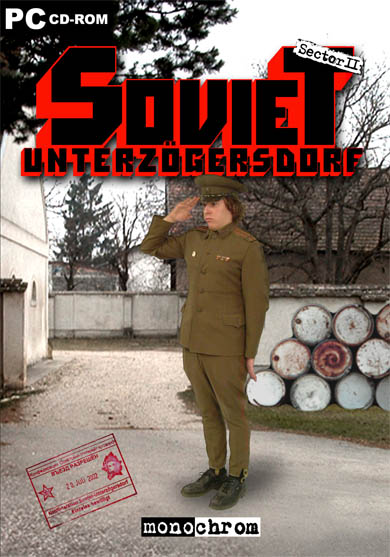
We transformed the theoretical concept into an improvisational theatre/performance/live action role-playing game that lasted two days. That means we really organized bus tours to Unterzoegersdorf — a small village that really exists — and acted the setting; beginning with the harsh EU Schengen border control. Later, in 2004, we started to think about a possible sequel to the performance. We thought that the cultural format of the “adventure game” provided the perfect media platform to communicate and improve the idea.
We started to work in February 2004 and presented ‘Sector 1’ — the first part of the trilogy — in the form of an exhibition in Graz/Austria in August 2005. We released ‘Sector 2’ in 2009, featuring guest stars as Cory Doctorow, Jello Biafra or Bruce Sterling. As the game series uses a 3rd person perspective with photo backgrounds and pictures of real actors as sprites, it took us quite a while to digitize and image process all of the material. This technique was actually first used by Sierra On-Line during the early and mid-1990s — but we are quite proud that we managed to get the feeling of discovering an old computer game that never existed on your old 500 MB hard drive. One aspect of the game is playing with memories and the future of the past. The future is a kind of carrot, the sort tied just in front of the cartoon donkey’s nose so it goes to work, goes off to war, learns Javascript and knows which bits to laugh at in Woody Allen’s Sleeper. You can imagine.
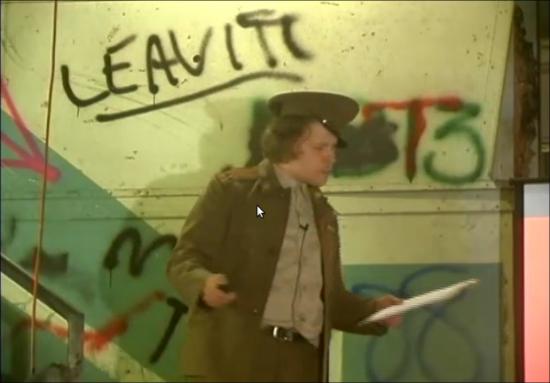
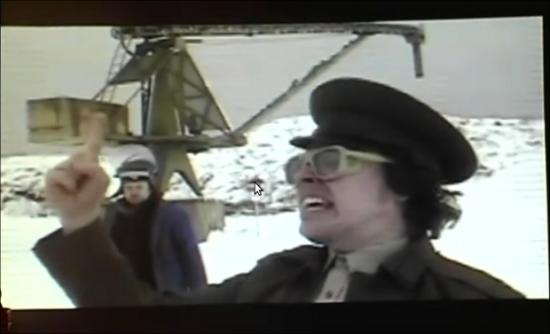
At a HOPE conference a few years back I was interested to hear you talk about the framing of the project as somehow deeply connected with a certain understanding of historiography that you and the other members of monochrom share. Could you elaborate on this a bit?
Debates triggered by postmodern culture have directed our attention towards questions of representation and the relevance of “history” and stories — i.e. The challenging proclamation of a post-histoire, the realization of the impossibility of a meta-narrative of history; the clash between reality and sign systems, the difference between fact and fiction, the impossibility of neutral contemplation or witnessing as well as the positioning of subjective awareness within such representations, etc. All these forms of representation have been playing a central part in the development of national, ethnic and tribal identities since WWII. And (as a by-product of military technology) computer game development is hardly aware of these discourses.
We wanted to combine (retro)gaming and (retro)politics and (crypto)humor to delve into this ongoing discourse. We wanted to harvest the wonderful aesthetic and historic qualities of adventure gaming. It is a commemoration and resurrection, and one more reminder that contemporary gaming (in its radical business-driven state-of-the-artness) should not dare to forget the (un)dead media of the past — or they will haunt them.
If you compare the status of the adventure game in the context of the economic growth of the computer game industry you could state that it is gone. Less than 1% of all computer games written are adventure games. Adventure games are nearly extinct… but only nearly. If media and media applications make it past their Golden Vaporware stage, they usually expand like giant fungi and then shrink back to some protective niche. They just all jostle around seeking a more perfect app.
For many people in the Soviet Unterzoegersdorf team, adventure games are part of their media socialization. For the computer industry it is one of the most successful gaming formats of the past. And for the feminist movement it is proof that a woman — I’m talking about Sierra On-Line’s Roberta Williams — was able to shape the form of a whole industry totally dominated by men.
Computer games are embedded in the cultural framework of technological developments. In the study of technological development and creativity, focusing attention on the failure, the error, the breakdown, the malfunction means opening the black box of technology. Studies have convincingly demonstrated that the widespread inability to understand technological artifacts as fabricated entities, as social and cultural phenomena, derives from the fact that in retrospect only those technologies that prove functional for a culture and can be integrated into everyday life are “left over.” However, the perception of what is functional, successful and useful is itself the product of social and cultural–and last but not least–political and economic processes. Selection processes and abandoned products and product forms are usually not discussed. According to Langdon Winner, there is a sense in which all technical activity contains an inherent tendency toward forgetfulness. Quote: “Is it not the point of all invention, technique, apparatus, and organization to have something and have it over with? (…) Technology, then allows us to ignore our own works. It is license to forget.”
Could you also perhaps talk about the choice of selecting the genre of an adventure game as the incarnation of this downtrodden republic. At the risk of being literal minded, is there any sense in which the existence of ‘Soviet Unterzoegersdorf’ as a kind of place that comes alive through players’ interactions with a program downloaded from the internet has anything to say to how you imagine being able to engage/critique/disrupt the idea of the nation-state?
We are postmodern leftists. A little bit melancholic… but you can count on us. We love to play with layers of consciousness and layers of layers of consciousness. On first view our project could be interpreted as a mock-up of the Soviet Union and the communist state structures that really existed. But, why on Earth do we need so many references to 1980s and 1990s metal music? Or Marvin Minsky? Or Negri? Or Austrian post-WWII history? Or geek adumbrations? Mocking the Soviet State would be much easier. In fact it’s about the wonderful clash between reality and sign systems, the impossibility of neutral contemplation or witnessing as well as the positioning of subjective awareness within such representations. The traditional humanists tend to see the whole philosophic aesthetic postmodern line of thought — from Judith Butler to Lyotard and Derrida — from the wrong angle. Okay, you can’t explain Sun Ra to a Green Day fan now, when he’s laying in the corner, piss-drunk and crooning “Anarchy”. But we think that the (radical) nature of postmodernism is often simply not grasped because people just copy it down into the conservative pattern of thinking which has been indoctrinated into us since the Enlightenment. Of course, on the other hand, it functions as a virus, and there’s nothing wrong with that.
Contemporary art — the field we are usually working in because there’s money — is mostly concerned with systems or systematic concepts. In the context of their work, artists adapt models of individual art-specific or economic or political systems like in a laboratory, to reveal the true nature of these systems by deconstructing them. So would it be fair to say that by their chameleon-like adaptation they are attempting to generate a similar system? Well… the corporate change in the art market has aged somewhat in the meantime and looks almost as old as the ‘New Economy’. Now even the last snotty brat has realized that all the hogwash about the creative industries, sponsoring, fund-raising, the whole load of bullshit about the beautiful new art enterprises, was not much more than the awful veneer on the stupid, crass fanfare of neo-liberal liberation teleology. What is the truth behind the shifting spheres of activity between computer graphics, web design and the rest of all those frequency-orientated nerd pursuits? A lonely business with other lonely people at their terminals. And in the meantime the other part of the corporate identity has incidentally wasted whole countries like Argentina or Iceland. That’s the real truth of the matter.
Read Part 2 of this Interview
http://www.furtherfield.org/features/interviews/interview-johannes-grenzfurthner-monochrom-part-2
Read Part 3 of this Interview
http://www.furtherfield.org/features/interviews/interview-johannes-grenzfurthner-monochrom-part-3
‘Living’ is the result of a six month residency at the V&A by Christian Kerrigan – from January to June 2010 – and it is part of The 200 Year Continuum. The 200 Year Continuum is the title of a project by the same artist that explores the relationship between nature and technology. Interestingly ‘Living’ was exhibited in the same space where it was created: in the digital studio of the V&A. This was a small room with dim light and crowded with rarities. It felt like one was penetrating the secretive and magical space of experimentation of some sort of mad professor.

Once in the space my gaze wandered around a series of oddities. On the right, a table full of raw materials; in the middle of the room, a fish tank with algae floating in high pH waters; on a wall, a real time video projection showing the evolution of the algae; on a different wall, a slide projection showing some drawings; in some shelves, notebooks with notes by the artist; above the sink, chemical products piled up on a shelf; and on each and every window a semi-transparent drawing. No explanations, no titles, nothing. It’s you and the objects. Luckily Christian Kerrigan was always about, meeting visitors and discussing the work. We started looking at the materials on the table. Christian told us those were unprocessed rocks and crystals that he used as the starting point for his drawings. He scanned pieces of amber, moss, fiber glass, volcanic rock or resin and produced a model using 3D software. Then he manipulated that model to create his drawings and printed them on semitransparent paper. He eventually placed them on the windows of the space. This routine allowed him to explore the different stages of a process that makes real matter and virtual space intermingled. It is a practice that explores where the process of creation begins, and what it does to reality. ”The drawings, he tells us, become extensions of the physical material which I started with.” Although we have become accustomed to discuss the hybridity of our nature-culture, the way Christian carefully interwove materialities and virtualities was very evocative. The fact that the drawings were placed on the windows gave yet another layer of complexity to the mixture. The colours of the printings morphed natural light into a hybrid light turning the atmosphere of the room into a creative and ongoing process.
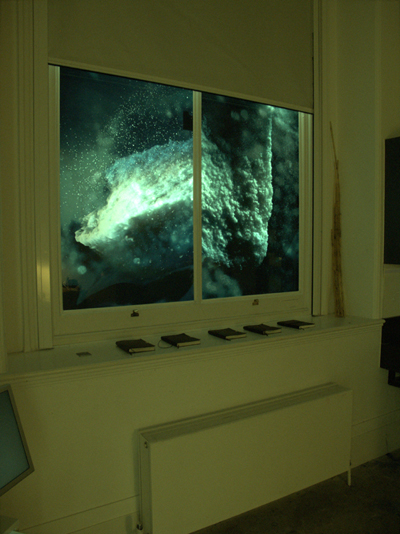
Next I wondered about that mysterious fish tank in the middle of the room where algae lived (and died) in high pH waters: Encased Nature. Apparently the algae reacted to the elevated pH creating a protective coat that eventually killed them. At the bottom of the tank: a graveyard of coated dead algae showed the consequences. I instantly loved the idea. Again an experiment about the hybridity of natural and controlled habitats. I thought it was a particularly dystopic illustration of the environment we inhabit where control works on the conditions of the environment, dictating the way reality unfolds. This is an emerging tendency in our most-discussed societies of control, what has come to be called soft control. And we could take it even further, and see it as a great illustration of today’s climate of fear. In such a habitat, the threat has become virtual and all-pervasive, it has become poisonous in itself, just like high pH. The nightmare of security measures that this artificially produced environment justifies links quite well to the ‘lethal-protective’ coat. What this allegory leaves out, though, is the power of imagination! The capacity of conditions to be turned around, the potential for intervention and deviation from the pre-programmed chain of (re)actions. The idea of projecting a live video recording on the wall was to intensify the experience and highlight the importance of mediation. As Christian argued, we are now more used to experience nature through a lens than to experience its presence. However, the quality of the footage seemed to work against the intentions of the artist and rather than intensifying the experience of that enclosed nature, it tended to obscure it. The particular texture that the webcam gave to the recordings turned that hybrid habitat almost into an abstract movie. On a different corner there was another video projection made out of a series of drawings. Interestingly they had been created using a ‘living technology’ and recorded at a nano-scale. For Living Drawing, the artist had collaborated with Martin Hanczyc from the Department of Physics and Chemistry at the University of Southern Denmark. They had manipulated some protocells that inhabited chemical gradients and reacted to ultraviolet light. When UV light was applied to the fiberglass where these protocells ‘lived’ their motion left traces of colour that were recorded. This technique, although still in its early stages, allowed the artist to ”explore the spontaneous event of drawing by using organic systems”, he told us. Kerrigan’s rather cryptic exhibition proved to be an inspiring and very personal exploration of the blurring between nature and culture in its absolute physicality. Paying particular attention to the materiality of the creative process, from the composition of the materials used, to the chemistry of the drawing process or to the laws of electromagnetism that inform light in its interaction with his work, his methodologies show a passion for unfolding reality in its many scales. His work is that of someone who’s starting to explore rather than someone who’s making an assertion; it is tentative rather than conclusive, it is interesting for its questions rather than its answers. However, even if sometimes vague, it is at points pleasingly dark and sometimes inspiringly intense.
Introduction:
As media attention wanes, the impact of British Petroleum’s Deep Horizon, off-shore drilling disaster continues to unfold. Artists worldwide respond to this new ecological catastrophe in a group show organized by Transnational Temps, an arts collective exploring the interstices of art, ecology and technology. For Andy Deck, one of the founding members of Transnational Temps and the curator of the show, “After a decidedly unsuccessful round of climate negotiations in Copenhagen, the disaster in the Gulf of Mexico frames this exhibition of Earth Art for the 21st Century.”
Now hidden from view by BP’s media campaigns and other de facto censoring actions, the images of oil-covered birds struggling to breathe and fly, oil and dispersant-coated fish, dolphins and whales washing up dead while most sink to the ocean floor, have all but vanished. Partially filling the void are the artists showing here who are recreating topographies: mapping the course of a deadly shadow over our shores and waters; and reinterpreting the sea, its rising levels and largesse, before the vicissitudes of man and nature. Transnational Temps.
———-
Spill >> Forward by Transnational Temps describes itself as an Online Exhibition. It is a website containing images and other media on the theme of oil spills. Some of the images were shown at the MediaNoche gallery from July 30th – November 19th, 2010, with works added or removed so it isn’t just an online catalogue of a meatspace show.
The front page of the site warns that you’ll need a browser that supports HTML5 video and audio, and states that you can view it using patent-free media codecs. From a Free Software and Free Culture point of view this is excellent, your ability to view the art is not restricted by anyone else’s technological or legal machinations. This is also good from an artistic point of view. The software used to view the art can be run and maintained by anyone, making it more accessible, exhibitable and archivable. But this freedom doesn’t extend into the work itself. some of the art uses proprietary software, and none is under a free Creative Commons licence.
The image on the front page, or possibly the image exhibited at the entrance to the exhibition, is not advanced HTML5 video or canvas tag animation but an animated GIF. A Muybridge-ish series of still images of a pelican in flight flickers rapidly up and down as it descends behind an iridescent oil slick that solarizes the bottom half of the image. It’s an effective image in itself, a visually and net.art-historically literate statement that also serves to set the stage for the rest of the show.
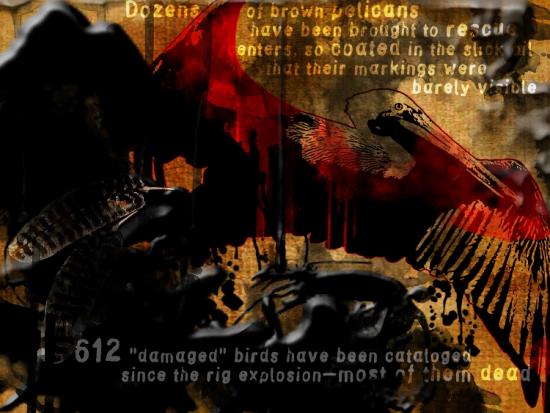
This is clearly a politically motivated exhibition, with the theme of the exhibited art centred on a specific historical event (the Deepwater Horizon disaster). Oil spill and petrol station imagery dominates . The resulting art varies from cooly ironic asethetics (Ubermorgen), photo and video journalism (Guillermo Hermosilla Cruzat, S.Slavick & Andrew E.Johnson, Chris Dascher, Adrian Madrid), agitprop (Eric Benson, Geoffrey Michael Krawczyk, Alyce Santoro, Russ Ritell, Terri Garland, Patrick Mathieu), photography(Jessica Eik, Sabina Anton Cardenal), painting(Jessie Mann), collage(Ume Remembers), performance art(Graham Bell), interactive multimedia (Gavin Baily, Tom Corby, Jonathan Mackenzie, Chris Basmajian, Matusa Barros, Mark Cooley), augmented reality (Mark Skwarek and Joseph Hocking) and drawing (Cristine Osuna Migueles, Adrienne Klein, Jesus Andres, Sereal Designers) to video and audio art (Irad Lee, Luke Munn, Gene Gort, Tim Geers, Gratuitous Art Films, Alex George, Collette Broeders, Fred Adam and Veronica Perales, Virginia Gonzalez, Henry Gwiazda, Maria-Gracia Donoso, Jeremy Newman).
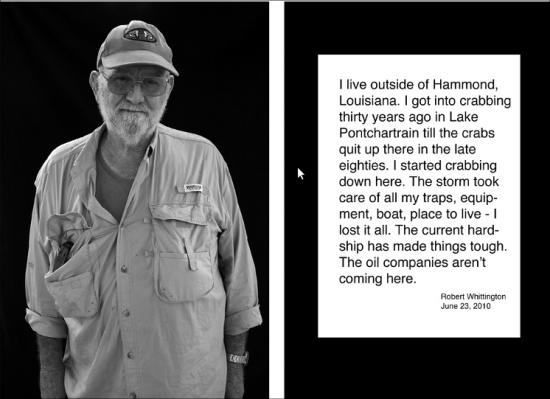
This is a lot to take in but the diversity of the work is a strength rather than a weakness, building a broad and visceral response to the Deepwater disaster. Verbal responses to the disaster from politicians seem unconvincingly nationalistic and corporate in comparison. It might seem hypocritical for artists to criticise the source of the energy that feeds us and allows us to make new media art. But we are trapped in that system, and we must be free to criticise it.
Politically inspired artworks have a difficult history, tending to be either bad politics or bad art. The art in Spill >> Forward is excellent, though. Some has a more direct message than others. Again the diversity of the exhibition plays a positive role here. The immediacy of the agitprop images doesn’t need art historical baggage to be effective, but that immediacy provides a social context for the more contemplative or abstract works. The more contemplative or abstract works don’t hammer home a simple political message but they provide an aesthetic context for the more direct images. They work very well together.
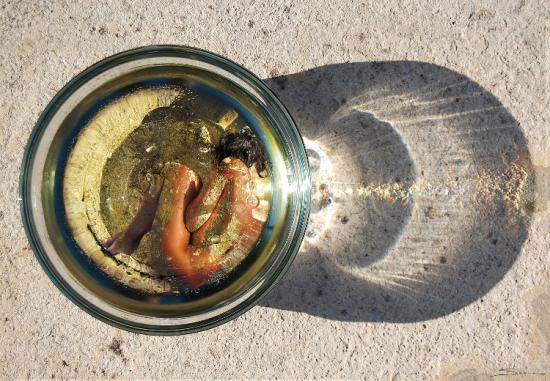
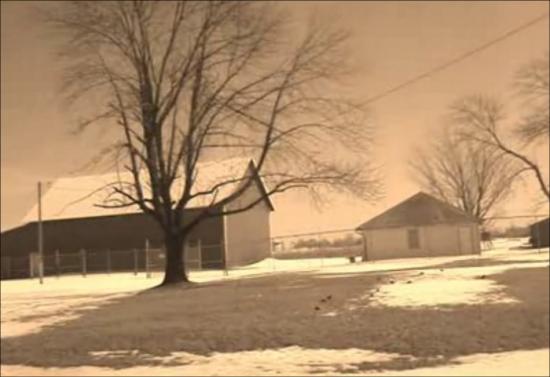
Some of the pieces in the show are clearly illustrations or recordings of work, some are electronic media that can be played on a computer, some are clearly designed to be experienced specifically through a computer system. If you removed the political theme of the show it would still be a visually (and audially) and conceptually rich cross-section of contemporary art. I was going to write “digital art” there but the show includes painting, drawing, performance, and other analogue or offline media recorded digitally for presentation online. The celestial jukebox is hungry.
If I had to pick out just a few pieces from the show I’d say that I was struck by the sounds of Luke Munn’s Deepwater Suite, by the visuals of Ubermorgen’s DEEPHORIZON, by the monochrome images and text of Terri Garland’s photography, by the video mash-up of Colette Broeders’ Breathe and by the critical camp of Graham Bell’s Radical Ecology. I think my favourite is Mark Skwarek and Joseph Hocking’s “The Leak in Your Home Town”, an iPhone app that uses the BP logo as an Augmented Reality marker to super-impose a 3D animation of the Deepwater leak over live video of your local BP petrol station. It is art that could only be made now, technologically, aesthetically and socially.
The aesthetic and conceptual competence of the artistic responses to the environmental and human crises of the oil spills in Spill >> Forward make the case for art still being a relevant and capable answer to society’s need to make sense of unfolding events. Art can still provide a much-needed space for reflection, and Spill >> Forward creates just such a space in a very contemporary way.
The text of this review is licenced under the Creative Commons BY-SA 3.0 Licence.
This regular live show highlights current activity and controversies around contemporary practices in art and technology, discussing events, exhibitions, debates and their social contexts with all manner of player and participant. Features include lively debate and interviews with artists, techies, writers and curators, interspersed with bleeding-edge music, some from Furthernoise.org, and a rolling programme of experimental creative adventures for your amusement.
First series hosted by Marc Garrett, artist, writer and co-founder of furtherfield.org with reviews and interviews by art historian & writer Charlotte Frost and Ruth Catlow artist co-founder of the furtherfield.org.
Second series hosted by Marc Garrett joined by Irini Papadimitriou & Jonathan Munro.In addition to Furtherfield’s invited guests this series will feature interviews with many of the 30 artists showing in the exibition of DIY, hacking and open source projects, Unleashed Devices as part of
NODE.London. Irini has worked with Jonathan Munro of TINT to curate the exhibition at Watermans.
The programme is part of ‘Hyperlink: Media Art Contexts’ whose principal aim is to present and promote high-quality contemporary media art work, alongside critical discussion of past, present and future media art in a contemporary art context.
HTTP Gallery is pleased to host LAB4 by Hedva Eltanani, an exploration of communication between two places using streaming media and web applications. It is another step in a series of LABs that explore digital technology and audience interaction. It is part of Heltanani’s research on digital performance and the way it affects audience experience.
LAB4 is a game that challenges the audience to bend the boundaries of space, interaction and intimacy. The two locations, HTTP Gallery in London and The Poly Centre in Falmouth, are linked via live-feed technology, using webcams and web applications. Eltanani will lead a series of activities, such as ‘truth or dare’, which challenges elements of group dynamics and technology – the aim is to engage the two audiences and help participants bond within each group.
How intimate will it go? The participants are invited to deepen the connection by keeping their community active using web applications.
BE PART OF THE EVENT IN LONDON
Doors open at 8:30pm
More info and documentation :
http://arthubfalmouth.blogspot.com/
http://vs4rslab.wordpress.com/
Featured image: People watching and being watched across virtual space
Ambient Information Systems
English, some texts in German. Translator: Nicholas Grindell
400 pages, 6-colour hardbound, 17.5 x 23 cm
edition of 1,500 unique & numbered.
now available at ambient.publishing.
ISBN-13: 978-0-9556245-0-6
Ambient Information Systems by Manu Luksch and Mukul Patel is a hardback book that presents writing, images and art by and about ambient.tv (Luksch and her collaborators) from during the last decade. Its purple and yellow cover tempered by a tracing paper slip-cover, contains almost four hundred pages of sans-serif text cleanly laid out among images and sidebars. As intermedia artists with a strong emphasis on research and dissemination. Recent works have addressed surveillance, corporate data harvesting, and the regulation of public space.
The material presented in the book ranges from written essays and project proposals through preparatory sketches, computer server log files and video screen grabs to modification of the printed book iteslf by unique rubber stamps and scribbling over sections of text. This diverse and detailed presentation of ambient.tv’s work provides an insight into the inspiration, planning and production of some conceptually and aesthetically rich new media art.
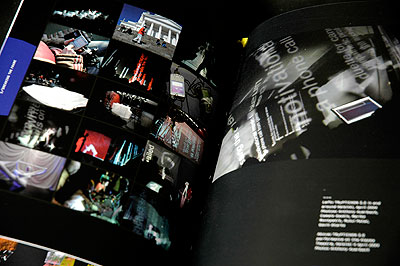
There’s a report from Kuwait during Ramadan 2002, a description of using cutting-edge wearable PCs, a discussion of the role of television, information about the harp in mythology, cyborg markets, the UK Data Protection Act, climate change, anti-gentrification, art and systems theory, UAVs, the Pacific plastic dead zone, and much, much more. There are projects that create free networks, dangerous musical instruments, taped-out surveillance camera boundaries, video installations, photographic images, movies of CCTV footage gained through freedom of information requests, manifestos, snowglobes, and cocktails.
(It’s a fascinating pleasure to read but it’s overwhelming to try and review.)
The portrait of Ambient.tv that emerges from all this is of intensive cultural critique pursued through a playful low-fi digital aesthetic. This isn’t a contradiction, the latter is in the service of the former. Ambient.tv’s projects and proposals tackle serious social and political issues. They do so through skilled use of the aesthetics and attitude of low-fi new media art and technological activism.
The wealth of ideas contained in the essays and other writing in the book show how historical, political and philosophical knowledge grounds the resulting art and indicates how it embodies a critique of contemporary culture.
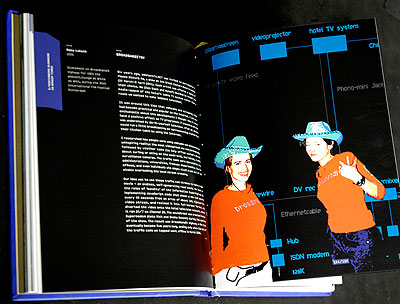
Contemporary culture as seen by Ambient.tv is surveillance culture, the database state with its DNA databases and laws that protect freedom by removing freedom. Ambient.tv is a realistic project, depicting the hidden forms of contemporary society that intrude into our lives. This is heavy stuff, and to air it critically without alienating the audience it requires precisely the playful touch that ambient.tv often bring to their art.
To take the example of FACELESS, 2007, (the first project I personally saw Luksch present), there is an exquisite balance between the disturbing idea of pervasive surveillance, the practical limitations of Freedom Of Information requests, and the visual and science-fictional narrative aesthetic that emerged from this. On their web site it states that it was produced “…under the rules of the Manifesto for CCTV Filmmakers. The manifesto states, amongst other things, that additional cameras are not permitted at filming locations, as the omnipresent existing video surveillance (CCTV) is already in operation.” The result is something more interesting and disturbing to watch than a simple collage of CCTV footage would be. The fact that the work can be made like this, that it can look like this, means something.
This strategy can be seen in “Mapping CCTV around Whitehall”, 2008, as well, which I also reviewed for Furtherfield here, and in many other pieces by Ambient TV.
Reading the proposals and essays shows the depth I suspected to this work, when I first saw it projected in a darkened room is there in its conception and execution.
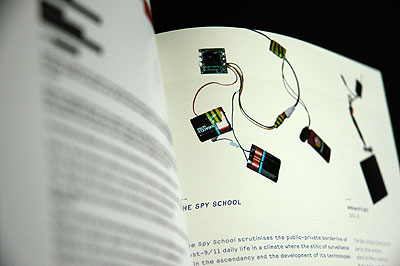
It’s an intense and inspiring experience to be faced with the textual equivalent of a decade-long open studio. The first essay in the book, a theory-laden piece by Fahim Amir, is almost overwhelming in a different way. It’s pure Theory, which will hopefully sell Ambient.tv to the artworld sectors that thrive on that sort of thing, but it isn’t the best introduction for newcomers to the project’s very accessible art.
But what a rare pleasure to be given such a wealth of insight into art that so acutely depicts our times. “Ambient Information Systems” is an important resource for contemporary artists and critics, an insight into the ideas and development of a very successful new media art practice. The grungey, playful, important realism of Ambient.tv’s work deserves presentation in a context that shows just what has gone into the art and just what people can get out of it. This is it.
The text of this review is licenced under the Creative Commons BY-SA 3.0 Licence.